

Blog Explained: All 15 Restricted Area Permits (RAPs) in Nepal for Trekkers, Cost Included
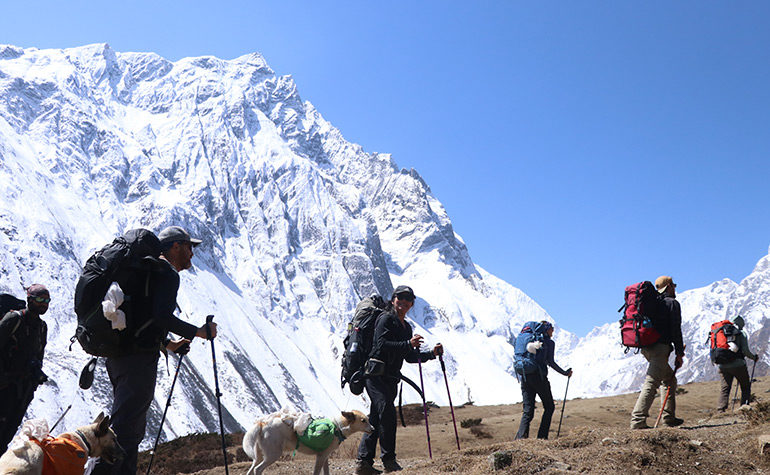
2 Mar 2022 Outdoor Himalayan
Blog-Explained: All 15 Restricted Area Permits (RAPs) in Nepal for Trekkers, Cost Included. Restricted Areas in Nepal are the regions in, which the Nepalese Government has given the utmost priority to the conservation of nature, culture, heritage, and other significant factors. There are certain limits to visiting these areas and Restricted Area Permits (RAPs) are issued to control as well as manage them. For any traveler looking for a unique experience in this nation a trip to one of the restricted areas through any means will be a wonderful experience. This article focuses on these regions, what they encompass, and the RAPs required to be there.
Most restricted areas in Nepal require at least a group of two people to apply for the permits. For trekkers, these might include the guide or other fellow travelers to that region. This rule is to better maintain the activities in these special regions and also for the safety of the visitors. As for where to apply for the permits, you can attain all these RAPs from the Department of Immigration Office in Kathmandu . No tourists can enter the RAPs with the special permits, even paying extra costs, and the permits can be issued only for the registered trekking agencies.
Restricted area permits are mandatory to legally travel, trek, tour, or explore these designated regions in Nepal. Make sure you make an extra copy of your RAPs alongside your other documents which will come in handy in case you lose the original. Similarly, you will have to show the permits at the checkpoints in different places as well as complete the entry/exit procedures. Make sure you know these posts will help you to complete your journey in Nepal without any hassle.
Here we have a detailed list of all the 15 restricted area permits in Nepal alongside the tentative cost for any visitors to get them.
1. Upper Mustang RAP
Required For: Upper Mustang Trek and Driving Tours
Upper Mustang is one of the most elusive regions in Nepal for any adventure-loving individual. It has been a prime bucket list entry for travelers. You would be required to have a dedicated permit to explore the Kingdom of Lo. The restricted area starts immediately from Kagbeni and there is the official checkpoint for your RAPs as well.
Restricted Parts :
- Lo Manthang Rural Municipality (Ward nos. 1 to 5 all areas)
- Lo-Gekar Damodar Kunda Rural Municipality (Ward nos. 1 to 5 all areas)
- Baragung Mukti chetra Rural Municipality (Ward nos. 3 all areas and Satang village of ward no 5)
Upper Mustang RAP Costs:
- USD 500 per person (10 days) + extra USD 50 per person per day (beyond 10 days)
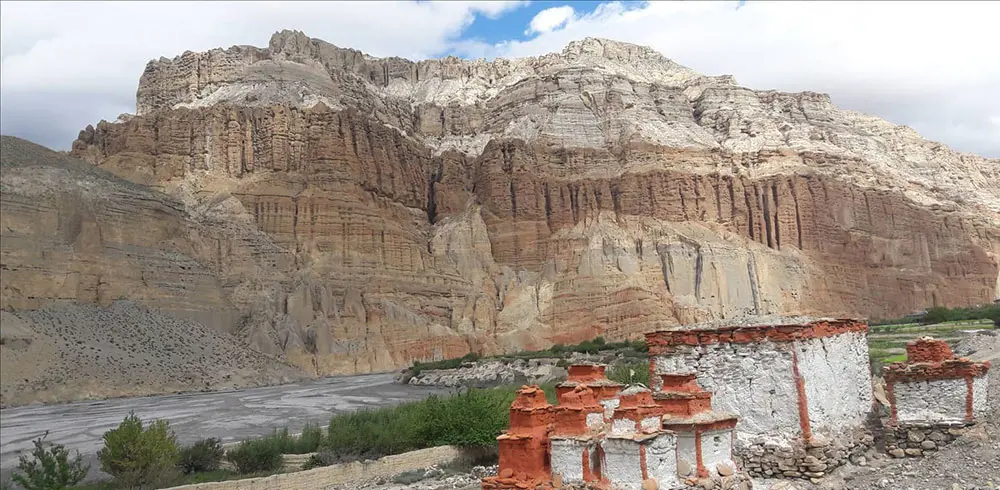
2. Manaslu Conservation Area RAP
Required For: Manaslu Circuit Trek, Manaslu Tsum Valley Trek
Manaslu region is known to have some of the best natural and cultural delights for visitors of the outside world. However, it does have two different restricted regions the first of which is the Manaslu CA. This region starts from Jagat and while doing the regular circuit you will be in it for over 5 days till you’ve reached Samagaon.
Restricted Parts:
- Tsumnubri Rural Municipality (Ward nos. 1 to 4 all areas )
Manaslu Conservation Area RAP Costs:
- USD 100 per person (7 days) + extra USD 15/person per day (beyond 7 days) [Sep-Nov]
- USD 75 per person (7 days) + extra USD 10/person per day (beyond 7 days) [Dec-Aug]
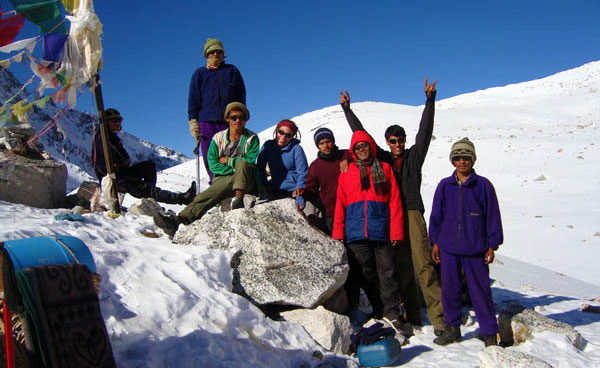
3. Lower Dolpo RAP
Required For: Lower Dolpo trek
Dolpo region lies in the district of Dolpa, the biggest district in Nepal. It is home to some of the best-preserved cultures and lifestyles you’ll see in the mid-western rural zones of Nepal. There are two distinct restricted areas here the first of which is the Lower Dolpo. As the name suggests, Lower Dolpo covers the lower region of the Dolpa district.
- Thuli Bheri municipality (Ward nos. 1 to 11 all areas)
- Tripurasundari municipality (Ward nos. 1 to 11 all areas)
- Dolpo Buddha Rural Municipality (Ward nos. 1 to 3 all areas)
- Shey Phoksundo Rural Municipality (Ward nos. 8 and 9 all areas)
- Jagdulla Rural Municipality (Ward nos. 1 to 6 all areas)
- Mudkechula Rural Municipality (Ward nos. 1 to 9 all areas)
- Kaike Rural Municipality (Ward nos. 1 to 7 all areas)
Lower Dolpo RAP Costs:
- USD 20 per person (7 days) + extra USD 5 per day (beyond 7 days)
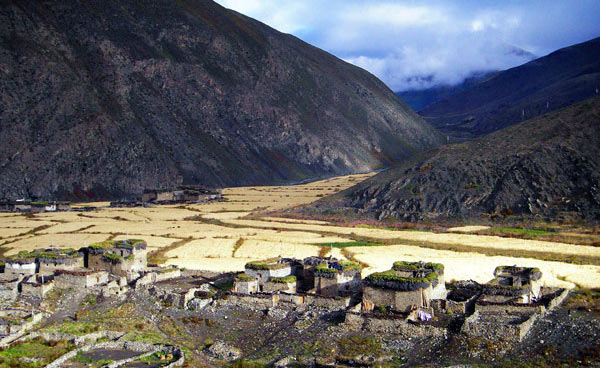
4. Upper Dolpo RAP
Required For: Upper Dolpo trek, Kang La Pass trek
The region of Upper Dolpa is one of the best-untouched paradises in the Nepalese Himalayas. This restricted area has a long history and scenic natural beauty that any adventure-loving traveler will admire. Upper Dolpo alongside the multiple passes is considered by many as the best value destination for off-the-beaten-track trekking in the world.
- Dolpo Buddha Rural Municipality (Ward nos. 4 to 6 all areas)
- Shey Phoksundo Rural Municipality (Ward nos. 1 to 7 all areas)
- Charka Tangsong Rural Municipality (Ward nos. 1 to 6 all areas)
Upper Dolpo RAP Costs:
- USD 500 per person (10 days) + extra USD 50 per day (beyond 10 days)
5. Humla Rural Municipality RAP
Required For: Simikot Limi Valley Trek
Humla District is one of the underrated destinations in Nepal which has in recent years gained a cult following among trekking operators. Similar to the alpine highlands of Switzerland and Italy, the Limi Valley section is amazing to travel and explore. The RAP of Humla will allow you to travel in all the Simikot, Changkheli, and Namkha Rural Municipalities here.
- Simikot Rural Municipality (Ward nos. 1, 6, and 7 all areas)
- Namkha Rural Municipality (Ward nos. 1 to 6 all areas)
- Changkheli Rural Municipality (Ward nos. 3 to 5 all areas)
Humla Rural Municipality Costs:
- USD 50 per person (7 days) + extra USD 10 per day (beyond 7 days)
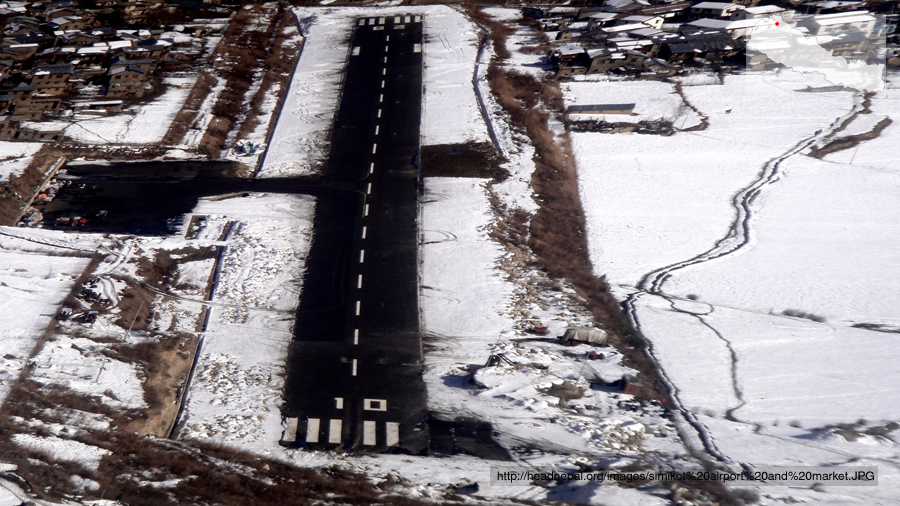
6. Rasuwa Gosaikunda RAP
Required For: Gosaikunda Lake Trek, Langtang Gosaikunda Helambu Trek
This permit is slightly different from the others in the list as it also encapsulates the religious (pilgrimage) factors in the destination. Gosaikunda Lake is one of the holiest places for Hindu and Buddhist devotees. Additionally, this region is also popular for the Tamang Heritage trail which is a wonderful experience for trekkers in Nepal.
- Gosaikunda Rural Municipality (Ward no.1 all areas and Ward no.2 some areas)
Rasuwa Gosaikunda RAP Costs:
- USD 20 per person per week
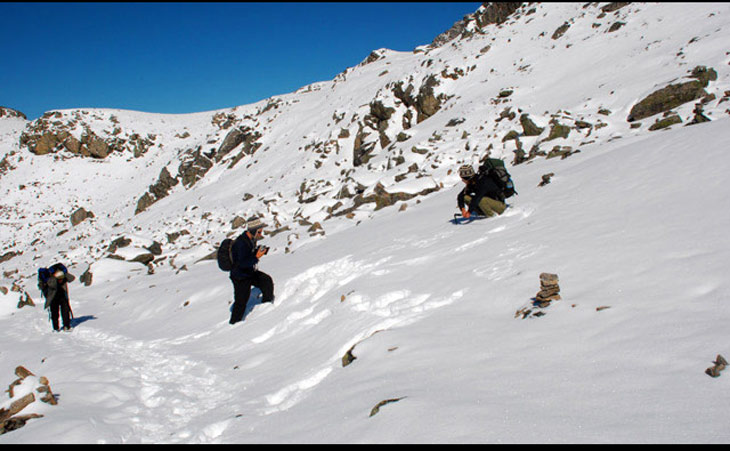
7. Solukhumbu RAP for Rural Municipality
Required For: Makalu Barun NP trek, Great Himalayan Trail
The Solukhumbu region is so much more than the regular Everest Base Camp areas. Travelers can enjoy an amazing blend of nature and culture while exploring the Khumbu area. This restricted area encompasses the areas of Bhotikhola and Makalu rural municipality.
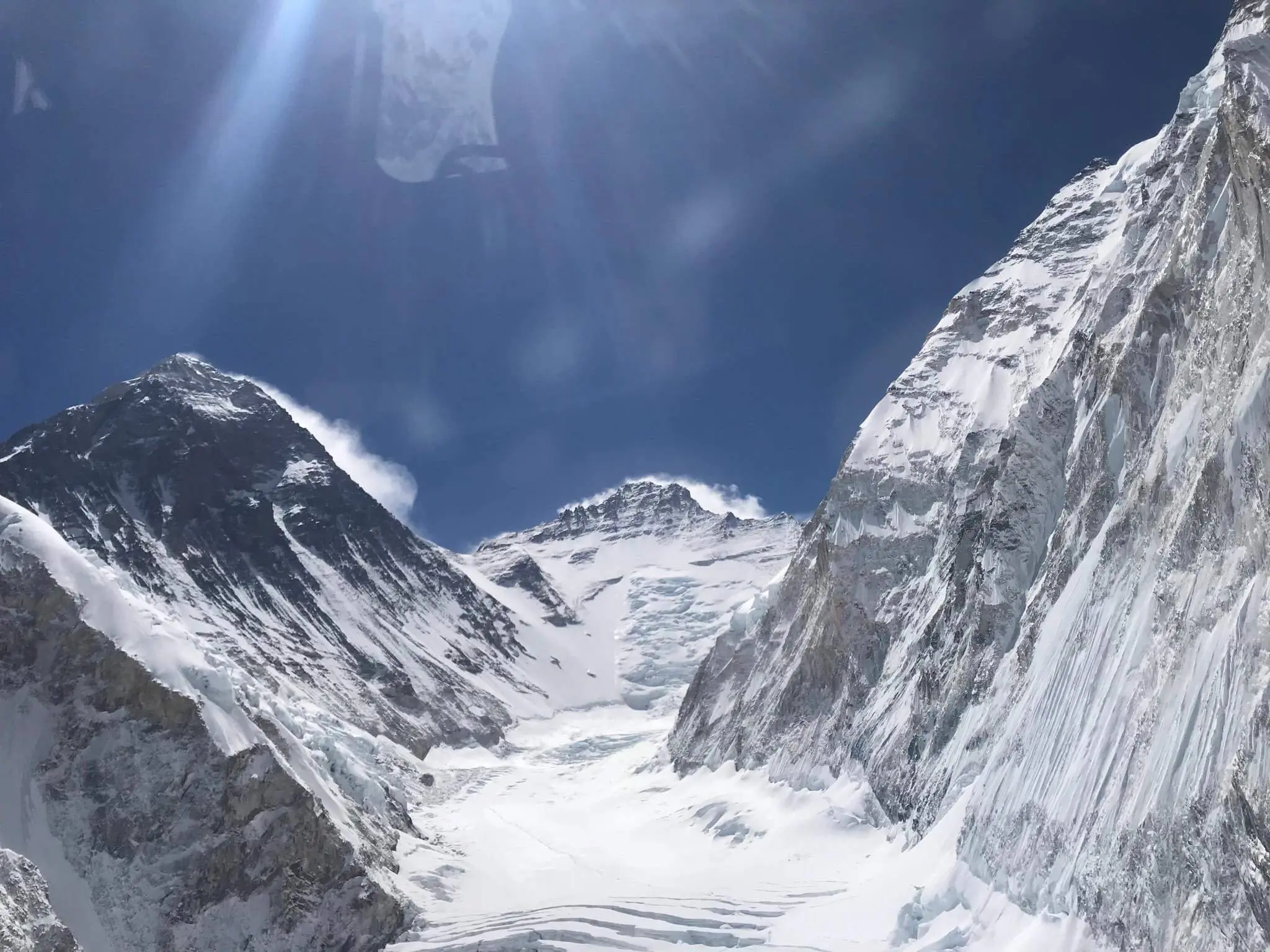
- Khumbu Pasang Lhamu Rural Municipality (Ward no. 5 all areas)
Solukhumbu Rural Municipality RAP Costs :
- USD 20 per person (first 4 weeks) + extra USD 25 per week (beyond 4 weeks)
8. Makalu Region RAP, Sankhuwasabha District
Required For: Makalu Base Camp trek, Barun Valley Trek
Makalu region is situated beautifully between the Everest and Kanchenjunga massifs with promising experiences for travelers. The restricted area is located inside the Makalu Barun National park and more importantly the Kimathanka, Chepuwa, Hatiya, and Pawakhola villages. It is also a prime location for wildlife photography.
- Bhot Khola Rural Municipality (Ward nos. 1 to 5 all areas)
- Makalu Rural Municipality (Ward no. 4 all areas)
Sankhuwasabha Makalu Region RAP Costs:
- USD 10 per person (first 4 weeks) + extra USD 20 per week (beyond 4 weeks)
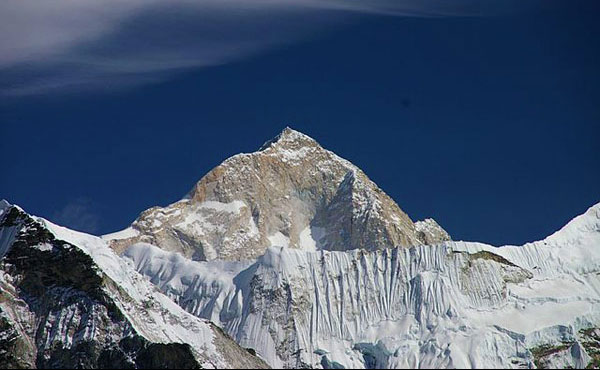
9. Manang Nar Phu region RAP
Required For: Nar Phu Valley Trek, Kang La Pass Trek
The Nar Phu region provides the perfect off-the-beaten-track experience for travelers in the otherwise popular Annapurna Region. Leaving the main track the trail leads trekkers to the traditional villages of Nar and Phu with historical, traditional, and cultural significance. This trek is considered by many as a well-conserved counterpart to the Upper Dolpo in western Nepal.
- Narpa Rural Municipality (Ward nos. 1 to 5 all areas)
- Nasho Rural Municipality (Ward nos. 6, and 7 all areas)
Manang Nar Phu RAP Costs:
10. Gorkha Tsum Valley RAP
Required For: Tsum Valley Trek, Manaslu Tsum Valley Trek
Tsum Valley and especially the traditional villages here is a gem of a location frozen in time and yet untouched by Western trends and modernization. It is no surprise that the Nepalese Government has put a major emphasis on preserving the ancient lifestyle, tradition, culture, and monuments here. The area of Sirdibas, Lokpa, Chumling, Nile, Chekampar, and Chule alongside the Tsumnubri rural municipality is only accessible with a permit.
- Sirdibas-Lokpa-Chumling-Chekampar-Nile-Chule
- Tsumnubri Rural Municipality (Ward nos. 3, 6, and 7 all areas)
Gorkha Tsum Valley RAP Costs:
- USD 40 per person (7 days) + extra USD 7/person per day (beyond 7 days) [Sep-Nov]
- USD 30 per person (7 days) + extra USD 7/person per day (beyond 7 days) [Dec-Aug]
These were the major restricted areas in Nepal where travelers frequently choose to experience something special. Apart from these, there are five more restricted areas in Nepal covering the rural municipalities around the country. Let’s cover them briefly as well including cost.
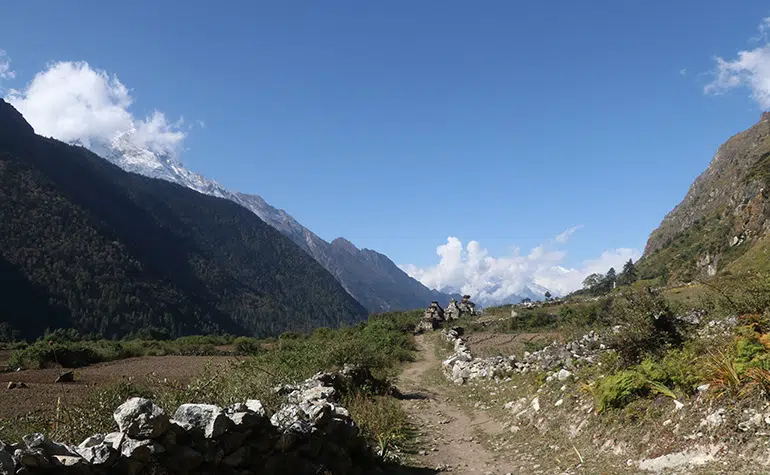
11. Taplejung Rural Municipality RAP
Required For: Traveling in Phantanglung, Mikwakhola, and Sirijunga Rural Municipalities
T aplejung Rural Municipality RAP Costs:
- USD 20 per week (first 4 weeks) + extra USD 25 per week (beyond 4 weeks)
12. Dolakha Rural Municipality RAP
Required For: Traveling in Gaurishankar and Bighu Rural Municipalities
Dolakha Rural Municipality RAP Costs:
13. Mugu Rural Muncipality RAP
Required For: Exploring Muguma Karmarong Rural Municipality
Mugu Rural Municipality RAP Costs:
- USD 100 per person (7 days) + extra USD 15 per day (beyond 7 days)
14. Bajhang RAP
Required For: Saipal Rural Municipality
Bajhang RAP Costs:
- USD 90 per person (7 days) + extra USD 15 per day (beyond 7 days)
15. Darchula RAP
Required For: Api Nampa Trek, Vyas Rural Municipality
Darchula RAP Costs:
Some Tips/Guidelines for trekkers trekking in the restricted regions
- Respect the local culture, tradition, and norms.
- Consult with your guide or ask permission from the locals before entering the monasteries, temples, palaces, or taking pictures.
- Don’t wander off on your own as individual trekking is prohibited in restricted areas.
- Appropriate travel insurance is highly suggested covering the duration of your trek/tour.
- Stick to your itinerary and route. These permits have the approved route for you to follow.
- You will need these permits even if your primary destination doesn’t fall in here.
- Follow the conservation area/national Park/rural municipality rules if you are exploring inside it.
Getting your restricted area permit is simple and shouldn’t take more than an hour to get approved. Be a responsible visitor while here and take nothing but memories from these beautiful places. Restricted areas in Nepal promise some authentic experiences and adventures so don’t miss out on these while you are in this country. Feel free to leave your questions with us and OHT experts will answer them personally.
Updated: Dec 10, 2023
TAGS: All 15 Restricted Area Permits (RAPs) in Nepal for Trekkers annapurna region Bajhang Dolakha Dolpo Region Everest region Humla Region Langtang region Manaslu region RAPs Restricted Area Permits Trekkers Upper Mustang Upper Mustang RAP
Nepal Govt. Reged. number: 39829/2005
Tourism License number: 805/2005
VAT/TAX Number: 302385791

Gokyo Treks Nepal
Nepal Trekking Agency
From 2015 - 2024 contineously
+977 9841 249 988
Restricted Area Trek
Home » Restricted Area Trek
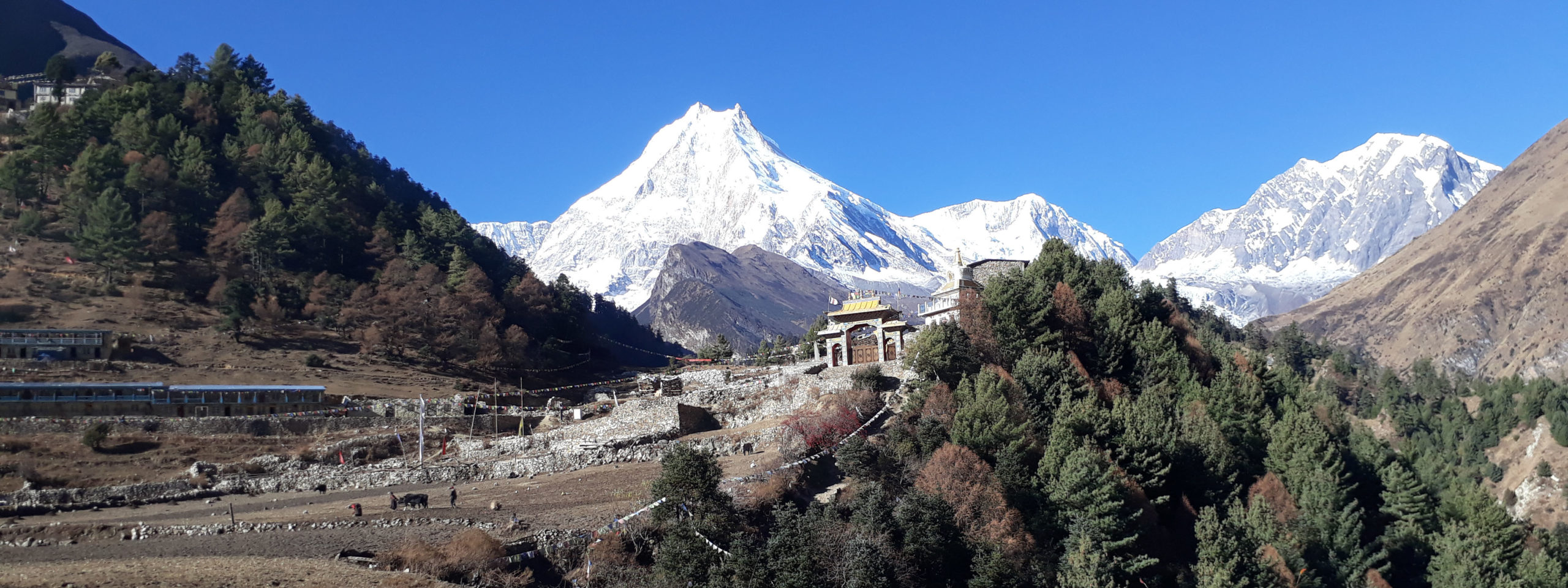
A restricted area trek refers to a trekking experience in a specific region of a country that is subject to special permits and regulations. These areas are often remote, less explore, and have unique cultural or environmental significance.
Restricted area treks provide adventurous travelers with the opportunity to explore off-the-beaten-path locations and immerse themselves in untouched natural beauty and indigenous cultures. These treks require obtaining special permits, traveling with register guides, and adhering to specific guidelines to ensure the preservation of the region and the safety of trekkers.
Nepal is a fantastic destination for trekking enthusiasts, offering a wide range of trekking options, including some restrict areas that require special permits. These special areas provide unique and off-the-beaten-path experiences for adventurous travelers. Here are a few popular restricted area treks in Nepal:
Upper Mustang Trek:
Located in the rain-shadow region of the Annapurna range, the Upper Mustang region offers a captivating blend of natural beauty and Tibetan culture. Trekking in this area requires a special permit, as it was once a forbidden kingdom. The landscape is characterized by barren valleys, ancient caves, and stunning rock formations.
Manaslu Circuit Trek:
This trek takes you around Mount Manaslu, the eighth highest peak in the world. The trail passes through remote villages, lush forests, glacial valleys, and high mountain passes. A restricted area permit is required for this trek, as it explores the culturally significant Nubry Valley and requires crossing the challenging Larke Pass .
Tsum Valley Trekking in Nepal
Tsum valley is a popular trekking destination in Nepal for several reasons. Firstly, it offers a unique cultural experience. The valley is home to the Tsumba people, who have their own distinct language, traditions, and lifestyle. The Tsumba culture is deeply rooted in Tibetan Buddhism, and trekkers have the opportunity to visit ancient monasteries, interact with friendly locals, and witness their religious ceremonies.
Secondly, Tsum Valley boasts stunning natural beauty. The trek takes you through picturesque landscapes, including lush forests, terraced fields, and towering Himalayan peaks. The valley is nestled between the Ganesh Himal and Sringi Himal ranges, providing breathtaking panoramic views throughout the journey.
Lastly, the recent opening of Tsum Valley for tourism has generated curiosity and interest among trekkers. Until 2008, the region was restricted, making it inaccessible to tourists. The sense of exclusivity and the opportunity to explore a relatively unexplored area have attracted many trekkers to venture into the Tsum Valley.
Nar and Phu Trekking in Nepal
The main reason for the restricted status is to protect the unique culture, traditions, and natural environment of the region. The Nar Phu valleys are home to ethnic Tibetan communities that have preserved their ancient way of life for centuries. The restricted access helps maintain their cultural integrity and prevent the negative impacts of mass tourism.
Furthermore, the area’s proximity to the Tibetan border raises security concerns. Nepal shares a sensitive border with China, and restrictions are in place to ensure the safety and sovereignty of the region.
While the permit requirement and restricted status may add some logistical challenges, it also contributes to the allure and exclusivity of the Nar Phu trek , attracting adventure seekers looking for off-the-beaten-path experiences and cultural immersion.
Kanchenjunga Base Camp Trek:
Mount Kanchenjunga is the third highest peak globally and offers a mesmerizing trekking experience in eastern Nepal. This region is less crowds and rich in biodiversity. Kanchanjunga Trekking requires a special permit and takes you through dense forests, terrace fields, remote villages, and stunning alpine landscapes.
Dolpo Trek:
Dolpo, located in the western part of Nepal, is a remote and culturally distinct region. Trekking in Dolpo takes you through Shey-Phoksundo National Park, which is renowned for its stunning turquoise lake, Phoksundo. The area is known for its unique Bon culture and Tibetan Buddhist traditions. A restricted area permit is required for Dolpo trek also.
Humla and Simikot Trek:
Humla and Simikot are regions in western Nepal that were previously designated as restricted areas for trekking. These areas have recently been opened up for tourism, allowing trekkers to explore their stunning landscapes and unique cultural heritage.
Humla, is in the far northwest of Nepal, is known for its remote and rugged terrain. It is home to the Limi Valley , which offers breathtaking views of snow-capped mountains, pristine lakes, and traditional Tibetan villages. The region showcases a blend of Tibetan and Nepali cultures, with monasteries, ancient caves, and traditional practices adding to its charm.
Simikot to Hilsa trek:
It’s an adventurous and remote trekking route in western Nepal, near the border with Tibet (China). It is part of the Great Himalayan Trail and offers a unique opportunity to explore the pristine landscapes and cultural treasures of the region.
Hike to Hilsa starts from Simikot, the administrative headquarters of Humla District, and follows a challenging trail through rugged terrain, deep river valleys, and high mountain passes. One of the highlights of this trek is crossing the Nara La Pass at an altitude of around 4,620 meters, which offers panoramic views of the surrounding peaks and valleys.
Journey to Hilsa from Simikot also takes you along the sacred Karnali River, and you may encounter nomadic herders and remote communities along the way. Additionally, trekkers traverse through picturesque villages, terraced fields, dense forests, and barren landscapes, experiencing the diverse beauty of the area.
It’s important to note that restricted area treks often have additional requirements, such as traveling with a registered guide and a minimum group size. These measures are in place to ensure the safety and preservation of the region.
Before embarking on any control area trek, it is advisable to gather up-to-date information and consult with a local trekking agency or the Department of Immigration in Nepal to understand the permit requirements, regulations, and current trekking conditions.
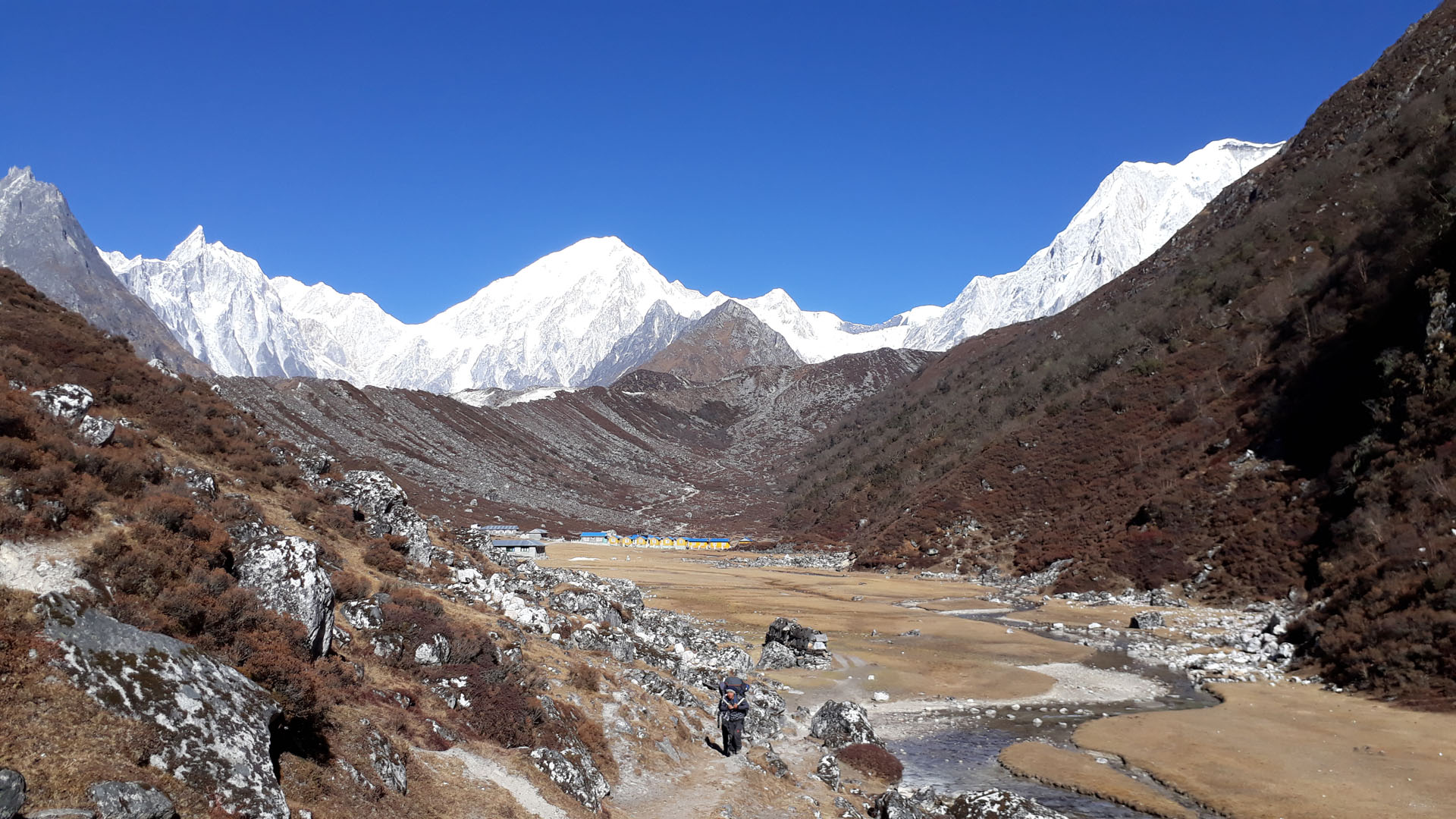
Reasons to keep keep some places as a Restricted Area in Nepal
The Nepal Government designates certain areas as restriction for trekking due to various reasons. Here are a few common reasons behind the decision:
Preservation of culture and heritage:
Restricted areas often have unique cultural significance and are home to indigenous communities with distinct traditions and lifestyles. The government aims to protect and preserve their cultural heritage by limiting access and ensuring that the local way of life remains undisturbed.
Environmental conservation:
Some areas encompass fragile ecosystems, rare flora and fauna, or sensitive ecological zones. By restricting access, the government aims to minimize human impact and maintain the pristine condition of these areas, promoting sustainable tourism and conservation efforts.
Security concerns:
In certain border regions or areas with political sensitivity, restricting access helps maintain national security and sovereignty. It ensures that unauthorize individuals or activities do not compromise the safety and integrity of the region.
Promoting control tourism:
By designating areas as control, the government aims to control tourist flow and prevent overcrowding. This approach helps protect the natural environment, manage infrastructure and resources, and provide a higher quality experience for trekkers.
In general, the decision to keep some places as restricted area treks in Nepal is a strategic approach to balance tourism, preservation, cultural respect, and environmental sustainability.
How to get a restrict area permit in Nepal?
Anyone willing to enter the restricted area in Nepal, go through Gokyo Treks and Expedition agency. You must get a restrict area trek permit through the department of the immigration office in Nepal. In addition, you also needs the national park and conservation office permit which you get either from the Nepal Tourism Board or through the Gokyo trek company.
Every trekker must have those permits before you go otherwise a double value of permit cost will be charged as a penalty. If you do not want to bother about the special permits and arrangements for the trip, we help you all.
We arranges the online trekking permit through a series of applications and guarantee letters. You cannot trek alone, Thus, you need a minimum of 2 foreigners to apply for trek permits together. We need a valid passport with a valid visa to get permits.
As you go into the remote areas, there are no Lodges along with the journey. Therefore, Gokyo Treks & Expedition a Trekking agency in Nepal arranges everything you need for your holiday in the best way with all the necessary gears such as Tents, Support staff, Tents, mattresses, pillows, food, cooks…etc. Compared to normal treks, hike into the control areas is more costly in terms of additional crew taking from town.
- [email protected]
- +977 9841161593
- +977 9851149890

- You are here:
- Trekking and Hiking
Complete guide to Restricted Areas and required permit fees in Nepal
All about restricted areas and the required permit fees in Nepal
- Updated on Mar 22, 2024
A Complete Guide To Restricted Areas and the Required Permits in Nepal
Notice: Nepal bans solo trekking for foreigners, coming into effect from 1st April 2023
Trekking in Nepal is a popular adventure activity from low altitudes to high all with splendid views of the hills and Himalayas. Trekkers can choose the trail according to their interest, physical fitness level and time frame.
Normally, trekkers in Nepal are allowed to trek as Free Individual Trekkers (FIT) or in a group of different sizes. However, there are some trekking areas in Nepal known as ‘Restricted Areas’ which are highly monitored and regulated by the government of Nepal and hence Free Individual Trekkers are forbidden to trek.
Trekking into these restricted areas required Special Permits, which are known as Restricted Areas Permits (RIP). These permits can only be obtained from the Department of Immigration in Kathmandu through an authorized trekking agency (only).
If you are interested in restricted areas trekking in Nepal, make sure you contact an authorized trekking agency registered in Nepal, like Discover Altitude . If so, then the agency can apply for restricted area permits on behalf of the trekkers (foreign nationals).
Any individual despite of his or her nationality doesn’t guarantee of obtaining Restricted Area Permits unless he/she applies through the registered trekking agency in Nepal, under different government departments.
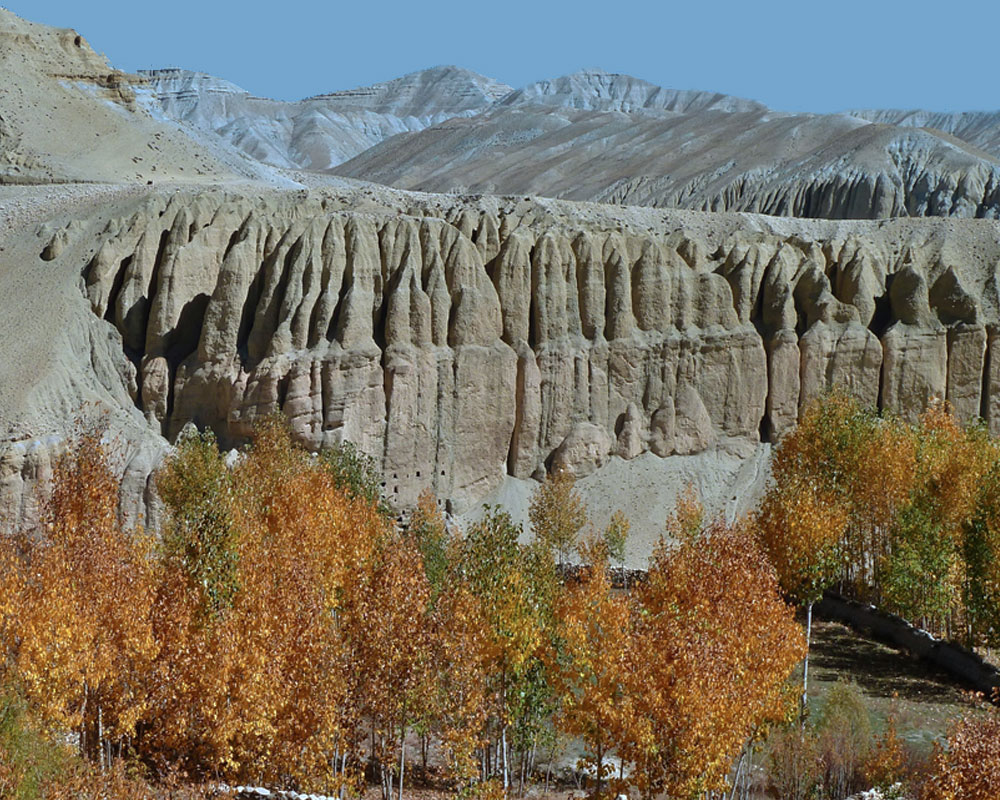
Table of Contents
What is a restricted area in nepal.
Nepal is blended richly with nature and culture, there are numerous Himalayas, national parks, conservation areas and diverse settlements of humans. All of these make Nepal, once is not enough to visit.
Trekkers can visit any part of Nepal, as the country is open to all foreign nationals. However, there are some areas which are regarded as restricted areas in Nepal for foreign nationals.
Until October 1991, many areas of Nepal bordering Tibet were declared restricted zone forbidden for foreign nationals to enter but now it is open for all but with Special Permit.
Lots of travellers question, why some areas in Nepal are restricted for travellers. The simple answer is for the safety and security of the trekkers.
Mainly, restricted areas are to the high altitude bordering Tibet. In these areas, human settlement is very low and the trail is not busy, thus it is regarded as a risky zone for free individual travellers.
Another possible reason is to stop illicit activities of travellers entering the remote parts of Nepal bordering Tibet controlled by China.
So, with strict provisions trekkers can visit restricted areas through authorized trekking agencies in Nepal, like Discover Altitude .
Who Needs to obtain Restricted Areas Permit in Nepal?
Foreign nationals need Restricted Areas Permit (RAP) while visiting those areas like Upper Mustang , Manaslu , Tsum Valley etc. These RAP permits cost extra and can only be obtained from the Department of Immigration in Kathmandu, through an authorized trekking agency.
there are numerous popular trekking trails like Everest Region Trek , Annapurna Region Trek , Langtang Region Trek etc where trekkers can trek as Free Individual Trekkers (FIT), without a guide or agency upon paying the entrance fee of conservation areas only, which can be easily obtained in the office at Nepal Tourism Board, Kathmandu or Pokhara.
From where can we obtain Restricted Area Permits (RAP) in Nepal?
Restricted Area Trekking Permits can only be obtained from the Department of Immigration, through an authorized trekking agency like Discover Altitude registered in Nepal.
However, the RAP Trekking Fees vary from area to area, the number of days/week and also the season of the year, and the bottom-line requirement for obtaining RAP permits is, that there must be at least 2 trekkers for the trek.
Conditions apply to the trekking agency in Nepal for obtaining a Restricted Area Permit:
Apply through the online application forms
- Name list of all trekkers
- Copy of trekkers passport (must)
- Trekking Itinerary of that particularly restricted areas
- Copy of valid visa for Nepal visit covering numbers of required days for Restricted Area Treks
- Guarantee letters of Trekking Agency
- Trekkers' agreement with the agency
- Tax Clearance certificate of the Trekking Agency
- All insurance documents of the trekkers (foreign nationals) and Nepali trekking staff accompanying the trekkers.
- Trekking Agency license issued by ‘The Ministry of Tourism.
- A license issued to Trekking Agency by The Nepal Rastra Bank to exchange foreign currency
- Certificate of Permanent Account Number (PAN) of Trekking Agency
- Voucher of Bank Payment related to fees of Restricted Area Permit
Do’s and Don’t by Trekkers in Restricted Areas:
Trekkers must respect local culture, customs and traditions.
Individual Trekkers are strictly forbidden to enter restricted areas, there should be at least 2 trekkers (group) while trekking in restricted areas
Restricted Areas Permits (RIP) must be carried while trekking.
Trekkers should be accompanied by a registered trekking guide and/or Porter.
Trekkers and accompanying Nepali staff must have accidental travel insurance.
Trekkers must follow the confined trekking route as disclosed during obtaining a Restricted Areas Permit, they cannot divert or change their route.
Trekkers must agree with the instruction given by authorized officers in the restricted areas.
There are 15 Restricted Areas in Nepal and the required fees are as followed:
Restricted Areas in Nepal
Required permit fees, upper mustang (mustang).
USD 500 Per Person (for the first 10 days)
USD 50 Per Person/Per Day (beyond 10 days)
Tsum Valley Areas (Gorkha)
September-november.
- USD 40 per person/week
- USD 7 per person/day
- (beyond 1 week)
December-August
- USD 30 per person/week
Manaslu Areas (Gorkha)
- USD 100 per person/week
- USD 15 per person/day
- USD 75 per person/week
- USD 10 per person/day
- (beyond 1 week)
Gosaikunda Municipality (Rasuwa)
- USD 20 per person/week
Nar and Phu Trek (Manang)
Khumbu pasang lahmu rural municipality ward no. 5 (solukhumbu).
- USD 20 per person for 4 weeks
- USD 25 per person beyond 4 weeks
Upper Dolpa
- USD 500 per person (for the first 10 days)
- USD 50 per person/day (beyond 10 days)
Lower Dolpa
- USD 5 per person/day (beyond 1 week)
- USD 50 per person/week
- USD 10 per person/day (beyond 1 week)
- USD 20 per person/week (for the first 4 weeks)
- USD 25 per person/week (beyond 4 weeks)
- USD 90 per person/week
- USD 15 per person/ day (beyond 1 week)
Sankhuwasabha
- USD 90 per person/week for the first week
- USD 15 per person/day (beyond 1 week)
Note : Free Individual Trekkers, either single or in a group cannot obtain a RAP permit unless they are applied through a Registered Trekking Agency in Nepal and have a guide to accompany them throughout the restricted areas.
For more information: WhatsApp: +977-9841161593
- Hiking permit
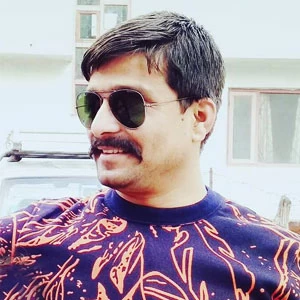
Kumar Lamsal
Kumar is one of the Co-founders and Managing directors of Discover Altitude holding 18 years of experience in the tourism sector of Nepal. He has trekked to almost all the popular regions of Nepal and is an authorized trekking and tour guide.
Started his career as a porter to support his study, now holds MPhil and LLB degree, and is doing his Ph.D. in religious studies. He loves traveling to the Himalayas and has deep knowledge about religion, culture, and history.
Kumar is also involved in the teaching sector as a part-timer to deliver his research related to the cultural and religious diversity of Nepal and is the one who mostly answers your queries giving them his personal touch through his decade-long experience.
Send us your feedback
Recent posts.
- Ghorepani Poonhill Trek Distance, Elevation and Weather
- Everest Base Camp Trek in February 2024-2025
- Everest Base Camp Trek Altitude With Oxygen Level | Know your minimum Oxygen Level during EBC Trek
- Hire a Guide and Porter while Trekking in Nepal | Guide and Porter Cost 2024-2025
- Best Trekking Company and Tour Operator in Nepal
- Everest Base Camp Trek in August 2024-2025
Related Posts
- A Complete Visa Guide to Nepal and Fees
- Muktinath Darshan Tour Package
- Lukla Airport: A gate-way to Everest region in a fastest way
- When and where will Mount Everest Base Camp be shifted | Nepal to Relocate Everest Base Camp
- Best 10 Luxury Tours and Holiday Package in Nepal
- Festivals in Nepal
- News and Events
- Places to See
We use cookies to ensure that we give you the best experience on our website.

- Everest Base Camp Trek - 12 Days
- Everest Base Camp Trek
- Everest Base Camp Trek - 14 Days
- Everest Base Camp Trek 9 Days
- Gokyo Lake Trek - 12 Days
- Shivalaya To Everest Base Camp Trek
- Phaplu To Everest Base Camp Trek
- Everest View Trek - 5 Days
- Tengboche Monastery Trek - 9 Days
- Solo Everest Base Camp Trek
- Everest 3 High passes Trek - 19 Days
- Everest Base Camp Via Gokyo Lakes Trek
- Annapurna Base Camp Trek Solo
- Mohare Danda Trek - 8 Days
- Jomsom Muktinath Trek
- Tilicho Lake Via Annapurna Thorong La Pass Trek
- Khopra Danda Trek From Pokhara
- Mardi Himal Trek From Pokhara
- Ghorepani Poon Hill Trek - 7 Days
- Annapurna Circuit Trek Solo
- Annapurna Thorong La Pass Trek With Local Trekking Guide
- Annapurna Base Camp Trek - 10 Days
- Annapurna Circuit Trek - 13 Days
- Langtang Gosaikunda Helambu Trek
- Tamang Heritage Trail Trek - 8 Days
- Gosaikunda Lake Trek 5/6 Days
- Helambu Circuit Trek - 7 Days
- Langtang Valley Trek Solo
- Langtang Gosaikunda Pass Trek - 16 Days
- Langtang Gosaikunda Short Trek
- Langtang Valley Trek - 7 Days
- Langtang Valley Trek - 8 Days
- Manaslu And Annapurna Circuit Trek
- Manaslu Tsum valley Trekking - 22 Days
- Tsum Valley Trek - 12 Days
- Manaslu Base Camp Larke La Pass Trek
- Manaslu Circuit Trek - 12 Days
- Manaslu Trek - 16 Days
- Nar Phu Valley Via Annapurna circuit trek
- Nar Phu Valley Trek Solo - 10 Days
- Nar Phu Valley Trek
- Ruby Valley Ganesh Kunda Lake Trek
- Local Trekking Guide Service For Upper Mustang Trek
- Upper Mustang Valley Trekking
- Upper Mustang Trek
- Changu Narayan Nagarkot Day Hiking Trip
- Nagarkot Sunrise View Tour From kathmandu
- Local Culture Tour In Nepal
- Kathmandu Valley Sightseeing Tour
- Volunteer Tour In Nepal
- Mera Peak Climbing
- Paldor Peak Climbing
- Tent Peak Climbing
- Island Peak Climbing
- Yala Peak Climbing
- Best Season
- Acute Mountain Sickness
- Frequently Asked Questions
- Nepal At Glance
- Trekking Equipment
- Travel Insurance
- Nepal Visa Information
- How To Book
- Terms And Conditions
- Booking And Payment
- Privacy Policy
- Why Himalayan Local Guide
- Legal Documents
Restricted Area Treks in Nepal
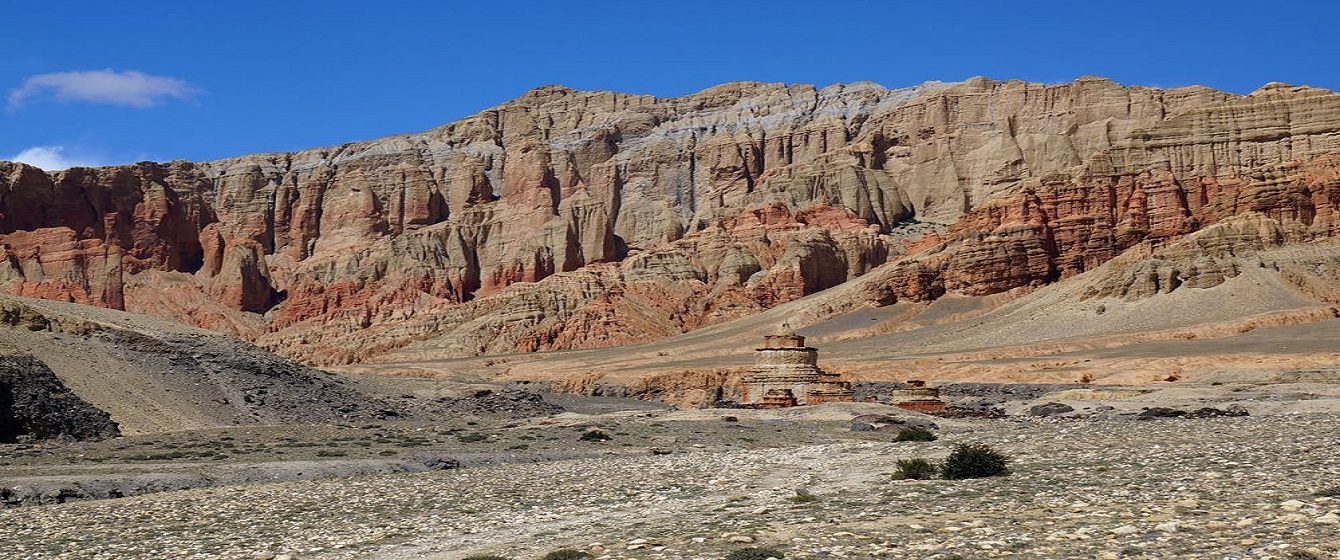
Restricted Area Treks in Nepal provide unique and remarkable destinations in the less adventure region, around high elevation Nepal Himalayas. Around Nepal, wide scope of beautiful and cultural regions fall inside the confined zone, where guests need to obtain special permits. The term-limited region is labeled because of its close boundary with Tibet/China, as well as to conserve and protect the immaculate climate. The restricted area also controls the mass progression of travelers, it helps and supports retaining and adjusting natural environmental surroundings.
An incredible way to enjoy an experience, where few groups of travelers/trekkers have the chance to wander around a restricted region, restricted area journey in Nepal, a different region where one can investigate the amicability of complete normal environmental elements. The government of Nepal and the Tourism Department has recorded the accompanying destinations of Nepal Himalaya, as restricted regions. Limited Areas are the accompanying region Far North West Upper Mustang, Upper/Lower Dolpo, and Humla-Limi valley. In the Mid-West is Manaslu Circuit and Tsum Valley includes Nar-Phu.
Where travelers/trekkers require a special permit to enter the above-limited region, in certain districts the expense for the licenses is higher. Be that as it may, all restricted region offers adventurers brilliant moment; few areas have very nice teahouses and Hotel for an overnight stay on route treks. Yet, in places like Upper/Lower Dolpo and Humla-Limi valley, trekkers need to spend overnight at Tent camping Groups.
The best way to wander around restricted regions for traveling should get together with solid neighborhood journeying organizations. One can't travel solo or an individual must be in a gathering of at least 2/3 people. The local organization will arrange and coordinate all planned reinforcement necessary, such as getting a special permit and setting up camp hardware. As well as giving master authorized guides, traveling staff, and watchmen with transportation either for an overland excursion or domestic flight.
Upper Mustang Trek:
Upper Mustang Trek is one of the famous restricted trekking regions around Nepal Himalaya, it is situated Far North West past Dhaulagiri and Annapurna Himalaya. For this trip to Upper Mustang, one should arrive at first Jomsom via air or take an overland excursion. Jomsom is a huge and settled town of the Mustang region, Jomsom is the beginning and end of Upper Mustang Trekking, arranged around the Lower Mustang region at Kaligandaki River valley.
A pleasant country, an extension of the vast South West levels of Tibet a dry scene but then lovely. Begin the leisurely walk from Jomsom heading far north-west, as the path follows the old Trans-Himalaya Salt Trade and Caravan Route to Tibet. Stroll to Kagbeni a pleasant Tibetan-style town, the beginning, and end-point of Upper Mustang. The excursion precedes to Lo Manthang the previous illegal walled realm of Mustang, heading into emotional scenes. Stroll past Chele and Gelling to Charang town encompassed by huge fields of buckwheat and visit the old religious monasteries.
At long last, the walk takes you towards the main feature of the experience to enter the previous walled kingdom Lo-Manthang. After a move more than a couple of passes and on a wide blustery valley to arrive at Lo-Manthang, here with time to investigate around. The old realm with Tibetan-style houses monitored inside an incredible high divider, visit the verifiable and social focus of the principle fascination of Lo-Manthang.
Partake in a visit through the principal cloisters Namgyal Gompa, Champa Lakhang (God House), Red Thubchen Gompa, Chyodi Gompa, and the incomparable Entrance Hall. After a magnificent time around Upper Mustang head back to Jomsom for a flight or drive to beautiful Pokhara. At present Upper Mustang can be reached by taking a drive to Lo-Manthang from Pokhara, the most noteworthy point for a short-term stop at 3,700 m high in Lo-Manthang.
Nar Phu Valley Trek:
Nar-Phu Trek, the region was shut to unfamiliar guests been open since the 1990s; one can dare to Nar and Phu. In the wake of acquiring an exceptional grant to go into high far secret corners of the Manang locale. Walk lead on a similar well-known trail of the Annapurna circuit for a day to the town of Kodo. Found Nepal Far North West behind enormous Annapurna Himalaya, near Chame the settled town of Manang region. From Kodo course redirects from the principal trail of Manang heading uphill towards distant north to arrive at first at Phu town.
Walk follows a river gorge covered in pine, rhododendron, and fir trees, then, at that point, enters a massive space to Phu. Partake in a rest day at Phu for acclimatization and investigate the desolate town and cloisters Tashilkhang and SamduCholing. After an intriguing time at Phu, stroll towards Na towns, which is practically like Phu, yet at the same very more modest? Partake in the second in this last town around stowed away corners of Western Himalaya, as well as the least visited district.
Gradually course takes you to cross high Kang-La and pass at over 5, 322 m high to arrive at Manang lower valley. On the principle trail of Annapurna Circuit, here with decisions on leaving the confined area of Nar and Phu. Either go on towards Jomsom crossing high Thorang-La Pass or return on a similar course through Pisang and Chame town.
Manaslu Circuit Trek:
Manaslu Circuit Trek is recorded as a restricted area, which was open for outside guests since late 1991, a picturesque and lovely experience. The walk includes crossing Larke-La Pass 5, 106 m high, the area additionally falls close in transit to the Tibet line. At present Manaslu circuit acquiring a stream of adventurers, because of its marvelous delightful view and neighborhood noteworthy culture. Mount Manaslu world's eighth most elevated top at 8,163m high, the walk covers the north and southern areas of Mt. Manaslu.
The experience includes an intriguing drive from Kathmandu, towards a low warm locale of the Gorkha area, and afterward strolls towards high green slopes. As walk enters the high country around the picturesque Manaslu valley, with time to investigate beautiful towns and the nearby culture of Buddhism.
Appreciate the journey of spending expedites in decent towns of Jagat, Namrung, and Lo-Gaon then at the fundamental town of Sama-Gaon. The valley is encased by a variety of high snow pinnacles of the Manaslu range, an extraordinary spot to go through an additional multi-day. At Sama Gaon partake in a rest day and a chance to observe the neighborhood's enormous customary life and custom of incredible interest. Further from the Sama-Gaon course prompts the foundation of Larke-La Pass-through Samdo town, toward the finish of Manaslu valley. The following daytime leaving the Gorkha region towards the Manang region, a precarious move to reach on top the most elevated point.
The Larke-La pass, an obstruction among Gorkha and Manang locale, from here on the long downhill to Bhimthang around Manang. Gradually walk follows on the beautiful backwoods way to reach the finish of the journey in Dharapani town. Situated on the mid-method of the famous Annapurna and Manaslu Circuit course, where a lengthy drive carries you to Kathmandu.
Tsum Valley Trek:
Tsum Valley, situated inside Mid-West Nepal, is in the middle of a monstrous Himalayan scope of Mt. Manaslu and enormous Ganesh Himal. Tsum Valley was shut for outside guests and afterward opened for intrigued voyagers to wander in the last part of the 1990s. One of the extremely unique regions around the Himalayas is recorded as a confined district, and worth a visit to this new Shangri-La. First and foremost, the walk takes you on a similar course to Manaslu, following a couple of days from Jagat and Deng towns.
Where trail redirects from the primary Manaslu circuit to head further east on the rear of massif Ganesh Himal. Then, at that point, enter the pleasant and superb country inside Tsum Valley, as the walk leads past Chokan-Paro and Nile towns. As the walk drives you to the primary feature at Mu Gompa, arranged over 3,700 m/12,139 feet high. Partake in your second around the remote and segregated nation and visit the intriguing old Buddhist religious community Mu-Gompa. Return journey downhill with a visit of Rachen Gompa and afterward back to low warm homestead towns for a drive to Kathmandu.
Lower Dolpo Trek:
An intriguing and superb experience towards Nepal Far West, because of its far-off area, where both-way flight includes. One of the least visited and limited regions, the walk takes you from Jhupal air terminal to Dunai settle town of Dolpo area. The primary component of Lower Dolpo Trek is its wonderful turquoise-shaded Phoksundo or Ringmo Lake. A great journey takes you to a wonderful country in agreement with the neighborhood's vivid culture. The towns of Dolpo entwined both Buddhism and the old Bon religion. Stroll inside a high nation, where the course prompts cross a few passes of Baga and Numa-La over 5,000 m.
Offers an excellent sensational view with perspectives on grand scenes and snow-covered tops, as far as Dhaulagiri Himalaya. The experiences go on by visiting the exquisite towns of Tokyu and Tarakot toward the finish of a trip to arrive at Jhupal. Returning a trip next early morning to Kathmandu through Nepalgunj city, after an important time around Lower Dolpo.
Upper Dolpo Trek:
The Upper Dolpo journey incorporates both the grand and social region of the entire Dolpo locale, taking a quick departure from Kathmandu. To arrive at Nepalgunj city air terminal, and afterward one more short trip to land at Jhupal in Dolpo. The walk prompts past the huge settled town at Dunai, following waterway and streams to wonderful emerald-shaded Phoksundo Lake. Found near the pleasant town of Ringmo, here with time to get accustomed to investigating the lovely region.
The experience then, at that point, heads to high Kang-La pass at 5, 200 m offers amazing perspectives on Dolpo's lovely nation scenes. Incorporates a great Himalayan scope of western Nepal, then, at that point, arrives at a remote and secluded little settlement at Shey Gompa.
This is additionally called the Crystal Monastery, as the cloister is found near Crystal Mountain close by. Appreciate astounding minutes around this beautiful remote spot, genuinely a spot mind-boggling. The return course takes you to the desolate towns of Saldang and Tokyu, an intriguing settlement enhance with brilliant wonderful culture. As the walk forges ahead grand Dho-Tarap valley to the recorded town of Tarakot and afterward at Dunai to end the journey. From Dunai drive to Jhupal for a trip to Kathmandu through Nepalgunj, after a most wonderful experience on Upper Dolpo Trek.
Humla and Limi Valley:
Humla and Limi Valley are one of the most far-off objections of Nepal near South West Tibet close to heavenly Mt. Kailash. A grand departure from Kathmandu and Nepalgunj city air terminal contact you to the hilly airstrip of Simikot. The fundamental slope town of Humla locale where this trip around Humla and Limi valley starts and finishes.
The walk follows outside of what might be expected, where not many western voyagers only occasionally visit this segregated district of Nepal. As journey follows on the old convoy shipping lane of Nepal and Tibet, which is as yet dynamic right up 'til today. The nearby individual's exchange and bargain in the border town of Tibet and Nepal.
One of few untainted limited locales, adventurers on this Humla and Limi valley will positively partake in the flawless environmental elements. Aside from picturesque scenes and mountain sees, the vivid culture and old traditions are similarly entrancing in investigating noteworthy towns. The walk takes you to Kermi, Yalbang, Muchu, Yari, Mane-PemeTil with Halji, and visit cloisters of incredible strict importance.
The entire excursion is a beautifully grand and social circuit, strolling to Hilsa the line town of Nepal and Tibet. At last, the walk closes at Simikot for an astonishing trip back to Kathmandu, after a striking experience on Humla and Limi Valley.
Recent Blog
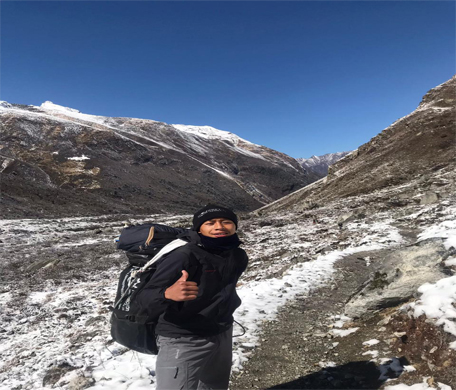
Best Trekking Company in Nepal
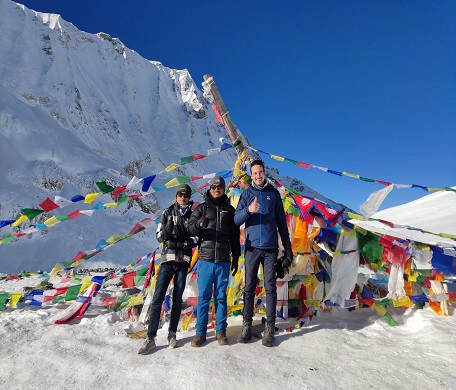
Is the Manaslu Circuit trek ha...
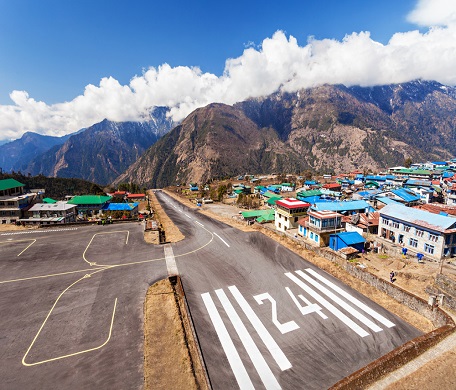
Ramechhap Lukla Ramechhap Flig...
Useful links, booking information, about company.
- Company Profile
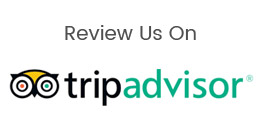
Address: Sorekhutte, Kathmandu
Phone: +9779818141334
E-mail: [email protected]
Associated with Following Company
Follow us on folloiwng links, payment options.

© Copyright 2024 Himalayan Local Guide. All rights reserved. | Developed by : Web Design In Nepal
Quick Inquiry

- Adventure Activities
Festivals And Culture
- Hiking And Trekking
Peak Climbing
- Sightseeing Information
Tourism Info
- Trekking Information
Exploring Restricted Areas In Nepal
Nepal, celebrated for its awe-inspiring landscapes and cultural richness, beckons daring adventurers and curious explorers. While most of the country extends a warm welcome to travelers, there are enigmatic pockets known as “ Restricted Areas in Nepal” where accessibility is limited.
These elusive zones, though challenging to reach, harbor unparalleled beauty and profound cultural significance. This article serves as your guide to the captivating world of Nepal’s restricted areas, offering crucial information, permit details, and insights for an extraordinary once-in-a-lifetime expedition.
Understanding “Restricted Areas in Nepal”
A restricted area in Nepal denotes a specific region with restricted tourist access, requiring special permits for entry. Rigorous regulation by the Nepalese government aims to manage tourism meticulously, preserving the areas’ distinctive cultural, ecological, and geopolitical importance.
Reasons Behind “ Restricted Regions in Nepal “
Nepal designates these regions to achieve multiple objectives, including the preservation of indigenous cultures, conservation of fragile ecosystems, addressing geopolitical sensitivities, promotion of sustainable tourism, protecting cultural heritage, and encouraging offbeat exploration.
Legal Framework Governing Nepal’s Restricted Areas
The Nepalese government, facilitated by the Department of Immigration and relevant Authorities, enforces legal regulations to control access to these restricted areas. These regulations encompass permit requirements, mandated guided tours, permit fees, validity periods, and strict adherence to regulations regarding local customs, environmental norms, and cultural sensitivities.
Distinguishing Accessible Areas from Restricted Areas
Accessible areas in Nepal cater to visitors with ease of reach, developed tourism infrastructure, and open access. In contrast, restricted areas demand special permits due to rugged terrain, remoteness, conservation priorities, or security concerns.
Detailed Comparison:
Topic accessible areas restricted areas.
Definition Areas open to the public, easily reachable, and often developed for tourism or local activities. Areas with limited or controlled access due to safety, security, conservation, or other cultural reasons.
Accessibility Generally easy to reach via roads, trails, or transportation services. Access might be restricted due to rugged terrain or remoteness.
Permits Generally, no special permits are required for entry. Special permits or approvals from relevant authorities are needed to enter.
Conservation Some accessible areas might have conservation efforts but are open to visitors. Restricted areas often have stricter conservation measures in place to protect ecosystems, wildlife, or archaeology.
Tourism Development Often well-developed with infrastructure, accommodations, and facilities. May have limited or no tourism infrastructure for preservation purposes.
Cultural Sites Accessible areas might include well-known cultural heritage sites, and visitors can freely explore them. Restricted areas could include culturally sensitive sites integral to indigenous communities. These sites may be restricted to protect the local way of life.
Wildlife Reserves Accessible wildlife reserves are open for eco-tourism and wildlife watching. Restricted wildlife reserves might only allow scientific research or limited entry to protect animals and habitats.
Security Generally safe and without major security concerns. They are restricted due to security, political instability, or military presence.
Photography and Media Visitors can take photos and document their experiences. Photography and media activities may require permits or be prohibited.
Tourism Impact Higher tourist footfall potentially impacts local culture and the environment. Restricted to prevent over-tourism and maintain ecological balance.
Key “Restricted Areas in Nepal”
1. upper mustang.
Located in north-central Nepal, Upper Mustang, with its unique desert-like landscape, is restricted to safeguard its Tibetan-influenced culture. A Restricted Area Permit (RAP) and guidance from a registered trekking agency are mandatory for exploring the walled city of Lo Manthang, ancient monasteries, and the mystic traditions of Sky Burial, Bon, and Buddhism.
2. Upper Dolpo
In the far-western region, Upper Dolpo preserves its rugged terrain and cultural heritage. A special RAP is required to witness attractions like Phoksundo Lake, Shey Gompa, and the unique lifestyle of the Dolpo-pa people.
3. Lower Dolpo
Nestled in the midwestern region, Lower Dolpo, known for its remote landscapes, ancient monasteries, and mystical Phoksundo Lake, requires a RAP for exploration. It offers a rare opportunity to witness the traditional lifestyle of local communities.
One of Nepal’s most isolated regions in the far northwestern part, Humla safeguards its cultural heritage and fragile environment. Travelers must obtain a RAP to explore attractions such as the Limi Valley and the trek to the sacred Mount Kailash in Tibet.
5. Taplejung
In the Far East, Taplejung’s restricted status aims to preserve the Kanchenjunga Conservation Area. A RAP is necessary to trek in this area, which boasts the Kanchenjunga massif and the cultural richness of local ethnic communities.
Central Nepal’s Dolakha, with its historical significance and proximity to the Tibetan border, requires a special restricted permit. The area offers stunning views of the Himalayan peaks, religious sites like the Dolakha Bhimsen temple, and a glimpse into Nepal’s history.
7. Tsum Valley- Gorkha
Hidden in the Gorkha district, the Tsum Valley, restricted to preserve its unique culture, mandates a RAP and guided travel. Visitors can explore ancient monasteries like Mu Gompa and immerse themselves in the warm hospitality of the local Tsumba people.
8. Sankhuwasabha
In eastern Nepal, Sankhuwasabha is restricted to protect the Makalu Barun National Park. A RAP and a Makalu Barun National Park entry permit are essential for traversing challenging trekking trails and spotting various endangered species.
9. Solukhumbu
Famous for the Everest region, Solukhumbu is restricted to conserve its natural beauty and protect the Sherpa community’s culture. A RAP and a Sagarmatha National Park entry permit are required for trekking, with attractions like the Everest Base Camp and Tengboche Monastery.
Located in northern Nepal, Rasuwa is restricted due to its proximity to the Tibetan border. A RAP is necessary for trekking and cultural exploration, with attractions like the Langtang Valley , Gosaikunda Lake, and the Langtang National Park.
Situated in the Annapurna Conservation Area, Manang is restricted to protect the local culture and environment. Trekkers need a RAP and an Annapurna Conservation Area Permit (ACAP) to explore attractions like the Annapurna Circuit Trek and ancient monasteries.
12. Bajhang
A remote and restricted region in the far-western part, Bajhang’s untouched beauty and cultural diversity require a RAP for exploration. Visitors can engage with local ethnic communities, experiencing the region’s rich heritage.
13. Manaslu Nubri Valley- Gorkha
Nestled in the Gorkha district, the Manaslu Nubri Valley is restricted due to its geopolitical sensitivity. A restricted area permit and a trekking permit are necessary to discover diverse landscapes and traditional Tibetan villages.
Situated in the far northwestern region, Mugu’s pristine landscapes and cultural heritage necessitate a RAP for exploration. Trekkers can embark on an off-the-beaten-path adventure, encountering serene lakes and indigenous communities.
16. Darchula
In the far west, Darchula’s breathtaking beauty and cultural richness are preserved through restricted access. Travelers must obtain a RAP for an authentic trekking experience in this remote and pristine landscape.
Tips for Exploring “Restricted Areas in Nepal.”
Embarking on a journey to Nepal’s restricted areas requires careful planning. Here are some practical tips to enhance your experience:
Obtaining the Necessary Permits:
Ensure you secure all required permits before commencing your journey, including the Restricted Area Permit (RAP) and any additional permits specific to your chosen area.
Choosing an Authorized Trekking Agency:
Select a reputable trekking agency, such as Mission Himalaya Treks, with experienced guides familiar with the region. Their insights into local culture and customs are invaluable.
Hiring Local Guides and Porters:
Engage local guides and porters for their intimate understanding of the area, providing cultural insights and ensuring a smoother travel experience while supporting the local economy.
Preserving Endangered Flora and Fauna:
Respect the delicate ecosystems by avoiding disturbances to plants and wildlife. Follow designated trails and minimize your impact on nature.
Responsible Tourism in Sensitive Ecosystems:
Adhere to the principles of responsible tourism, avoiding littering, using eco-friendly products, and being mindful of your carbon footprint.
Supporting Local Initiatives:
Contribute to local conservation efforts and community-driven projects promoting sustainable development during your visit.
In Conclusion
Nepal’s restricted areas unveil a tapestry of history and culture, offering a unique journey into the past. As you traverse these hidden corners, you discover history and become a chapter in it. The locals, custodians of traditions for generations, invite you to be part of their timeless story.
Explore these extraordinary spots for an experience unparalleled in Nepal, where every step is a testament to the rich heritage and natural splendor guarded by the majestic Himalayas.
You Might Also Like

14 Hindu Pilgrimage Sites in Nepal

5 Festivals Celebrated in Himalayas of Nepal

51 Facts of Nepal Someone Don’t Know

10 Best Peak Climbing in Nepal


Any Question? Email Us
Talk To An Expert ( Prakash Lamsal )
Follow Us In
Main Navigation
Company info.
- Become A Partner
- Company Legal Document
- Why Nepal Himalaysas Trekking
- Terms and Conditions
Destinations
- Peak Climbing
- Adventure Sports
- Mountain Flights in Nepal
- Jungle Safari
- Rafting In Nepal
Helicopter Tour
- Paragliding in Nepal
- Bungee Jumping in Nepal
- Jungle Safari in Nepal
- Annapurna Region
- Everest Region
- Langtang Region
- Dolpo Region
- Manaslu Region
- Mustang Region
- Kanchenjunga Region
- Makalu Region
- Everest Base Camp Helicopter Tour
- Travel Blog
- Any Inquiry ?
Restricted Area Trekking in Nepal

Are you aware of the restricted area trekking in Nepal? The government has designated certain regions in the Himalayas of Nepal as restricted area trekking zones. These areas are located in various parts of the Nepalese Himalayan range. Engaging in restricted area trekking in Nepal allows you to immerse yourself in ancient villages and timeless cultures set against pristine natural beauty.
Table of Contents
Want to plan your holiday in nepal.
Despite the remote nature of these regions, you can obtain a special trekking permit to explore them. While acquiring the permit may require a slightly higher cost, the experience is truly invaluable. This article highlights our renowned restricted area trekking in Nepal, showcasing the beauty of these regions.
Let's delve into our restricted area trekking in Nepal.
Here are some of our trekking adventures that are listed as restricted area trekking.
Upper Mustang Trek
The Upper Mustang Trek offers a unique and unforgettable experience in Nepal's restricted areas. This journey allows you to discover the ancient kingdom of Lo in Upper Mustang while immersing yourself in the cultural and natural beauty of the region. As you venture deeper into the restricted region of Mustang in the Himalayas, you will encounter rugged mountains, jagged cliffs, and timeless villages along the trail.
The highlight of the trek is reaching Lo Manthang, the ancient kingdom of Lo, where you will be surrounded by a civilization untouched by modernity. Throughout the trek, you will traverse mountain passes, visit villages, and witness breathtaking views of the Himalayan peaks. Additionally, you will have the opportunity to explore ancient monasteries and caves, adding to the richness of this adventure.

Manaslu Circuit Trek
The Manaslu Circuit Trek is renowned as a remote and captivating trekking option in Nepal. It has gained popularity as an alternative to the well-known Annapurna Circuit Trek . With the Annapurna circuit becoming more accessible due to the presence of dirt roads, many trekkers are now opting for the Manaslu region instead. This shift in preference is justified as Manaslu truly offers a comparable experience to the Annapurna circuit.
Embarking on the Manaslu trek is an opportunity to immerse oneself in a tranquil yet challenging adventure. The region sees fewer visitors, allowing for a more serene and intimate experience. As you ascend to higher altitudes, you will truly grasp the remoteness of the area. Additionally, you will have the chance to witness and appreciate the timeless culture and lifestyle of the local inhabitants.

Tsum Valley Trek
Tsum Valley , located in the Manaslu region, is a remarkable destination for trekkers. This secluded valley allows visitors to immerse themselves in the rich culture of the local villages and ethnic communities. Until recently, the civilization of Tsum Valley remained undiscovered, resulting in an authentic cultural experience and a unique way of life. The strong Buddhist influence in the daily lives of the residents creates a spiritual ambiance throughout the region.

Upper Dolpo Trek
The Upper Dolpo Trek is a remarkable restricted area trek in Nepal that allows you to discover the remote western Himalayan Mountains. This extensive journey offers insights into the local culture, stunning mountain panoramas, and the serene beauty of nature, including a picturesque lake. The isolation of the western mountains and the ancient villages in the area provides a unique opportunity to immerse oneself in the wilderness. With fewer trekkers in the region, this trek offers a peaceful and authentic experience. Embarking on this adventure is sure to be a highlight of your trekking experiences.

Nar Phu Valley Trek
Nar Phu Valley Trek goes to the northern part of Manang district to explore the remote valleys of Nar and Phu. You follow the Annapurna Circuit Trail and take a diversion towards Nar Phu Valley. You will explore ancient cultures in timeless villages of the two remote valleys – Nar and Phu.
This trek is also a recent opening for exploration of the outer world. Thus, you can find the unaffected cultural wonders and nature at its best. Nar Phu Valley Trek can also be combined with the Annapurna Circuit Trek.

Kanchenjunga Trek
The Kanchenjunga Trek is located in the eastern part of the Himalayas in Nepal. Embarking on a journey in the vicinity of the third highest mountain on earth promises an unforgettable adventure. This trek is known for being one of the more secluded options in Nepal, offering a unique experience in the eastern Himalayan region where the majestic Mt. Kanchenjunga, standing at 8,586 meters, captivates all who visit.
The main highlight of the Kanchenjunga trek is reaching the base camp and exploring the pristine surroundings of the area. This remote and less-traveled trail ensures that the wilderness of the Kanchenjunga region remains untouched and preserved.

If you are interested in learning more about restricted area trekking adventures in Nepal, please feel free to reach out to us.
Want to Plan For Trekking Package ?

Associated and Recommended On
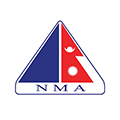
Notice. This site uses cookies to optimize your user experience. By using this site, you are consenting to our use of these cookies. Check out our Privacy Policy and our Cookies Policy.

- Why Do You Choose NHTE?
- Who Are We?
- Legal Documents
- Terms and Conditions
- Clients Reviews
- Ghorepani Poon Hill Trek: Poon Hill Trek 3 Days From Pokhara
- Ghorepani Poon Hill with Mardi Himal Trek
- Short Annapurna Base Camp Trek
- Annapurna Base Camp Trek 6 Days
- 7 Days Annapurna Base Camp Trek
- Annapurna Base Camp with Poon Hill Trek 10 Days
- Annapurna Circuit Trek 10 Days
- Annapurna Base Camp Trek
- Annapurna Circuit Trek 12 Days
- Mardi Himal Trek
- Khair Lake and Khopra Ridge Trek
- Mohare Danda Trek
- Jomsom Muktinath Trek
- Annapurna Circuit Trek: Explore the world’s longest Thorong La Pass
- Annapurna Tilicho Lake Trek
- Ghale Gaun Trek
- Nar Phu Valley Trek
- Poon Hill Trek 3 Days
- Langtang Trek
- Langtang Valley Trek
- Short Langtang Trek 5 Days
- Langtang Gosainkunda Trek
- Langtang Tamang Heritage Trek
- Gosainkunda Pass Trek
- Helambu Trek
- Langtang Valley and Ganja La Pass Trek
- Everest View Trek
- Everest Base Camp Trek 9 Days
- Everest Short Trek
- Everest Base Camp Trek 10 Days
- Everest Base Camp Trek 12 Days: Everest Base Camp Short Trek
- Everest Base Camp Trek: Experience Nature’s Majesty at Its Peak
- 14 Days Everest Base Camp Trek
- Gokyo Lake Trek
- Gokyo Chola Pass Trek
- Everest Base Camp Trekking
- Everest Three Pass Trek: Three High Passes Trekking in Nepal
- Everest Base Camp Trek Cost
- Ama Lapcha Pass Trek
- Pike Peak Trek
- Everest Base Camp Luxury Trek
- Everest Base Camp Trek Guide Cost
Manaslu Circuit Trek
- Manaslu Trek
- Manaslu Circuit Trek 10 Days
- Manaslu Tsum Valley Trek
- Lower Dolpo Trekking
- Lower Manaslu Scenic Trek
- Rara Lake Trekking
- Rupina La Pass Trek
- Upper Dolpo Trekking
- Upper Mustang Trek: Discover the Hidden Nature & Culture of Mustang
- Chepang Hill Trek
- Ganga Jamuna Trek
- Kathmandu Valley Tour
- Kathmandu Chitwan Tour
- Kathmandu Chitwan Pokhara Package Tour
- Kathmandu Chitwan Lumbini Via Pokhara Tour
- Bandipur Pokhara Tour
- Bungy Jump in Nepal
- Helicopter Tour In Nepal
- Mountain Flight in Nepal
- Paragliding in Nepal
- Island Peak Climbing: Popular Trekking Peak Climb in Nepal
- Lobuche Peak Climbing:
- Mera Peak Climbing
- Pisang Peak Climbing
- Yala Peak Climbing
- Amadablam Expedition in Nepal
- Chulu West Peak Climbing
- Trekking in Nepal
- Packages Tour in Nepal
- Peak Climbing in Nepal
- Expedition in Nepal
- Rafting in Nepal
- Chitwan Jungle Safari
- Paraglading in Nepal
- Mount Kailash Tour
- Cho Oyu Expedition in Nepal
- Bhutan Tour
- Bhutan Cultural Tour
- Compulsory Equipment List
- Nepal Visa Information
- Currency & Payments
- Travel Insurance

Restricted Area Treks in Nepal

Restricted Area Treks in Nepal , provide unique culture and marvelous scenarios of the Himalayas. The Restricted Trek would be a perfect destination for all travelers. There are many restricted treks Around Nepal and find the trek as per your liking. Furthermore, before starting the journey to isolated areas you should obtain the required permit. However, any trekkers easily soak into the natural beauties and culture too.
The term restricted area is tagged due to the close border with Tibet/China. As well as to conserve and protect the pristine environment. The restricted area is also protected by the Nepal Tourism Board and the local government.
Taste the natural beauty & multi-ethnic culture
A great way to enjoy various adventures with spend a memorable time in the mountains. It is acceptable for all age groups of trekkers to have the opportunity to venture around a restricted region. Restricted area treks in Nepal, a various region where one can explore in the harmony of complete natural surroundings.
The government of Nepal and the Tourism Department have listed the following destinations of Nepal Himalaya, as restricted areas. Restricted Areas are the following regions Far North West Upper Mustang, Upper/ Lower Dolpo, and Humla-Limi Valley . Furthermore, In the Mid-West is Manaslu Circuit and Tsum Valley includes Nar-Phu.
Experience off beaten Journey in Nepal
Where trekkers require special permits to enter the above-restricted area, in some regions the cost for the permits is higher. However, all restricted area offers trekkers delightful moments, few areas have nice lodges for an overnight stay on route treks. But in places like Upper / Lower Dolpo and Humla-Limi Valley, trekkers have to spend overnights in tented camping.
The only way to venture around Restricted areas for trekking is to join reliable local trekking companies. Besides, a single traveler cannot trek solo or an individual has to be in a group of a minimum of 2 people. The local company will arrange and organize all logistic backup with the necessary arrangements, like obtaining special permits, and camping equipment. As well as providing expert licensed guides, trekking staff, and porters with transportation either for an overland journey or domestic flight.
Upper Mustang Trek
Upper Mustang Trek is one of the popular restricted and thrilling journeys in Nepal. It’s located between Far North West beyond Dhaulagiri and Annapurna Himalaya. For this trek to Upper Mustang, one must reach first to Jomsom by air. Jomsom is a large headquarters town of the Mustang district. It is the gateway of the Upper Mustang Trek and is situated around the Kaligandaki River Valley.
Upper Mustang is an isolated north plateau located between Nepal and Tibet. Start the walk from Jomsom heading far north-west, as the trail follows the old Trans-Himalaya Salt Trade and Caravan Route to Tibet. Walk to Kagbeni a nice Tibetan-style village, the starting, and end-point of Upper Mustang. The journey continues to Lo Manthang the former forbidden walled kingdom of Mustang, heading into dramatic landscapes. Walk past Chele and Gelling to Charang village surrounded by large fields of buckwheat and visit the old monastery.
Himalayan Royal Palace With Sophisticated Tibetan Culture
Finally, the walk takes you towards the main highlight of the adventure to enter the former walled kingdom Lo-Manthang. After a climb over a few passes and on a wide windy valley to reach Lo-Manthang, here with time to explore around. The old typical roral palace with Tibetan authentic village with an awesome trans north part of Himalayas. Lo Manthang is charming and filled by culture with natural beauty. It’s one of the attraction places of the Mustang Trek.
Enjoy a tour of the main monasteries Namgyal Gompa, Champa Lakhang (God House), Red Thubchen Gompa, Chyodi Gompa, and the great Entrance Hall. Additionally, After a wonderful time around Upper Mustang head back to Jomsom for a flight or drive to scenic Pokhara. At this time there is road access to Lomanthang but we highly recommend walking and exploring the wonderous Himalayas. p
Nar-Phu Trekking
Nar-Phu Valley Trek is in the Annapurna region of Nepal. It was open since the 1990s for foreign travelers but it has required a special permit to complete the trek. Besides, After obtaining a special permit to enter into high far hidden corners of the Manang district. Walk lead on the same popular trail of the Annapurna circuit for some days to the village of Kodo. It’s located in the massive Annapurna region of Nepal in the Manang district. From Kodo, the trail has diverted to many places like Nar Phu Valley, Kangla Pass, and Anapurna Circuit Trail.
The walk follows a river gorge covered in pine, rhododendrons, and fir trees, then enters a wide-open area to Phu. Enjoy a rest day at Phu for acclimatization and explore the windswept village and monasteries Tashilkhang and SamduCholing. After an interesting time at Phu, walk towards Na villages, which is almost similar to Phu, but quite smaller. Enjoy the moment in this last village around the hidden corners of Western Himalaya , as well as the least visited region.
Slowly route takes you to cross the high Kang-La pass at above 5, 322 m high to reach Manang Lower Valley. On the main trail of Annapurna Circuit, here with choices on leaving the restricted area of Nar and Phu. Either continue towards Jomsom crossing the high Thorang-La Pass or return on the same route via Pisang and Chame town.
Manaslu Circuit Trek is an amusing journey in the Manaslu region of Nepal. It has been listed as a restricted area and it was open to foreigners since,1991. The Manaslu Trek offers mirthful scenarios of mountains, unique diverse cultures, and various landscapes with enjoyable walking. The trek route incorporated the challenging and beautiful Larke-La Pass 5160 m. It’s the high elevation throughout the trek. Besides, Mount Manaslu is the world’s 8th highest peak at 8,163 m and it’s open for climbing too. At present Manaslu circuit gaining more flow of trekkers, due to its awesome beautiful scenery and local impressive culture.
The adventure involves an exciting drive from Kathmandu to Sotikhola or Arughat. The journey towards a low warm region of Gorkha district, and then walk towards high green hills. The walk enters the high country around the scenic Manaslu Valley, with the local culture of Buddhism.
Lastly, the Manaslu Circuit Trail has combined the popular Annapurna Circuit Trek, and if you have ample time you can towards the Annapurna Himalayas.
Relish the nature & culture of the Manaslu Region
Enjoy trekking and spending overnights in the nice villages of Jagat, Namrung, and Lo-Gaon then at the main village of Sama-Gaon. The valley is enclosed by an array of high snow peaks of the Manaslu range, a great place to spend an extra day. At Sama Gaon enjoy a rest day an opportunity to witness the local immense traditional life and customs of great interest. Further from the Sama-Gaon route leads to the base of Larke-La Pass via Samdo village, at the end of Manaslu Valley. The next morning leaving the Gorkha district towards the Manang area, a steep climb to reach on top the highest point.
The Larke-La pass, a barrier between Gorkha and Manang district, from here on the long downhill to Bhimthang around Manang. Slowly walk follows on the lovely forest path to reach at the end of the trek in Dharapani village. Located on the mid-way of the popular Annapurna and Manaslu Circuit route, where a long drive brings you to Kathmandu.
Tsum Valley Trek
The journey to Tsum Valley is brilliant and acceptable to all types of travelers. It has many hidden beautiful elements along the trail. that Tsum Valley, located within Mid-West Nepal , is in between the massive Himalayan range of Mt. Manaslu and the massive Ganesh Himal. Manaslu Tsum Valley was closed to outside visitors and then opened for interested travelers to venture into in the late 1990s. One of the very special areas around the Himalayas is listed as a restricted region, and worth a visit to this new Shangri-La. In the beginning, the walk takes you on the same route of Manaslu, after a few days from Jagat and Deng villages.
Where the trail diverts from main Manaslu circuit to head further east on the backside of massif Ganesh Himal. Then enter the picturesque and wonderful country within Tsum Valley, as the walk leads past Chokan-Paro and Nile villages. As the walk leads you to the main highlight at Mu Gompa, situated above 3,700 m /12,139 feet high. Enjoy your moment around the remote and isolated country and visit the interesting old Buddhist monastery Mu-Gompa. Visit Rachen Gompa and then back to the low warm farm village at Sotikhola.
Lower Dolpo Trek:
An interesting and marvelous adventure towards Nepal Far West, due to its remote location, where both-way flights are involved. When you visit the restricted areas of far west Nepal then you will back to Jhupal airport of Dolpo district. The main feature of Lower Dolpo Trek is its beautiful turquoise-colored Phoksundo or Ringmo Lake. A wonderful trek takes you to a beautiful country in harmony with the local colorful culture. The villages of Dolpo are interwoven with both Buddhism and the ancient Bon religion. Walk within a high country, where the route leads to cross some passes of Baga and Numa-La above 5,000 m.
Offers grand dramatic scenery with views of magnificent landscapes and snow-capped peaks, as far as Dhaulagiri Himalaya. The adventure continues by visiting the lovely villages of Tokyu and Tarakot at the end of a trek to reach Jhupal. Taking a flight next early morning back to Kathmandu via Nepalgunj city, after a memorable time around Lower Dolpo.
Upper Dolpo Trek:
The Upper Dolpo Trek includes both scenic and cultural areas of the whole Dolpo region, taking a swift flight from Kathmandu. To reach Nepalgunj City Airport, and then another short flight to land at Jhupal in Dolpo . The walk leads past the large headquarters town at Dunai, following rivers and streams to the beautiful emerald-colored Phoksundo Lake. Located close to the nice village of Ringmo, here with time to get acclimatized as well as explore the beautiful area.
The adventure then heads to the high Kang-La pass at 5, 200 m offers grand views of Dolpo’s beautiful country landscapes. Includes a majestic Himalayan range of western Nepal, then reaches a remote and isolated small settlement at Shey Gompa.
This is also called the Crystal Monastery, as the monastery is located close to Crystal Mountain nearby. Enjoy amazing moments around this lovely remote spot, truly a place out of this world. The return route takes you windswept villages of Saldang and at Tokyu, interesting settlements adorn with a bright beautiful culture. As the walk continues on scenic Dho-Tarap valley to the historical village of Tarakot and then at Dunai to end the trek. From Dunai drive to Jhupal for a flight to Kathmandu via Nepalgunj, after a most marvelous adventure on Upper Dolpo Trek.
Humla and Limi Valley:
Humla and Limi Valley, one of the most remote destinations of Nepal close to South West Tibet near holy Mt. Kailash. A scenic flight from Kathmandu and Nepalgunj City Airport reaches you to the mountainous airstrip of Simikot. The main hill town of Humla district where this trek around Humla and Limi valley begins and ends.
Walk follows off the beaten path, where very few Western travelers seldom visit this isolated region of Nepal. As trek follows on the old caravan trade route of Nepal and Tibet, which is still active to this day. The local people still trade and barter on the border town of Tibet and Nepal.
One of few unspoiled restricted regions, trekkers on this Humla and Limi valley will certainly enjoy the pristine surroundings. Apart from scenic landscapes and mountain views, the colorful culture and ancient customs are equally fascinating exploring impressive villages. The walk takes you to Kermi, Yalbang, Muchu, Yari, and Mane-PemeTil with Halji, visit monasteries of great religious significance.
The whole trip is a lovely scenic and cultural circuit, walking to Hilsa the border village of Nepal and Tibet. Finally walk ends at Simikot for an exciting flight back to Kathmandu, after a remarkable adventure on Humla and Limi Valley.
The best time to do the treks in Nepal
The most preferable times for restricted area trekking are mid-spring from March to May and September to November months during the autumn season.
Upper Mustang, Dolpo, and Limi Valley can be trekked during monsoon wet months, as this region falls within a rain shadow. Where all heavy black clouds are blocked by the great Himalayan range and that is why the area is dry and arid and receives few showers. As this trek leads to high altitudes, it is not recommended during winter times with heavy snowfall on route trekking. The Nepal High Trek & Expedition team highly recommends the Restricted Area Treks in Nepal for 2023/2024. We are here ready to explore the beauty of Nepal.

Our Partners

Sign Up for Our Free Newsletter
--> For quick Inquiry: +977 98510 42334
Fixed Departure
--> +977 98510 42334
Nanga La Pass in Upper Dolpo
Restricted Areas in Nepal
Approx. Read Time: 13 Minutes
Publised at Aug 15, 2023
Nepal, a country adorned with breathtaking landscapes and rich cultural heritage, has always been a top destination for adventurous souls and curious wanderers. While most regions of Nepal welcome travelers with open arms, there exist certain areas known as "Restricted Areas," shrouded in limited accessibility.
Although these restricted zones present challenges to reach, they hold unparalleled beauty and immense cultural significance. In this blog post, you will explore the enchanting world of restricted areas of Nepal. This guide provides essential information, permits, and insights to embark on a once-in-a-lifetime journey.
What is a restricted area in Nepal?
A restricted area in Nepal refers to a specific area or region within the country that has limited tourist access and requires special permits for entry. The Nepalese government carefully regulates these areas to control and monitor tourism, preserving their unique cultural, ecological, and geopolitical significance.
Why are there restricted regions in Nepal?
Nepal designated restricted regions to conserve natural habitats, protect local traditions, manage tourism sustainably, and ensure border security. Here are some significant purposes for establishing these restricted areas:
Preservation of culture and tradition
Some regions in Nepal are home to indigenous communities with ancient cultural practices and traditions. Designating these areas as restricted ensures that their way of life remains protected from the potential impact of mass tourism and modernization.
Environmental conservation
Certain parts of Nepal possess fragile ecosystems, rare wildlife, and endangered plant species. By restricting the number of visitors, the authorities can better manage and preserve these regions' natural environment and biodiversity.
Geopolitical sensitivity
Some areas in Nepal are located near international borders or have geopolitical sensitivities. Regulating access to these regions helps maintain national security and sovereignty.
Sustainable tourism
Controlling the number of tourists in restricted areas ensures that the inflow of visitors is sustainable and does not overwhelm the local resources or infrastructure.
Cultural heritage protection
Many restricted areas in Nepal hold significant religious and historical sites. Managing tourism through permits helps safeguard these cultural treasures for future generations.
Promoting offbeat tourism
By designating certain regions as restricted, the government encourages tourists to explore lesser-known and off-the-beaten destinations, distributing the benefits of tourism across the country.
Legal Regulations Governing Restricted Areas in Nepal
The Nepalese government, through the Department of Immigration and other relevant authorities, implements legal regulations to control access to restricted areas. These regulations include:
Permit requirements
Travelers wishing to visit restricted areas must obtain special permits, also known as Restricted Area Permits (RAP), from the Department of Immigration. These permits specify the region, duration of stay, and other conditions.
Authorized guided tours
Authorized guides must accompany tourists in restricted areas. Alternatively, they can be part of organized tours to ensure proper monitoring and adherence to the rules.
Permit fees
Travelers are required to pay a fee to obtain restricted area permits. The cost may vary depending on the region and duration of the visit.
Validity and duration
Restricted area permits have specific validity periods. Travelers must abide by the permitted duration of their stay in the designated areas.
Compliance with regulations
Visitors must strictly adhere to the guidelines and respect local customs, environmental norms, and cultural sensitivities.
Accessible areas vs. Restricted areas
Accessible areas in Nepal are easily reached by visitors, offering popular tourist sites, local activities, and cultural landmarks. In contrast, restricted areas require special permits, often safeguarding fragile ecosystems, cultural sanctity, or addressing security concerns.
The table below provides detailed information on the differences between these two types of areas:
Major Restricted Areas in Nepal
Upper mustang .
Upper Mustang is located in the north-central part of Nepal. It lies in the rain shadow of the Himalayas, resulting in a unique desert-like landscape. It is restricted to protect its Tibetan-influenced culture and ancient traditions. Travelers must obtain a special Restricted Area Permit (RAP) and travel with a registered trekking agency to explore this mystical land. Major attractions include the walled city of Lo Manthang, ancient monasteries, colorful rock formations, sky caves, mystic traditional rituals such as Sky Burial, Bon and Buddhism practices, and stunning views of the Niligiri and Annapurna ranges.
Upper Dolpo
Situated in the far-western region, Upper Dolpo is renowned for its rugged terrain and remoteness. It is restricted to conserving its pristine natural beauty and protecting its inhabitants' cultural heritage, the Dolpo-pa people.
Obtaining a special RAP is necessary to venture into this restricted zone. Significant attractions in Upper Dolpo include the Phoksundo Lake, Shey Gompa, unique Bon, and Buddhist monasteries, and the chance to witness the nomadic lifestyle of the locals.
Lower Dolpo
Lower Dolpo lies in the midwestern region and is restricted to safeguard its natural beauty and cultural heritage. The area is known for its remote and rugged terrain, ancient monasteries, and mystical Phoksundo Lake. Travelers must obtain a RAP to visit Lower Dolpo.
However, it's a lifetime opportunity to experience the traditional lifestyle of the local people, which has remained unchanged for centuries.
Humla
Humla remains one of Nepal's most isolated and restricted areas in the far northwestern region. The region's cultural heritage and fragile environment are safeguarded through controlled tourism. Travelers need a RAP to explore Humla. Major attractions include the Limi Valley, ancient monasteries, remote villages, and the trek to the sacred Mount Kailash in Tibet.
In the far eastern part of Nepal, Taplejung is a restricted region known for its diverse biodiversity and picturesque landscapes. The primary purpose of the restrictions is to preserve the Kanchenjunga Conservation Area and protect its wildlife and unique flora.
A RAP is required to trek in this area. The major attraction is the Kanchenjunga massif, the third-highest mountain in the world, along with the cultural richness of the local ethnic communities.
Dolakha
Dolakha, located in the central part of Nepal, is restricted due to its proximity to the Tibetan border and the significance of the area in Nepal's history.
A special restricted permit is required to explore this region, which offers stunning views of the Himalayan peaks, including Gauri Shankar and Melungtse. The area also houses religious sites like the Dolakha Bhimsen temple, attracting trekkers and pilgrims.
Tsum Valley- Gorkha
Tsum Valley is a hidden Gorkha district treasure nestled against the Tibetan border. Restricted to preserve its unique culture and pristine environment, travelers need a RAP and must travel with an authorized trekking agency.
The Tsum Valley is renowned for its ancient monasteries, including the Mu Gompa. The serene landscape with the warm hospitality of the local Tsumba people is also worth experiencing.
Sankhuwasabha
In eastern Nepal, Sankhuwasabha is restricted to protect the Makalu Barun National Park and its diverse wildlife. Trekkers require a RAP and a Makalu Barun National Park entry permit to travel here. The area offers challenging trekking trails, picturesque landscapes, and the opportunity to spot various endangered species.
Solukhumbu is famous for housing the Everest region, including Mount Everest, the world's highest peak. The area is restricted to conserve its natural beauty and protect the culture of the Sherpa community.
Trekkers need a RAP and a Sagarmatha national park entry permit to explore the region. However, they do not have to visit immigration to obtain these permits. Major attractions include the Everest Base Camp trek, Tengboche Monastery, and stunning views of the Himalayas.
Rasuwa, located in northern Nepal, is restricted due to its proximity to the Tibetan border and its spiritual significance. To visit this area, travelers need a RAP. The region offers trekking and cultural exploration opportunities, with attractions like the Langtang Valley, Gosaikunda Lake, and the Langtang National Park.
Manang is a restricted region situated in the Annapurna Conservation Area. The area is restricted to protecting the local culture and preserving the environment. Trekkers require a RAP and an Annapurna Conservation Area Permit (ACAP) to explore the region.
Major attractions include the Annapurna Circuit Trek, ancient monasteries, and panoramic views of the Annapurna and Dhaulagiri Mountain ranges.
Bajhang is a remote and restricted region in the far-western part of Nepal. The area is known for its untouched natural beauty, rugged terrain, and abundant cultural diversity. Travelers exploring Bajhang must obtain a RAP to access this captivating region.
This restricted area of Bajhang offers unique trekking experiences, showcasing the beauty of remote locations in Nepal. Visitors can interact with local ethnic communities, fostering cultural exchange and understanding. They also witness the people's traditional lifestyle, immersing themselves in this region's rich heritage.
Manaslu Nubri Valley- Gorkha
Nestled in the Gorkha district, the Manaslu Nubri Valley is restricted due to its proximity to the Tibetan border and sensitive geopolitical significance. Trekkers require a restricted area permit and a trekking permit to travel here. The area offers diverse landscapes, pristine forests, traditional Tibetan villages, and breathtaking views of the Manaslu mountain range.
Situated in the far northwestern region of Nepal, Mugu is a restricted area surrounded by majestic Himalayan peaks. Traveling to Mugu requires a RAP to preserve its pristine landscape and cultural heritage.
The Mugu region offers trekkers an off-the-beaten-path adventure, with picturesque trails, serene lakes, and encounters with indigenous communities that have retained their traditions over generations.
Darchula
Darchula lies in the far western part of Nepal. It is also one of the restricted regions of Nepal known for its breathtaking beauty and cultural richness. Travelers must obtain a RAP to explore Darchula.
This restricted area offers a rare opportunity to trek through untouched wilderness. So, its remote and pristine landscapes make it an ideal destination for backpackers and those seeking an authentic cultural experience in Nepal's hidden corners.
Tips for Exploring Restricted Areas in Nepal
Traveling to restricted areas in Nepal offers an extraordinary adventure. Make the most of your experience with these practical tips.
Obtaining the necessary permits
Before traveling to any restricted region, obtain the required permits, like the Restricted Area Permit (RAP) and any additional permits specific to the area you plan to visit. Ensure you have all the necessary documents before starting your journey.
Choosing an authorized trekking agency
When visiting restricted areas in Nepal, traveling with an authorized trekking agency like Himalayan Trekkers is mandatory. Choose a reputable agency with experienced guides who are familiar with the region. They must provide valuable insights into the local culture and customs.
Hiring local guides and porters
Engage local guides and porters who have an intimate understanding of the area. They provide valuable insights into the culture and terrain and ensure a smoother travel experience while supporting the local economy.
Preserving endangered flora and fauna
Respect the delicate ecosystem of restricted areas by refraining from disturbing plants and wildlife. Follow designated trails and minimize your impact on nature.
Responsible tourism in sensitive ecosystems
Adhere to the principles of responsible tourism to protect vulnerable environments. Avoid littering, use eco-friendly products, and be mindful of your carbon footprint.
Local initiatives for sustainable development
Support local conservation efforts and community-driven projects that promote sustainable development. Consider contributing to local environmental initiatives during your visit.
Conclusion
Nepal's hidden corners hold special places for curious adventurers. These restricted areas in Nepal have held onto their history, offering a glimpse into the past. The locals have cherished their traditions for generations; you can be part of their timeless story.
Exploring these unique spots brings experience you won't find anywhere else in Nepal. As you venture through these restricted areas, remember you're not just discovering history but becoming a chapter in it.
Nepal Travel Requirements...
Mystic Rukum: Bhume Festi...
Travel Info 86
Travel Blog 14
Adventure Activities 8
Trekking & Hiking 8
News & Updates 17
Popular Treks
Everest Base Camp Trek | EBC Trekking For 2024/25
Everest Luxury Lodge Trek | Cost and Itinerary
Everest Three Peaks Climb
Popular Reads
Weather of Everest Base Camp
Associated With
Ways You Can Pay
© 2024 Himalayan Trekkers. All rights reserved.

Shalom Treks | #1 Trekking Agency in Nepal
Restricted Regions
Nepal’s Restricted Regions are areas that remain relatively untouched, preserving their natural beauty and cultural heritage. These areas require special permits for trekkers, ensuring limited footfalls and a pristine environment. Venturing into these regions is like stepping back in time, where age-old traditions remain intact, and nature unveils its raw, unspoiled beauty.
Trekking in areas like Upper Mustang, known as the ‘Last Forbidden Kingdom’, is like delving into a living museum. The landscape here resembles the Tibetan plateau with its vast arid expanses, deep canyons, and unique rock formations. The ancient monasteries and palaces stand testament to the region’s rich history.
Similarly, regions like Manaslu, Dolpa, and Tsum Valley showcase a harmonious blend of nature and culture. They offer not just stunning mountain views, but also a deep dive into the customs, festivals, and daily life of the local communities. These regions have managed to retain their authenticity, thanks to their restricted status.
For trekkers seeking off-the-beaten-path experiences, the Restricted Regions of Nepal promise unparalleled adventure, profound cultural interactions, and memories that last a lifetime.
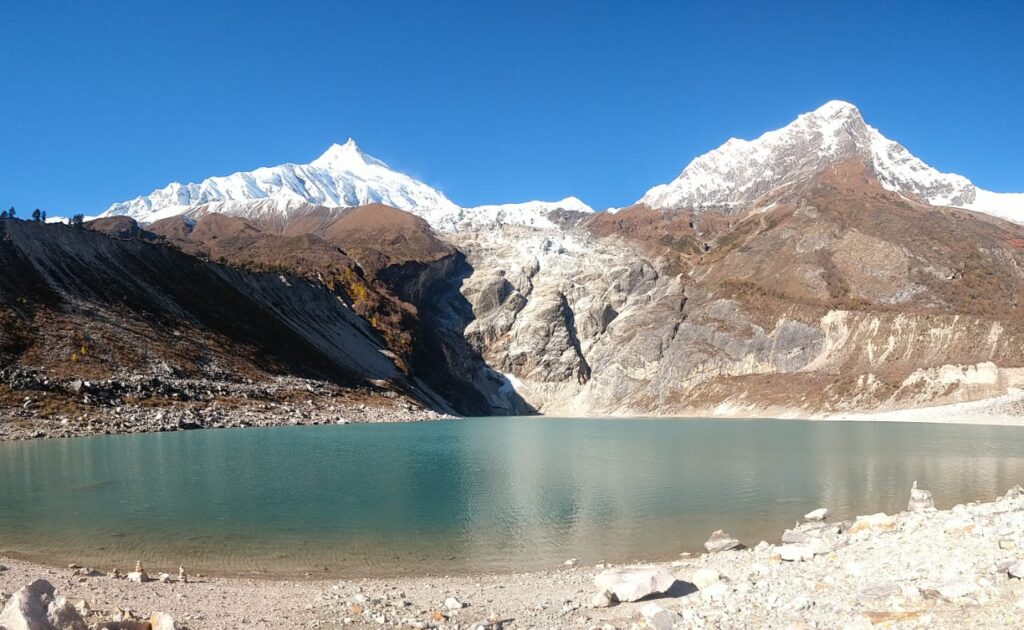
Manaslu Circuit Trek
Physical training before the trip should begin no later than 2 months before, as you will have a height of 3,000 meters above sea level and more. Hiking is from 6 km daily with an average pace that can be maintained for hours. It is important to have physical fitness & endurance. You will also need the right gear and clothes according to the weather.
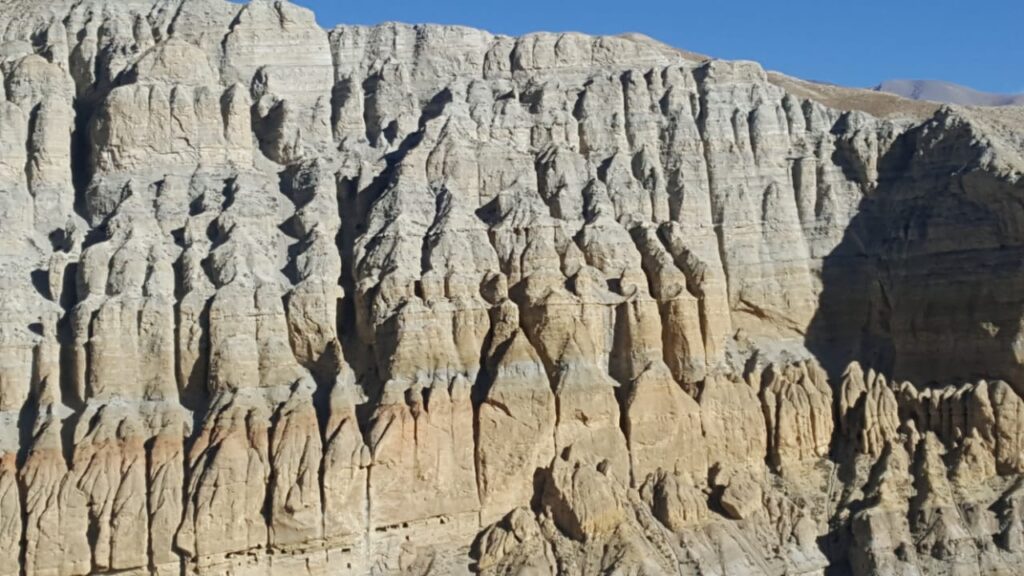
Upper Mustang Trek
You need to have good physical condition and be in top form. You’ll also require the right clothes for weather conditions and food items such as snacks or lunch breaks from your hiking adventure; water is essential too! This type of activity takes time, so ensure you’re physically able to get enough rest before starting any trips.
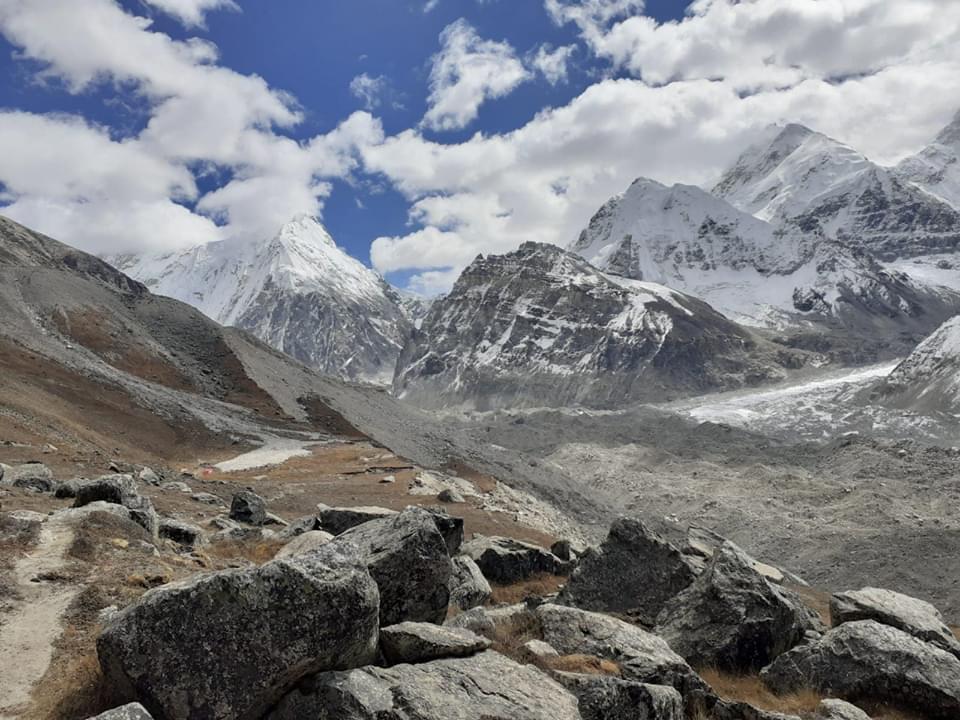
Kanchanjunga Base Camp Trek
Experience app by adding shalomtreks on your homescreen..
Spirit of Himalaya Adventure
Nepal Trekking Permit Cost
- You are here:
Nepal Trekking Permit
- Mar 31, 2024
Table of Contents
Nepal is an ideal choice for trekking enthusiasts, offering an array of eye-catching trails that traverse through breathtaking landscapes. Most of the trending trekking trails Everest Base Camp , Langtang are nestled inside the country’s precious National Parks and Conservation areas, making trekking permits an essential requirement. Before heading out on a trekking adventure, you must be familiar with the necessary trekking permits and fees . So, this post is prepared to focus on trekking permits and fees in Nepal , providing vital information to understand these requirements easily.
Trekking Permits include more than just granting entry into the national park and conservation area. More likely, the permits serve as crucial elements for your safety during treks. So, there are other trekking permits for specific reasons and regions. These permits are issued for various reasons, such as promoting responsible tourism and supporting local communities, along with trekking routes. Other permits include TIMS (Trekkers’ Information Management System) permits, tracking trekkers, and assisting on the route. Moreover, some areas are classified as restricted areas, demanding specialized permits to protect unique cultures and environmental heritage. Additionally, there are permits issued by rural municipalities to support sustainable development.
Every permit plays a vital role in safeguarding trekkers, preserving the pristine culture and beauty of Nepal’s landscape, and ensuring responsible tourism practices. Now, let's talk in-depth about the required trekking permits and fees, along with the documents required and why they are important.
Why Trekking Permits Are Important in Nepal
Trekking permits serve a key role in ensuring a safe and sustainable trekking experience. Here are some reasons why trekking permits are important in Nepal. Trekkers need to follow the following conditions:
- Environmental Conservation and Protection: Trekking permits help fund environmental efforts and conservation plans for national parks and protected areas.
- Cultural Preservation: Special permits in restricted areas help preserve the distinct culture and heritage of indigenous communities.
- Safety and emergency support: In case of an emergency, the authorities can track trekkers and assist, ensuring safety throughout the journey.
- Responsible Tourism: Trekking permits help regulate the number of trekkers in specific regions, avoiding overcrowding and minimizing the impact on ecosystems.
- Supporting Local Communities: Permit fees contribute as charity for the rural and remote areas on health services, education, infrastructure development, livelihood improvement, and so on.
- Route Management and Information: The various permits help in recording trekking activities, which aids in trial management and the overall trekking experience.
- Compliance with Legal Requirements: Trekking permits are made mandatory by the Nepal Government for the sustainable development of the tourism industry.
How Long Does It Take to Get a Trekking Permit?
Well, you can get all trekking permits within one day , along with requiring documents. Some trekking permits can get an instance of application and others need at least a day. Suppose a TIMS Card (compulsory for all trekking routes but regulated at Langtang Region only) can be within a few minutes after being online submitted from the authorized trekking agency . Likewise, conservation area permits also will be ready within a few hours after applying online submitted gist , at the counter trekking permits at Nepal Tourism Board . Other permits, like local government permits , can be bought on the way to the trip with your passport details and passport photograph. National park permits for Everest Base Camp Trek , and Langtang Valley Trek also can be on the trail Check post, if you are not buying at Kathmandu.
The Restricted area trekking permits for the Upper Mustang , Upper Dolpo, Manaslu Circuit Trek , Simikot, Tsum Valley Trek, Kanchenjunga Base Camp Trek , etc. will be ready within a business day; hence Saturday is a public holiday in a week and they will be some festival celebration as holiday also. To make sure, take a look Nepalese calendar.
Do We Need to Present While Obtaining Trekking Permits?
No! You do not need to go for the permits, you will be fre e on your own; just provide the required documents rest of the processing is handled by the trekking agency . But if you would like to know more information about it then you can attend also.
Types of Trekking Permits and Fees in Nepal
We've already talked about permits and how important they are. Here, we are going to talk in detail about Trekking permits and fees. Also, we will be talking about where you can get it.
1. TIMS Permits
TIMS , known as the Trekkers’ Information Management System, is an important permit for trekking in Nepal. It collects a database of trekkers and their itineraries, which helps in ensuring safety during trekking journeys. It also helps in rescue operations by providing valid information about trekkers during emergencies.
It was first introduced in 2008 by TAAN (Trekking Agencies Association Nepal) , in joint partnership with the Nepal Tourism Board (NTB). Furthermore, On April 1st, 2023, NTB made the TIMS permit mandatory. For groups of expeditions of mountains and helicopter tours, TIMS is not required. But if the helicopter tour is one-way, then it requires a TIMS permit.

Where can one obtain a TIMS Permit?
A TIMS permit can be obtained from the head office of TAAN in Kathmandu as well as in Pokhara. The documents required for the TIMS are a valid passport , passport-size photographs , and relevant details about the trekking itinerary .
What is the fee for obtaining a TIMS Permit?
The fee for obtaining a TIMS permit varies depending on the country. For the SAARC countries , the permit is charged at Rs 1000, which is around $8 to 10 per person . In third countries, it is generally Rs 2000 , which is approximately $16 to 20 per person or according to the following day’s exchange rate.
*Note: The age upto 10 does not require TIMS but the information is collected online.
2. National Park Permits
The National Park Permits are the permits that grant access inside the perimeter of a specific National Park. It is not just essential for trekking activities; if you want to visit the National Park, a permit is necessary. These permits serve as a way to manage and regulate the flow of tourists and maintain the ecological aspects of National Parks.
Furthermore, the fees collected from the permits contribute to the conservation and protection of the respective parks. Also, the fund is utilized for various activities like trail maintenance, wildlife protection, and conservation efforts.

Where can you get National Park Permits?
A national park permit can be obtained from the board office of the Nepal Tourism Board in both Kathmandu and Pokhara. For convenience, you can get a permit from the respective park office or entry point to the park. The documents required for the permit are valid passport details, a passport-size photo, and information about trekking routes and duration. While trekking in the Khumbu area for the Everest Base Camp Trek, Gokyo Lakes Trek, Everest 3 Passes Trek , Chola Pass Trek, etc. can buy Sagarmatha National Park permits at the entrance gate Manjo Village and Langtang National Park at the entrance gate of Dhunche.

The permits are valid for a specific period or until you get an ‘Exit’ stamp on your permit. And it is for single entries only . The permit is required by the government, and if you fail to present a genuine permit, it can lead to penalties.
National Park Permits Fee
The table below displays the permit fees of specific National Park in Nepal:
3. Conservation Area Permits
Conservation Areas in Nepal are established under the National Park and Wildlife Conservation Act to conserve flora and fauna, the livelihood of indigenous people, and cultural and religious values. There are a total of six conservation areas with distinct geography and biodiversity. Also, a valid permit is required to enter the specific conservation area.

The primary purpose of Conservation Areas in Nepal is to preserve and protect the diverse ecosystem, wildlife, and natural resources within their boundaries. Each Conservation area is known for its unique features and characteristics. For example, Annapurna Conservation Area is famous for its diverse biodiversity with rare flora and fauna, while Manaslu Conservation Area is rich in cultural and religious value, and Kanchenjunga Conservation Area showcases the stunning landscape and remote villages.
Where can you get Conservation Area Permits?
Conservation Area permit s can be obtained from the head office of Nepal Tourism Nepal. As usual, the head office is available in both Kathmandu and Pokhara. The documents required to obtain a permit are a valid passport, passport-size photographs, a Guide and Porter name list, and details of the trekking route.

Likewise, permit funds are utilized for maintaining trekking trails, saving culture and tradition, and protecting diverse ecosystems. It is recommended to get a permit from the head office because, at the entry point, the authority charges double the price as penalties if you fail to present a valid permit. The permit is for single entry only.
Conservation Area Permit Fee
The permit fees for the Conservation Area are provided below table:
*Note: Travelers Below 10 Years Does Not Require Permits.
4. Wildlife Reserve And Hunting Reserve Permit
Wildlife reserves and Hunting Reserves are two different reserve areas designated for different reasons in Nepal. There is only one wildlife reserve and one hunting reserve; they are Koshi Tappu Wildlife Reserve and Dhorpatan Hunting Reserve . They both require permits for trekking as well as other activities.
As both have different purposes, Koshi Tappu Wildlife Reserve serves to conserve and protect wildlife species and their natural habitats. Other programs include anti-poaching operations and wildlife monitoring with government agencies, conservation organizations, and local communities. The reserve also offers tourism activities like wildlife safaris, bird watching, and trekking.
Whereas Dhorpatan Hunting Reserve is the only hunting reserve in Nepal. The main purpose of this reserve is to manage and regulate controlled hunting activities sustainably. Hunting is permitted only in this area to maintain the balance in the ecosystem by controlling population numbers and collecting revenues.
Where can you get Wildlife Reserve and Hunting Reserve Permits?
Koshi Tappu Wildlife Reserve ’s permit is available at the Nepal Tourism Board (Kathmandu and Pokhara) or the entry point of the reserve. Dhorpatan Hunting Reserve’s permit can be obtained from the Department of National Park and Wildlife Conservation in Kathmandu. Also, it is available at the head office of Dhorpatan Hunting Reserve , which is located in Baglung .
Wildlife Reserve and Hunting Reserve permit fee.
The permit fees for the wildlife reserve and hunting reserve are below:
*Note: Below 10 years is free.
Hunting permit fee in Dhorpatan Hunting Reserve.
Hunting permits are different from regular permits in the Dhorpatan Hunting Reserve . Moreover, legal papers and a special permit are required before beginning hunting activities. The permit can be applied for at the Department of National Park and Wildlife Conservation in Kathmandu and the Dhorpatan Hunting Reserve Office in Baglun g.
Dhorpatan Hunting Reserv e allows hunters to hunt Blue Sheep and other game animals. It will cost you $2,000, including the license and local permits. But if you want to step up your hunting game, it will cost $8,900 for one Himalayan Tahr.
5. Restricted Area / Special Permit
Nepal has some areas classified as restricted areas , requiring special permits for entry. These restricted areas are often located in remote and sensitive regions with unique cultures, traditional settlements, and geopolitical significance. A special permit helps in monitoring and managing tourism activities to protect the fragile ecosystem and Flora and Fauna.
Restricted Special Permits often have higher fees compared to regular trekking permits. The reason for higher fees is to enhance the traditional settlements by modernizing and developing the infrastructure and lifestyle of the people. Furthermore, special permits ensure responsible tourism practices, respect local customs, and follow conservation guidelines.

Where can you get Restricted Area Special Permits?
A special permit is issued by the Nepal Government for the restricted areas. The permits can be collected from the Department of Immigration after fulfilling specific requirements. The Department of Immigration office in Kathmandu is established in different regions of Nepal; however, it is recommended to prepare a special permit in Kathmandu.
What Documentations are Required to Obtaining Special Permits for Restricted Areas in Nepal?
The requirements for a special trekking permit include traveling with registered trekking agencies and being accompanied by a licensed trekking guid e, must be two trekker s. FIT (Free Individual Trekkers) are strictly prohibited , the restricted are regulated by the Government of Nepal. Other documents such as a valid original passport and details regarding trekking routes are required . For restricted trekking, you are not allowed to go as FIT ( Free Individual Trekkers ), you need to Hire at least a professional trekking Guide from the authorized trekking company.

Only Authorized Trekking Company can apply for trekking permits along with the following documents:
Submit the Online application form (trekkers Passport number and Nepal Visa Number) accordingly and print out the gist, attached along with these documents below;
- Copy of Passport and Visa, which must be validated for entire trekking days
- Name lists of trekkers
- Trekking Program Schedule with Date
- Guarantee letter of Agency
- Agreement with Agency
- Program schedule of trekking
- Voucher of Bank Payment (fees in USD) for Permits
- Tax clearance Certificate of Trekking Agency's latest fiscal year
- Insurance of the trekkers (foreign nationals) and Nepalese staff name list accompanying the trekkers with specific trekking area valid during the trek
- The license issued by The Ministry of Tourism, Culture, and Civil Aviation to operate a trekking business
- License issued by Nepal Rastra Bank ( Central Bank of Nepal) allowing exchanging of foreign currencies
- Registration Certificate of Permanent Account Number (PAN/VAT)
- Original Passport of every trekker asked by the Immigration officer, although you have submitted your passport details while obtaining a Nepal Visa
Restricted Area’s Special Permits Fees.
As mentioned above, special permit fees are higher than regular permits. The cost of special permits is the breakdown below table:
*Note: No trekking permit is required below 10 Years Child. **Note: Trekking fee for every country the special permits are the same including SAARC countries. ***Note: In the case of Upper Mustang and Upper Dolpa Region, if the royalty paid for the mountain expedition is less than the fee for the trekking permit then the difference amount should be paid.
6. Rural Municipality Area Permit.
A rural municipality area permit is somehow similar to a special permit for a restricted area. The difference is that it grants access to some of the rural parts of Nepal that are still untouched by developments and modernization. This permit introduces the lifestyle, unique settlements, and daily routine of rural people.
The purpose of the Rural Municipality Area Permit is to improve the lifestyle, medical and educational facilities, and environmental conservation of the area. Every rural municipality has its characteristics and features, with distinct ethnic groups. Trekking in this area is a different experience than other popular trekking routes.

Where can you get Rural Municipality Permits?
Rural Municipality permits are distributed by the Department of Immigration, just like restricted area permits. Somehow, some permits can be obtained at the entry point to the area. The local government permits for Everest Trekking known as " TREK CARD " , which can be obtained at the Check post of Pasang Lhamu Rural Municipality at Lukla/Namche . Likewise, registered travel agencies are recommended to prepare the permit. The essential documents for making permits are a valid passport, passport-size photos, and a relevant trekking itinerary. If these trekking areas are regulated by the Government of Nepal , it is also in the Restricted Area . Those trekking permits also must be obtained according to the rule of the Restricted Area Permits .

Rural Municipality Area Permits Fee.
The below table shows the region along with the name of the rural municipality and their permit fees respectively:
Nepal offers countless trekking trails across the country with different landscapes and vibrant cultures and traditions. So, before heading towards your memorable journey through the Himalayas, it is crucial to obtain legal papers and specific permits for the area. Therefore, get the required permits for a stress-free journey and be a part of the development of the country. If you are traveling solo or with a group family or couple we at Nepal Mother House are glad to organize trekking permits according to your requirements. Thank you.

I hearty welcome to Nepal, known as the Kingdom of Himalayans, and the roof of the World “Mt. Everest.” Nepal has been named a Heaven on Earth and is a wonder in the Himalayan. It is the Shangri-La, a cultural Museum, the Birthplace of the Lord Buddha, and the country of the living Goddess “ Kumari .”
I am Karna Rana Trekking Tour Operator and Mountain Guide, specializing in Trekking , Tour, Travel in Nepal, Hiking in the Himalayan and other Outdoor Activities, Peak Climbing , Expedition, Adventure Trekking , Rafting, etc. applying for my field expiring in 2000. Meanwhile, I have completed my Master’s degree in Rural Development (2016) from the Tribhuvan University of Kathmandu, Nepal’s leading educational institution. I have been applying my field experience in tourism, especially in remote areas of the country, for sustainable eco-tourism for local empowerment. I enjoyed writing my blog own word sharing my travel experience in the Himalayan, aiming to provide the right information and help to the Nepal Traveler.
If you are curious regarding articles and further information, kindly drop a message below the box.

Ask a Question
Latest travel posts.

30 Picturesque Places to Visit in Nepal

Ultimate Upper Mustang Trekking Guide

Best Top 10 Monsoon Treks in Nepal
- (+977) 9803397710 Call / WhatsApp / Viber
- [email protected]

- Your cart is empty
- Restricted Region

Restricted Region Trekking
“Restricted Region Trekking” in Nepal refers to trekking in specific areas of the country that are subject to special regulations and permits due to their sensitive nature, cultural significance, or geopolitical considerations. These regions are often located in remote and less-visited parts of Nepal, offering unique and pristine trekking experiences. The restricted region trekking areas are typically characterized by their rich cultural heritage, diverse landscapes, and limited access, which helps preserve their natural beauty and cultural integrity.
Trekking in these restricted regions usually requires obtaining a special permit in addition to the standard trekking permits that are required for most treks in Nepal. These permits are issued by the Nepali government and are designed to control the flow of tourists into these areas, in order to minimize environmental impact and maintain the authenticity of local cultures.
Restricted Region Trekking Key features.
Restricted region trekking in Nepal comes with several key features that make it a unique and exceptional experience for trekkers. These features are often what draw adventurous travelers to these remote and culturally rich areas:
Cultural Authenticity : Restricted regions are often home to indigenous cultures and traditions that have remained relatively untouched by modern influences. Trekking through these areas allows you to experience authentic customs, rituals, and ways of life that have been preserved for generations.
Less Crowded Trails : Since these regions require special permits and often have limited access, the number of trekkers is significantly lower compared to popular trekking routes. This leads to a more serene and peaceful trekking environment, where you can truly connect with nature and the local culture.
Pristine Landscapes : The landscapes in restricted regions are often untouched and offer stunning natural beauty. From barren deserts to lush forests, high mountain passes to tranquil valleys, each region has its own unique terrain to explore.
Rich Biodiversity : These areas can host a diverse range of flora and fauna due to their isolation and varying altitudes. Trekking through these regions gives you a chance to encounter rare and endangered species of plants and animals.
Historical and Spiritual Sites : Many restricted regions boast ancient monasteries, temples, and historical sites that hold spiritual significance for the local communities. These sites provide a deeper understanding of the region’s history and religious beliefs.
Cultural Interaction : Due to the lower number of trekkers, interactions with local people can be more personal and meaningful. This offers the opportunity to engage with the community, learn about their way of life, and share cultural exchanges.
Preservation of Environment : The restricted access to these areas helps in preserving the natural environment and preventing over-tourism. This sustainable approach ensures that the delicate ecosystems remain relatively undisturbed.
Challenging and Adventurous : Trekking in these regions often involves crossing high mountain passes, traversing challenging terrains, and enduring varying weather conditions. This appeals to trekkers seeking a more adventurous and physically demanding experience.
Unique Photography Opportunities : The untouched landscapes, traditional architecture, and vibrant cultures provide ample opportunities for capturing stunning photographs.
Sense of Exploration : Trekking in restricted regions feels like embarking on a journey of exploration and discovery, as you tread on less-frequented paths and immerse yourself in remote landscapes.
It’s important to note that trekking in restricted regions requires careful planning, adherence to regulations, and respect for local cultures and the environment. Trekkers are often required to hire a licensed guide and obtain the necessary permits, which helps support the local communities and ensure responsible tourism practices.

Dhaulagiri Circuit Trek

Kanchenjunga Circuit Trek

Upper Dolpa Trek

Makalu Base Camp Trek

Kanchenjunga Base Camp Trek

Rolwaling Valley Tsho Rolpa Trek
Stories, tips, and guides.

Best 5 Popular Trekking In Nepal

Best Hiking Trail Near Kathmandu

World Tigers Day: Exploring the Conservation Efforts to Save These Magnificent Beasts

How Tall is Mount Everest? The Ultimate Guide

Get special offers, and more from Traveler
Subscribe to see secret deals prices drop the moment you sign up!
Enter the e-mail address associated with the account. We'll e-mail a link to reset your password.

Have Questions? Ask ( Dambar )
+977 985 103 3819
TRAVEL EXPERIENCE DESIGNER

14-DAY EVEREST BASE CAMP TREKKING
3 hours Everest Base Camp Helicopter Tour
12 Days Short Everest Base Camp Trek
10-day Everest Trek with Helicopter Return
11 days Everest Helicopter Trekking
20 Days Everest Three High Passes Trekking
13 days Gokyo Valley Trekking
18 days Chola Pass Trekking
14-day Renjo-La Pass Trekking
9 days Everest Panorama Trekking Package
19-day Jiri to Everest Base Camp Trek
10 days Everest Family Trekking
11 DAYS ANNAPURNA BASE CAMP TREK
12 days Annapurna Circuit Trekking
Mesokanto Pass Trekking
8 Days Short Annapurna Base Camp Trek
9 days Mardi Himal Trekking
Ghorepani Poon Hill Trekking
Annapurna Luxury Trekking
17 Days Upper Mustang Trekking
Annapurna Base Camp Helicopter Tour
Annapurna Family Trekking
Jomsom Muktinath Trekking
Short Annapurna Trekking Trails
Langtang Helicopter Tour
11 days Langtang Valley Trekking
Lauri Binayak Pass Trekking
Tamang Heritage Trekking
Helambu Trekking
Chisapani Trekking
14 Days Manaslu Circuit Trekking
15 Days Tsum Valley Trek
Manaslu Short Budget Hiking
19-day Nar Phu Valley Trekking
Upper Dolpo Trekking 22 days
Lower Dolpo Trekking
28 days Kanchenjunga Base Camp Trekking
Guerrilla Trekking
- 4 days Tibet Culture Tours
- Mount Kailash
- Bhutan Trekking
- Nepal Bhutan Tour
- 10 Days Bhutan Culture Tour
Everest takes the lead as the favored destination
- Trekking Popular for Trekking
- Climbing Adventurous Experience
- Tour Explore Best of Nepal
- Short Treks
- Wildlife Safari Tours
- Helicopter Tours
- Mountain Flights
- Cultural Tour
- Muktinath Tour
- Mustang Jeep Tour
- Nepal Paragliding Tour

#1 Most Selling Trip in Nepal

#2 Most Selling Trip in Nepal

#3 Most Selling Trip in Nepal

#4 Most Selling Trip in Nepal

Kathmandu Pokhara Chitwan Lumbini Tour
#5 Most Selling Trip in Nepal

11 days upper Mustang Jeep Tour
#6 Most Selling Trip in Nepal

15 days Island Peak Climbing

18 days Mera Peak Climbing

Chulu East Peak Climbing

Chulu West Peak Climbing

Lobuche Peak Climbing

Tent Peak Climbing

Muktinath Helicopter Tour

Nepal Muslim Travel and Tours

12 days Nepal Bhutan Tour Package

13 days Mt. Kailash Tour
- Why Boundless Adventure
- Company Documents
- Responsible Tourism
- Banking Details
- Booking Terms and Conditions
Adventures In Restricted Trekking Area Nepal
5 October, 2023 By Dambar Khadka
Adventures In Restricted Trekking Area Nepal is a beautiful country in the foothills of the Himalayas, between India and China. As open and warmly welcoming as it has always been to tourists, there used to be some remote trekking areas restricted to foreign visitors until 1991 A.D.
After the multiparty democracy in Nepal and the promulgation of the new constitution for Adventures in the restricted trekking area of Nepal,
Some of those areas were made accessible to foreigners. However, adventures are in the restricted trekking regions of Nepal. It would require restricted permits to trek to Adventures in the restricted trekking area of Nepal.
The visitors need to book the excursion through a trekking company only and get a license through a series of applications and guarantee letters that come the way. Also, the trekkers are not allowed to trek individually in every restricted area of Nepal.
You need to join a group (If you are solo) of at least two people, and you should have a local and experienced trekking guide. The local trekking trails are beautiful as they have hidden valleys, natural green forests, and some national parks and help you discover the local culture and tradition.
Every Adventure-restricted trekking area in Nepal is best. Here are some of the famous Adventures in the restricted trekking region of Nepal. You may contact Boundless Adventure for trekking permits, guides, information on adventures in restricted trekking areas in Nepal, and adventure activities.
- 17-Day Upper Mustang Trekking trail at Adventures in restricted trekking areas in Nepal.
- 16 Days Manaslu Trekking Trail, Adventures In Restricted Trekking Area Nepal
- 19 Days Tsum Valley Trekking Trail, Adventures In Restricted Trekking Area Nepal
- 28 Days Kanchenjunga Trek is an adventure in a Restricted Trekking Area in Nepal.
- 23 Days Upper Dolpo Trek is an Adventures In Restricted Trekking Area in Nepal.
- 20-Day Nar Phu Valley Trek Adventures In Restricted Trekking Area Nepal.
- 14 Days Lower Dolpo Trekking Adventures In Restricted Trekking Area Nepal.
Upper Mustang Trekking Adventures In Restricted Trekking Area Nepal
The Adventures in restricted trekking area Nepal, At the height of 3840m, known as the last Forbidden Kingdom, is the Upper Mustang with its own Tibetan culture retained over the years as people have less contact with the outer world. The place is very rich in history and tradition.
Chances of rainfall in these upper parts are meager, so they tend to remain dry, while the lower part receives comparatively more rainfall. The Tiji festival is trendy in the Upper Mustang Trekking, which is another advantage of your trip, even though it lies in the Annapurna conservation area of Nepal.
You can visit the royal palace and monasteries built in the 15th century, walk through the narrow alleyways and hidden shortcuts, and be mesmerized by everything you can see there. You can also visit the Amchi Museum and learn about the cultures, traditions, and lifestyles.
Along with enjoying the moment, you can also learn about so many things on your visit and return within 14 days. You can also travel to Mustang by 4ward Jeep in about a week and 4 hours by Helicopter tours from Kathmandu to Mustang and Back to Kathmandu.

Adventures In Restricted Trekking Area Nepal Of Manaslu Trekking
In Nepal, Mt. Manaslu is 355 degrees northwest of Kathmandu—adventures in a restricted trekking area. Manaslu trekking has two options: one by bus/jeep, and the other by helicopter. Manaslu trekking is considered one of the best as it lets you get close to Mt. Manaslu, the eighth-highest mountain in the world at 8163m. Nepal’s untouched region provides beautiful scenery, landscapes, rivers, waterfalls, forests, and mountain ranges in the Manaslu Conservation area .
Table of Contents
You will see various floras and faunas, wild endangered species like snow leopards, and also learn about the animal yak, which is popular and primarily used in these areas. You can enjoy the view of mountain peaks like Mt. Manaslu, Mt. Annapurna II, Mount Lamjung Himal, Mount Gorkha Himal, Birendra Lake, Mount Ganesh Himal, Mount Langtang Himalayan range, and Dud Kunda.
As the place is rich in natural scenery, biodiversity, and culture, you can explore and learn about them as much as possible.

Tsum Valley Trek, Adventures In Restricted Trekking Area Nepal
The Adventures in restricted trekking area Nepal, Tsum Valley, is situated high up in the Manaslu region and is one of the most secluded valleys in Nepal. It is a sacred pilgrimage valley rich in ancient culture, tradition, and art. The people in the Tsum Valley region follow Tibetan Buddhism and speak their language.
As it had remained secluded, its beauty remained untouched and fresh, offering the best views of mountains like Ganesh Himal, Shringi Himal, and Boudha Himal along the way. The starting point of the trekking is Aarughat, the same as Manaslu trekking, and the same conservation permits are required.
To reach the Tsum Valley, you will go through oak forests, trek through Budi Gandaki, enjoy the rivers with waterfalls, and walk across bridges that help you pass through.
You will also be able to see the Tibetan Buddhist people, monks, monasteries, and villages and know their culture. You can also visit one of the valley’s sacred caves, PirenPhu. The cave is very famous in Tsum Valley .

Nar Phu Valley Trekking, Adventures In Restricted Trekking Area Nepal
The Adventures in restricted trekking area Nepal The Nar and Phu are two different valleys. Still, we can trek through these two other areas simultaneously with permits, which is why Nar and Phu’s villages are combined as Nar Phu Valley trekking.
You can journey through the Nar Phu Valley trek to the wild and remote vicinity north of Annapurna. You will walk through the routes of the Annapurna circuit trail and the trail split from KOTO, just before Chame. The path to reach the valley is located north of Manang.
Nar Phu Valley allows you to see and experience medieval Tibetan culture with different mountain views and all the alpine sceneries in undisputed form. You can explore Annapurna’s most untouched and remote region and enjoy the local culture and customs. Similarly, it would be best to have Nar Phu Valley trekking and ACAP permits .

Kanchenjunga Trekking, Adventures In Restricted Trekking Area Of Nepal
The Adventures in restricted trekking area Nepal, Kanchenjunga Trekking is one of Nepal’s most peaceful regions as the trekking trail is comparatively more silent than other trekking trails. It takes you to the height of 5143 meters at the base camp of the world’s third-highest mountain but second in Nepal, Kanchenjunga.
You can experience spectacular views of the high alpine landscape and beautiful mountains like Kanchenjunga Base Camp, Jannu, Makalu, and Mt. Everest. You can also explore the Yalung Glacier and the terraced fields of the hilly region of Nepal. The pristine rhododendrons, bamboo, local hidden culture and community, and pine forests are the major attractions of the Kanchenjunga region .
As the area falls on restricted trekking regions in Nepal, you must have special permits to go to Kanchenjunga Base Camp Trekking .

Upper Dolpo Trekking, Adventures In Restricted Trekking Area Of Nepal
The Adventures in restricted trekking area Nepal, Located in the northwestern part of the country, Upper Dolpa lies in the lap of the Dhaulagiri Himalayas. The Upper Dolpo and Lower Dolpo regions are some of Nepal’s most remote trekking destinations. Upper Dolpo Trekking Adventures in Nepal’s trekking area was restricted until 1989 A.D.
The trekkers will get to explore the spectacular landscape, rich culture and tradition, and beautiful settlement of the local people of the Dolpo region of Nepal. Some of the biggest attraction sites for Adventurers in the restricted trekking area of Nepal are the Shey Phoksundo National Park , Shey-Phoksundo Lake, and Vihar Monastery. You will reach a height of 4,530 meters as you trek to this preserved region of Nepal.

Conclusion Of Adventures In Restricted Trekking Areas of Nepal
Trekking to the restricted area of Nepal can be adventurous and exciting. You will get to explore the different sides of Nepal’s nature with the most incredible views of the remote places and collect once-in-a-lifetime memories.
Importantly, you must ensure you carry some excellent trekking equipment measures and get a permit before starting your trekking. It is always a perfect option to explore the beauty of the restricted trekking areas of Nepal by pre-planning a trek.
Boundless Adventure and our crew have always been a success for the trip in every restricted trekking area of Nepal. Contact us for adventures in the restricted trekking region of Nepal.
Dambar Khadka
Dambar Khadka, a passionate adventurer and the founder of Boundless Adventure Nepal, has spent his entire life writing about nature and Nepal's developing tourism business. Dambar's passion with nature and its different cultures began as a child in Nepal's stunning landscapes. He began writing following successful treks and expeditions across Nepal, Tibet, and Bhutan. Dambar Khadka created Boundless Adventure Nepal in 1992 to share the majesty of the Nepal Himalayas with the rest of the planet. As an explorer and writer, he is committed to responsible tourism and cultural connection, allowing readers and adventurers to immerse themselves in Nepal's enchantment through his works.
Ask Question
Recent blogs.

The Highest Lakes In Nepal

Culture And Traditions In Nepal

Money Exchange In Nepal

How Much Does It Cost To Climb Everest

Festivals Of Nepal

What is the Cheapest Way to Trek in Nepal?

Kathmandu to Mardi Himal Trek

How To Get A Permit For The Mount Kailash Tour From Nepal

7 Best Trek For Beginners In the Himalayas

How Difficult Is the Nar Phu Valley Trek

Best Top 10 Budget-Friendly Treks

9 Best Ways to Book A Helicopter Tour Service In Nepal

Best Helicopter Tour Services in Nepal

8 Best Tips For Kathmandu To Ghandruk Trek

Get From Kathmandu to Syabrubesi by Bus, Car, or Private Jeep
- Why Trek With Us
- Legal Documents
- Terms & Condition

Viber/Whats App
Obtaining trekking permits in nepal: a guide for trekkers.
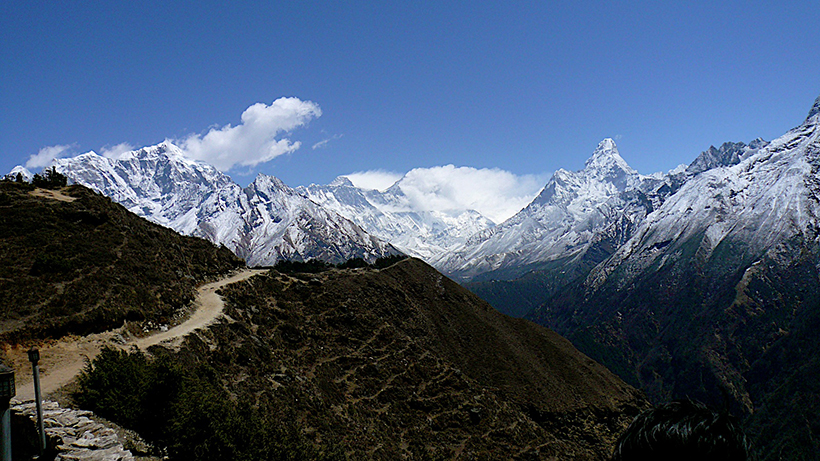
Nepal is a beautiful small land-locked country. The country is abundant with numerous snow-capped mountains and mountain ranges ranging from the east to the west. Trekking in the various regions of Nepal allows one to discover a unique culture, & tradition, experience the newness in every region, and the natural beauty in its original form.
To trek in Nepal, one needs to obtain a compulsory trekking permit. In addition to a trekking permit, one may also need to obtain other permits, depending on the region visiting and the activities one will be doing. For example, if one is planning to visit a restricted area, a national park, or a conservation area, one needs to obtain an additional Restricted Area permit or National Park or Conservation Area Permits.
Trekking permits are required for all trekking routes in Nepal, including popular routes such as the Annapurna Circuit and the Everest Base Camp Trek. The cost of a trekking permit depends on the route and the duration of the trek. The permit fees for the trekking routes in the different regions of Nepal are implemented by the Trekking Agencies’ Association of Nepal (TAAN) . We have listed the essential permit fee lists of trekking routes from the east to the far western regions of Nepal.
Kanchenjunga Region:
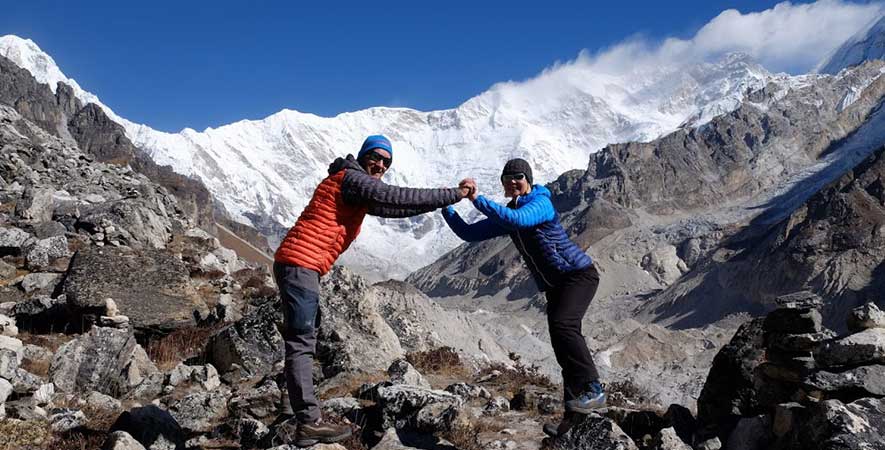
Kanchenjunga Region is popular for Kanchenjunga Circuit Trek or Kanchenjunga Base Camp trek . The essential permits are Kanchenjunga Conservation Area Permit (KCAP), and Kanchenjunga Restricted Area Permit (RAP).
Kanchenjunga RAP Fee
- USD 20 per person/week (for the first 4 weeks)
- USD 25 per person/week (beyond 4 weeks)
Kanchenjunga Conservation Area Permit (KCAP)
- Foreigners- NPR 2000/person
- SAARC- NPR 500/person
Makalu Region:
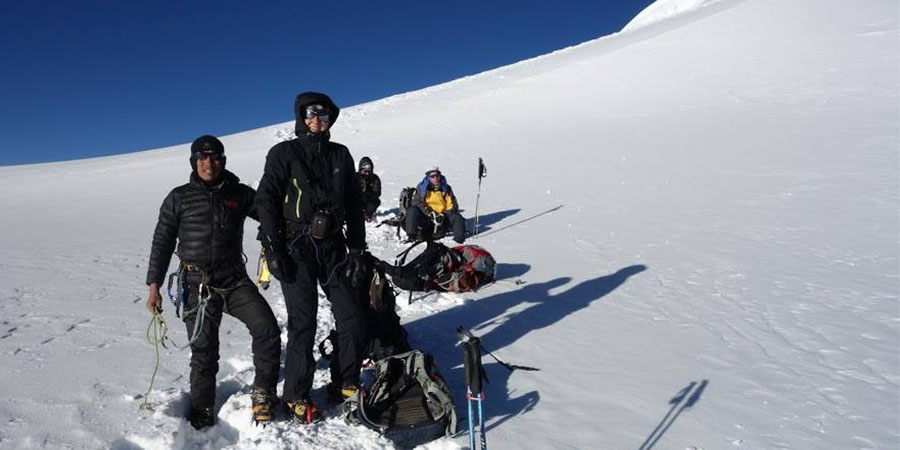
Makalu Base Camp Trek , Arun Valley Trekking, Makalu to Amphu Lapcha, Milke Danda Trek, and Arun to Hungku Valley Trek are some of the popular treks in the Makalu region. The required permits are:
Makalu Rural Municipality Permit
- NPR 2000 per person
Makalu Barun National Park
- Foreigners- NPR 3000
- SAARC- NPR 1500
Everest Region:
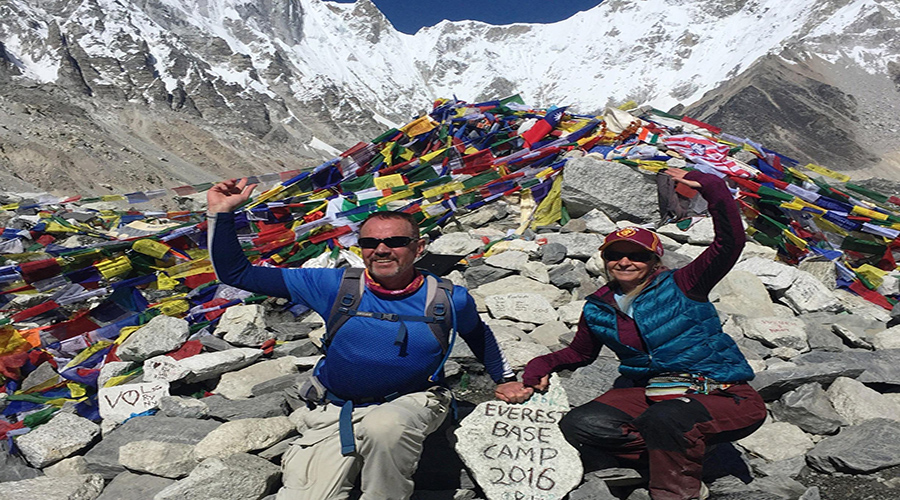
The most renowned region for trekking in Nepal is the Everest region. Everest Base Camp trek, Jiri to EBC Trek, Gokyo Lake Trek, Everest Three Pass Trek, and Everest Panorama Trek are some of the famous treks in this region. The required permits are Khumbu Rural Municipality Permit and Sagarmatha National Park (SNP).
Khumbu Rural Municipality Permit
- Foreigners- NPR 2000
- SAARC- NPR 1000
Sagarmatha National Park (SNP)
Rolwaling Region:
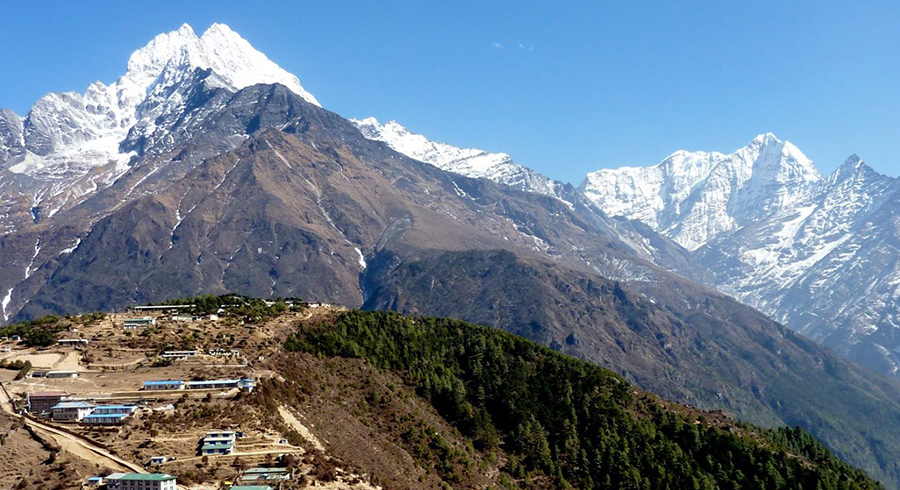
This region is adjacent to the famous Everest region. It falls under the Gaurishankar Himalaya Range. Rolwaling Region is known for its natural beauty and its diverse flora and fauna. Rolwaling Valley Trek is popular in this region. Gaurishankar Conservation Area Project (GCAP) and Rolwaling Special Permit are required permits.
Rolwaling Special Permit Fee
- USD 20 per person per week
Gaurishankar Conservation Area Project (GCAP)
Langtang Region:
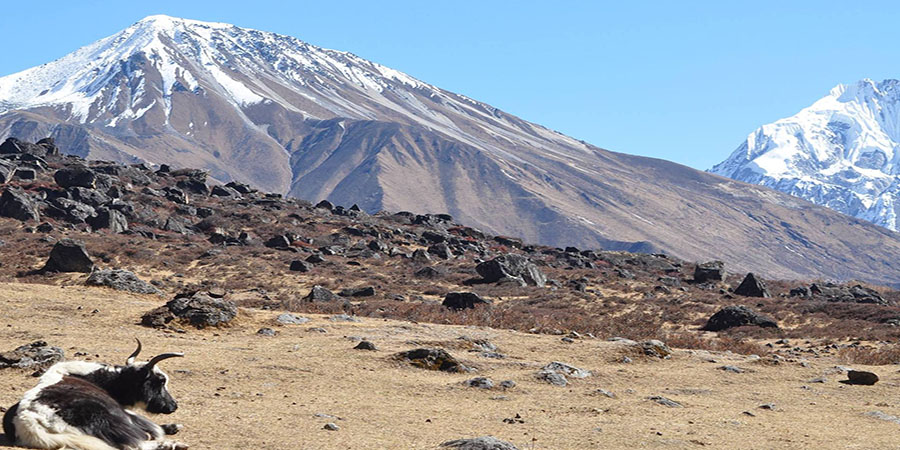
Langtang Ganja La Pass Trek, Goasaikunda Trek, Helambu Trek, Langtang Valley Trek, Tamang Heritage Trail are most popular treks in the Langtang region. We required Langtang National Park (LNP) and Trekkers Information Management System (TIMS) permits. TIMS permit is classified into three groups.
Trekkers Information Management System (TIMS)
- Green TIMS (individual trekkers) - USD 20 per person
- Blue TIMS (organized group trekkers) - USD 10 per person
- Pink TIMS (SAARC individual trekkers) - USD 6 per person
- Pink TIMS (SAARC group trekkers) - USD 3 per person
Langtang National Park (LNP)
- Foreigners- USD 30/person
- SAARC- USD 15/person
Ganesh Himal Region:
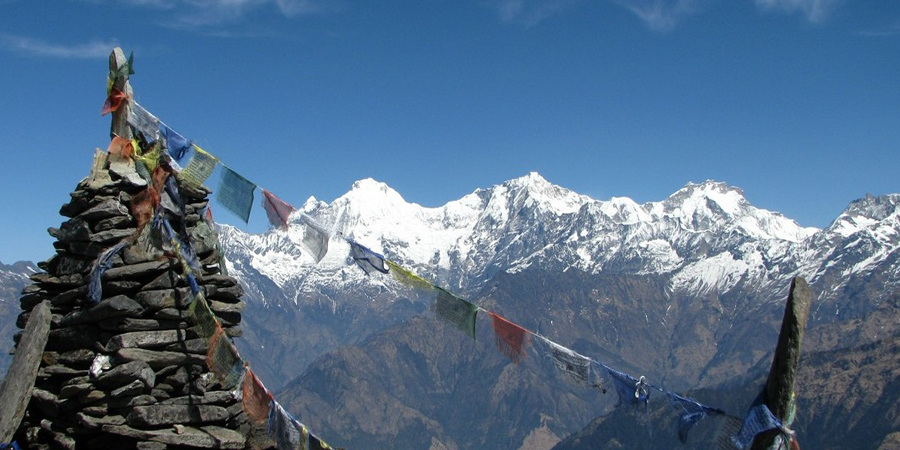
The region is situated between the Langtang National Park and Manaslu Conservation Area. The less–traveled region is a hidden gem abundant with picturesque natural beauty. Ruby Valley Trek, Ganesh Himal Base Camp Trek, Ganesh Himal Singla Pass Trek, and Paldor Base Camp Trek are popular treks in the Ganesh Himal region. We required TIMS and Langtang National Park permits.
Manaslu Region:
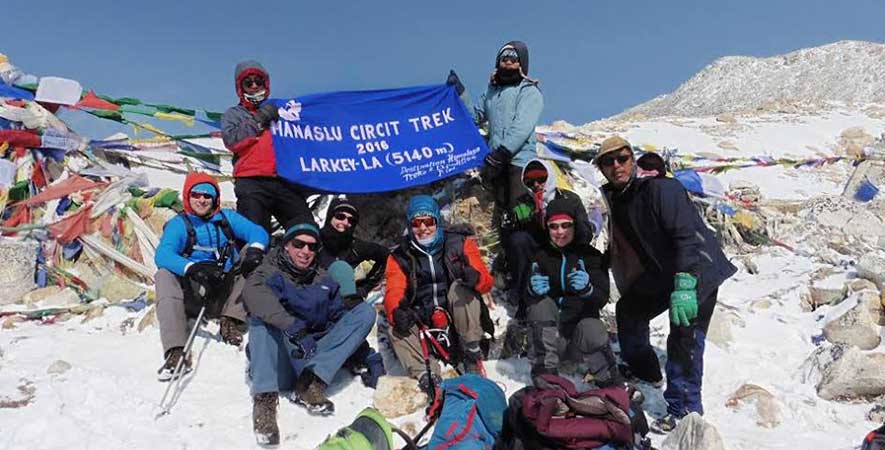
Manaslu Circuit Trek, Manaslu Two Passes Trek, & Manaslu Rupina La Pass Trek, Manaslu Tsum Valley Circuit Trek, Tsum Valley Trek are the prominent treks in the Manaslu Region. Manaslu region permits are different for different trek routes which are as follows:
- Permits for Manaslu Circuit Trek, Manaslu Two Passes Trek, & Manaslu Rupina La Pass Trek= Manaslu RAP, MCAP, & ACAP
- Permits for Manaslu Circuit Trek with Tsum Valley= Manaslu RAP, MCAP, ACAP, & Tsum Valley RAP
- Permits for Tsum Valley Trek= Tsum Valley RAP, & MCAP
The permit fees are as follows:
Manaslu Restricted Area Permit (RAP) Fee
- USD 100/week per person + USD 15/person per day (beyond a week) [Sep-Nov]
- USD 75/week per person + USD 10/person per day (beyond a week) [Dec-Aug]
Manaslu Conservation Area Permit (MCAP)
- SAARC- NPR 1000/person
Annapurna Conservation Area Permit (ACAP)
Tsum Valley Restricted Area Permit (RAP) Fee
- USD 40/week per person + USD 7/person per day (beyond a week) [Sep-Nov]
- USD 30/week per person + USD 7/person per day (beyond a week) [Dec-Aug]
Annapurna Region:
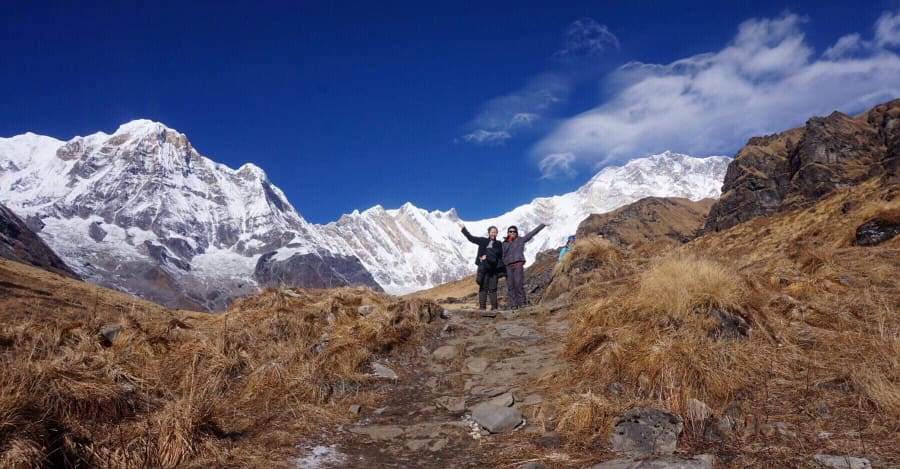
The classic and most popular trek region after the Everest region is the Annapurna region. Some of the famous treks are Annapurna Base Camp Trek, Annapurna Circuit Trek, Annapurna Sanctuary Trek, Ghorepani Poon Hill, Mardi Himal Trek, and Jomsom Muktinath Trek.
- Foreigners- NPR 3000/person
- SAARC- NPR 600/person
Upper Mustang:

Upper Mustang also lies in the Annapurna region. The adventurous and least explored trek regions in Nepal are very impressive. We required ACAP and RAP permits.
Restricted Area Permit (RAP) Fee
- USD 500/person (10 days) + an extra USD 50 per person per day (beyond 10 days)
Manang region:
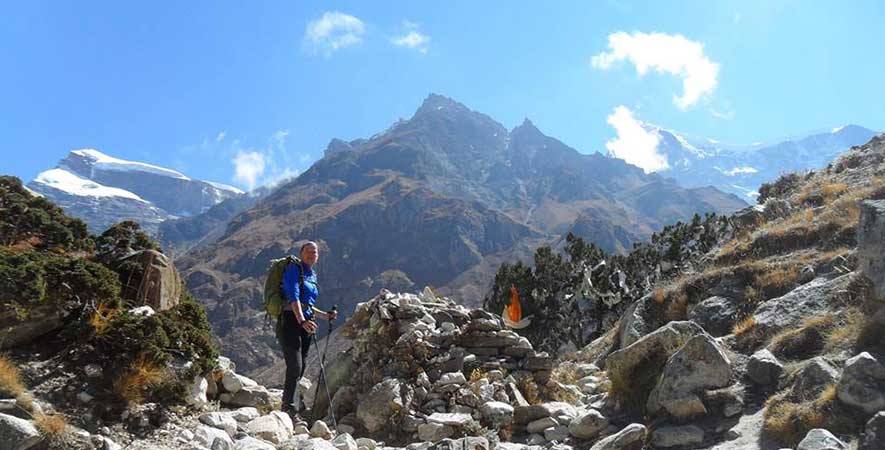
The region has some unexplored trek routes such as Nar-Phu Valley and mesmerizing Tilicho Lake Trek. Nar-Phu Valley trek requires a Restricted Area Permit and ACAP. And, Tilicho Lake Trek requires only ACAP and TIMS permits.
Nar-Phu RAP Fee
Dhaulagiri Region:

Dhaulagiri Circuit Trek is challenging and adventurous which is in the Dhaulagiri region. This region is adjacent to the Annapurna region. Thus, the required permits are:
Dolpo Region:
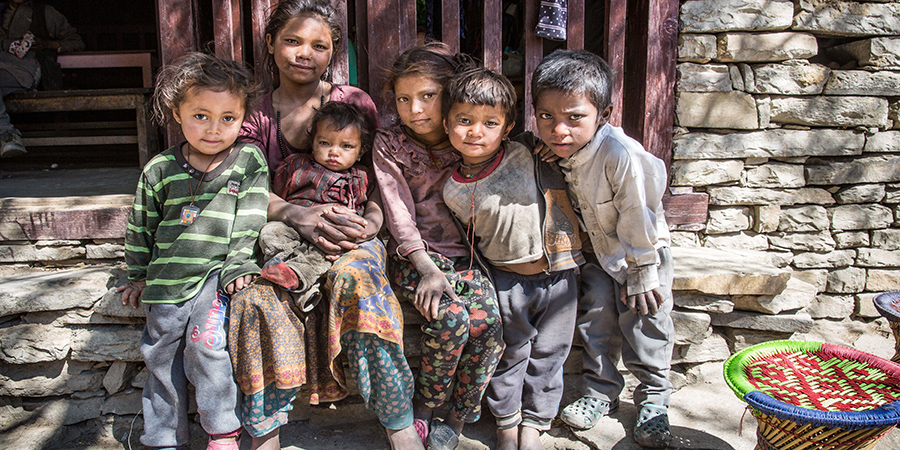
The least explored yet adventurous beautiful trek region is Dolpo. The region is rich in unique and unexplored natural beauty in its original form. Upper Dolpo and Lower Dolpo are the two main trek regions. Their required permits are:
Lower Dolpo
Shey Phoksundo National Park and Restricted Area Permits (RAP) Permits are required to trek to Lower Dolpo.
Lower Dolpo RAP Fee
- USD 20 per person per week (first 4 weeks) + USD 5 per person per week (beyond 4 weeks)
Shey Phoksundo National Park
- For all trekkers- NPR 3000
Upper Dolpo
Shey Phoksundo National Park and Restricted Area Permits (RAP) for Lower Dolpo and Upper Dolpo Permits are required to trek to Upper Dolpo.
Upper Dolpo RAP Fee
- USD 500 per person (10 days) + an extra USD 50 per person per day (beyond 10 days)
Mugu Region:
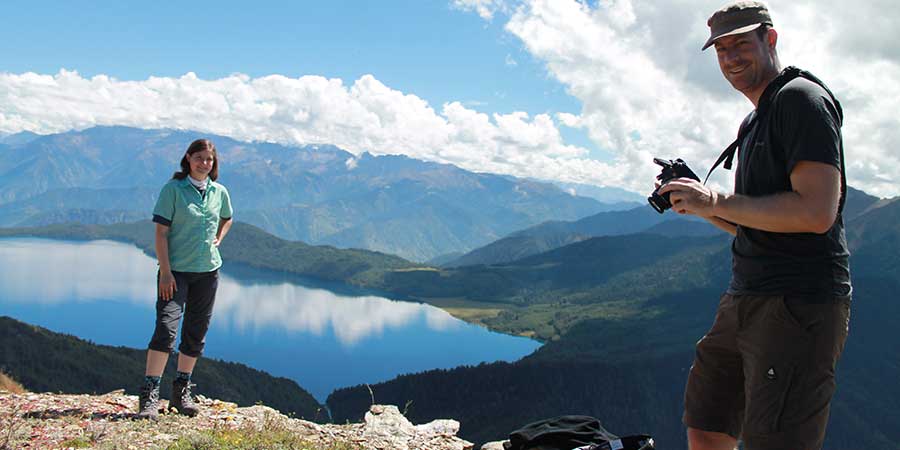
Rara Lake is the biggest freshwater lake in Nepal which lies in the Mugu region. It is well-known as Mahendra Lake. Rara Lake is very beautiful. This region is famous for the Rara Lake Trek. The required permits are:
Mugu RAP Fee
- USD 100 per person (for a week) + an additional USD 15 per person per day (after 7 days)
Rara National Park
Humla Region:
One of the farthest and least developed regions of Nepal is Humla. This region is popular for its Simikot Limi Valley Trek . The valley treks allow one to explore the region in its truest form. The required permits are:
Humla RAP Fee
- USD 50 per person (7 days) + an extra USD 10 per person per day (beyond 7 days)
Humla Village Development Community
- For all trekkers- USD 10 per person
Api Nampa Valley:
The newly discovered valley is Api Nampa. It is gaining popularity for the Api Himal Base Camp Trek. One can witness the spectacular views of Api Himal, Nampa Himal, Gurans Himal Range, Saipal Himal, and many more. The required permits are:
Api Nampa valley RAP Fee
- USD 90 per person (7 days) + an extra USD 15 per person per day (beyond 7 days)
Api Nampa Conservation Area
We have listed out the trekking permit fees for almost all of the trekking routes of the regions extending from the east to the far west. Still, there may be many queries regarding the permit fees besides their cost. Some possible queries are listed below:
Are the permits compulsory to trek in Nepal? Yes, the permits are compulsory to trek in Nepal. No one is allowed to trek or carry out trekking activities without permits.
What type of Trekking permits do we require to trek in Nepal? Mostly, the permits we require are TIMS, Municipality Trekking permits, Restricted Area Permits, and entry permits to National Parks or Conservation Areas. We may not require all mentioned permits for one single trek. It all depends on the different trek routes of the different regions of Nepal.
Where to get the Permits? One can obtain a trekking permit through a registered trekking agency in Nepal or the Tourist Service Centre in Exhibition Road, Kathmandu, or TAAN office in Pokhara. Some trekking agencies offer trekking permit services as part of their package. It is recommended to obtain a trekking permit before one arrives in Nepal to avoid any delays. Note: The office hours to take the permits are officially 10 am to 5 pm. Lunch break is between 1 pm-2 pm. The office remains closed on Saturdays and national holidays.
Where can I get the National Park and Conservation Area Permits? One can get National Park and Conservation Area Permits from the Tourist Service Centre on Exhibition Road, Kathmandu. Also, one can get on the spot at the entrance of National Parks or Conservation Areas. It is the easiest way to obtain permits. Trekkers can relax and prepare for their trek as all essential permits are arranged by the travel agency.
Where can I get the Restricted Area Permits (RAP)? One can get the Restricted Area Permits from the Tourist Service Centre in Exhibition Road, Kathmandu, or TAAN office in Pokhara. But, all of the RAP permits are arranged by the travel agency for you. So, one needs to worry about it. For trekking in Restricted Areas, solo traveling is not allowed. Thus, solo travelers can contact a travel agency to arrange a RAP permit for them. Also, one doesn’t require TIMS to trek in the Restricted Areas of Nepal. As all essential permits are looked after by the travel agency, trekkers can relax and prepare for their trek.
Do I require a guide or assistance from Travel Agency ? It is important to note that trekking in Nepal requires a high level of physical fitness and proper planning. It is recommended to hire a registered trekking agency or a guide to assist with your trek and ensure a safe and enjoyable experience. A travel agency looks after all the essential permits required for the trek. Also, for traveling to restricted areas as well as other trekking areas of Nepal, assistance from the travel agency makes it easier.
Things to Consider by Trekkers in Nepal
- Respect Local customs and Traditions
- Solo Traveling in Restricted Areas is strictly prohibited
- Trekkers are only allowed to trek in the specified routes as per the trekking permits
- Trekkers can’t change the trekking routes to trek
- Trekkers must strictly follow the guidelines issued by an official while trekking in the Restricted Areas
Who can apply for the permits? What documents are required?
Authorized travel agencies, as well as individual trekkers, can apply for trekking permits.
The following documents are required:
For Individual Trekkers:
- Your passport with a copy of the passport
- Two passport-sized photographs
- The name of the trekking route with entry & exit points
- The duration of your trek with a detailed trek itinerary
- Entry and Exit dates for Nepal
- Local Emergency Contact Number
- Home-country emergency contact number
- Travel Insurance Policy Number
For Authorized Travel Agencies:
- Online application form (trekkers) Link to Trekking Permit Application
- Passport Photocopy
- Copy of a Valid Visa (at least covering trekking days)
- Trekker’s Name List
- Detailed Trekking Program Schedule
- Guarantee letter & Agreement with Agency
- Trekking Agency’s Tax Clearance Certificate
- Both foreign nationals and Nepalese staff (accompanying the trekkers) Insurance Documents in full details
- License issued by (The Ministry of Tourism, Culture, and Civil Aviation to operate the trekking business)
- License issued by [Nepal Rastra Bank (NRB) allowing exchanging of foreign currencies]
- Registration Certificate of Permanent Account Number
- Bank Voucher payment (fees) for permits
Post your comment
Our recent posts.
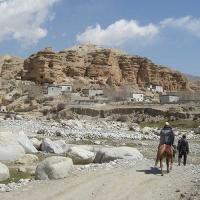
Get Instant Response:
- Hillary Classical Trek – 17 Days
- Everest Base Camp Trek – 14 Days
Everest Three High Passes Trek – 18 Days
- Everest Base Camp Trek Via Gokyo Lake – 15 Days
- Everest View Trek – 5 Days
- Gokyo Renjo La Pass Trek – 13 Days
- Everest Base Camp Trek Heli Return – 10 Days
- Everest Base Camp with Island Peak Climbing – 16 Days
- Everest Base Camp with Lobuche Peak Climbing – 16 Days
- Everest Panorama Trek – 7 Days
- Luxury Everest Base Camp Trek – 12 Days
- Ama Dablam Base Camp Trek – 8 Days
- Short Everest Base Camp Trek – 10 Days
- Gokyo Ri Trek – 10 Days
- Annapurna Base Camp Trek – 7 Days
Annapurna Circuit Trek – 14 Days
- Annapurna Base Camp Trek via Poon Hill – 13 Days
- Annapurna Circuit Trek with Annapurna Base Camp – 20 Days
- Annapurna Circuit Trek with Tilicho Lake – 15 Days
Nar Phu Valley Trek – 14 Days
- Poon Hill Trek – 7 Days
Upper Mustang Trek – 15 Days
- Mardi Himal Trek – 5 Days
- Khopra Danda Trek – 8 Days
- Annapurna Base Camp Trek with Helicopter Return – 8 Days
- Annapurna Sanctuary Trek – 10 Days
- Short Annapurna Circuit Trek – 10 Days
Manaslu Circuit Trek – 13 Days
- Manaslu Tsum Valley Trek – 20 Days
Tsum Valley Trek – 16 Days
- Langtang Valley Trek – 8 Days
- Langtang Gosaikunda Trek – 13Days
- Gosaikunda Trek – 5 Days
- Tamang Heritage Trail – 7 Days
- Kanchenjunga Trek – 22 Days
- Pikey Peak Trek – 6 Days
- Everest Base Camp Trek
- Annapurna Base Camp Trek
- Manaslu Circuit Trek
- Langtang Valley Trek
- Mera Peak Climbing
- Gokyo Renjo La Pass Trek
- Everest Three High Passes Trek
- Annapurna Circuit Trek with Annapurna Base Camp
- Everest Base Camp Trek Heli Return
- Lower Dolpo Trek – 15 Days
- Island Peak Expedition – 15 Days
- Mera Peak Climbing – 13 Days
- Mera Peak Climbing – 15 Days
- Legal Documents
- Terms & Condition
Top 6 Most Restricted and Challenging Treks In Nepal
Hidden in the Himalayas, there are many challenging treks in Nepal . The country is world-renowned for its beautiful and adventurous trekking destinations. Whatever kind of trek you seek, you will find one in Nepal.
Hillary Treks

In this blog, we will discuss the six most challenging treks in Nepal in detail. The difficulty of the trek is determined by several factors, including the route’s trail, weather conditions, and landscapes. The intensity and duration also influence the difficulty level.
Nepal has diverse geographical regions and terrains. While some trek destinations have relatively easy terrains, some are incredibly challenging. Every trekkers have their preference. Some may want a relaxing trek journey, while others prefer an adventurous one. Whatever your preference, Nepal offers a wide range of selections.
This blog is for those looking to challenge themselves with a thrilling trek experience. However, be warned that you will need good physical fitness and determination to complete these treks successfully. You must also be physically and mentally prepared to walk 6 to 8 hours a day while on the trek.
List of Most Challenging Treks In Nepal
The Everest region is Nepal’s most popular trekking destination. It is home to the world’s highest mountain , Mount Everest. But it is also home to some of the most challenging and difficult treks in the country. The Everest Three High Passes Trek covers the entire Everest region, including the Everest Base Camp Trek . It is more difficult than the EBC Trek.
The Everest three passes trek takes you across the three highest passes of the eastern region: Renjo La Pass (5360 m), Cho La Pass (5420 m), and Kongma La Pass (5535 m) . You will also get to join the classic Everest Base Camp Trek route. The high altitude and rugged terrain make it an arduous journey. Likewise, it is one of the longest treks in Nepal which takes around 18 days.
The trek is best suited for trekkers looking for adventure and excitement. It offers an excellent opportunity to explore the entire Everest region, not just the Everest Base Camp. Additionally, you can witness the surreal, pristine blue Gokyo Lakes.

The Annapurna Circuit Trek with Tilicho Lake takes you to Lake Tilicho, one of the world’s highest lakes. It is a popular trek in the Annapurna region. The trek starts from Jagat and heads north towards Chame, Pisang, and Manang. Then, it diverges from the classic Annapurna Circuit Trek route. You will head towards Siri Kharka and reach Tilicho Lake. Later, the trail once again rejoins the Annapurna Circuit at the Yak Kharka.
From here onwards, you will head to Thorung Phedi before crossing the Thorung La Pass (5416 m) . Then, you will reach the Muktinath temple, a holy pilgrimage site for Hindus and Buddhists. From Muktinath, you will head towards Tatopani and then to Gorepani.
En route, you will witness the diverse flora and fauna, cascading waterfalls, charming settlements, and deep gorges while crossing the high passes. Due to high altitude, there is a risk of altitude sickness.

The Manaslu Circuit Trek is also on the list of the most challenging trek in Nepal . The trails are rugged and physically demanding, but you can experience Nepal’s raw natural beauty on this trek. It lies in one of the remote parts of Nepal and is one of the most difficult treks.
The journey begins with a drive from Kathmandu to Soti Khola . From Soti Khola, your trek begins towards Machha Khola, Doban, Phillim, Ghap, Namrung, and finally to Samagaun . The village of Samagaun serves as an acclimatization stop for most trekkers. You can explore renowned places like Birendra Lake, Pungyen Monastery, and Manaslu Base Camp here.
From Samagaun, you will head towards Samdo and then Dharmsala. The highest pass of the Manaslu region, the Larkya La Pass (5160 m) lies between Bhimtang and Dharmasala. The climb to Larkya La is as challenging as it sounds. But the climb will be worthwhile as breathtaking mountain vistas like Annapurna II, Cheo Himal, Himlung Himal, and more will greet you.
From Bhimtang, you will continue trekking until you reach Dharapani. Trekkers often choose Dharapani as the endpoint of this strenuous trek.
The Upper Mustang Trek is one of the toughest treks in Nepal. It falls in the rainshadow region of the Himalayas. The terrain is desert-like and rocky. The region was restricted to outsiders until 1992, so its distinct culture, traditions, and historical monuments remain preserved.
Jomson serves as the starting point for the trek. You can reach Jomsom by flight or bus. From Jomsom, you will begin your trek and head towards Kagbeni, Chele, Ghami, Samir, Tsarang, and Lo Manthang.
The trek offers gorgeous mountain views of Mt. Annapurna, Thorung Nilgiri, Lamjung Hila, Dhaulagiri, Chulu East, and several other peaks. Its unique landscape makes it one of the most unique experiences in Nepal. However, its remoteness and demanding terrain make it a physically demanding trek destination.

Nar Phu Valley Trek is also one of the most challenging treks in Nepal. The off-beat trails that lead to remote valleys and landscapes with raw nature appeal to many adventure-seeking trekkers. There is also a lack of proper infrastructure and amenities on this route. It lies in the Manang region of Nepal.
As you can see above, a beautiful and remote trekking area in the Annapurna region has also made our list. Add Tilicho Lake and Mesokanta Lo to your itinerary to challenge yourself further.
The trek requires crossing two high mountain passes. Its starting point is Besisahar, also the starting point for Annapurna Base Camp. The trail up to Koto follows the same route as Annapurna Base Camp. Then, the trail for Nar Phu Valley turns east. En route to Phu Gaon, you will pass the Nar Khola River. Then, you will cross the two passes to enter Naar.
From Naar, you will pass Kang La Pass before reaching Ngwala. From there, you will head towards Manang and join the Annapurna Circuit route. You will pass the Yak Kharka and Tharung Phedi before crossing the Thorung La Pass. After you reach the holy Muktinath temple, you will head towards Jomsom, Tatopani, and then return to Pokhara.

Tsum Valley is a sacred Himalayan Buddhist pilgrimage and a hidden gem of northern Gorkha, Nepal, near the Tibetan border. It is one of Nepal’s most secluded valleys. Most residents are of Tibetan origin, so they speak a distinct dialect. Thus, Tibetan Buddhism has a strong influence in the region.
This pristine Himalayan valley has a rich cultural heritage, arts, and traditions. The Tsum Valley trekking trails are adorned with prayer flags, chortens, and drawings of deities inscribed with sacred prayers. Although the trek’s highest point is relatively lower than others on the list, its remoteness and demanding trails still qualify it as a physically demanding trek destination in Nepal.
The off-the-beaten-track trails of Tsum Valley Trek are scenic and adventurous at the same time. While on the trek, you can witness splendid vistas of majestic mountains like Ganesh Himal, Sringi Himal, Himalchuli, and more. It will undoubtedly test your physical stamina, strength, and endurance, but the rewarding experience makes up for it.
Other Challenging Treks To Explore In Nepal
- Upper Dolpo Trek
- Rolwaling With The Tashi Lapcha Pass
- Poon Hill Trek
- Ganja La Pass Trekking
- Henjo La Pass To Cho Oyu Trek
- Simikot Hilsa Limi Circuit Trekking
- Everest Amphu Lapcha Pass Trekking
- Kanchenjunga Trek
- Makalu Serpani Col Amphu Lapcha Pass Trek
- Sherpani Col Pass Trek
- Annapurna Sanctuary Trek
You Might Be Interested In:
Top 10 Best Treks in Nepal
These were the six most challenging treks in Nepal. Due to the harsh weather conditions, some treks mentioned above are not doable during the monsoon and winter seasons, making the already strenuous trek more demanding.
You must prepare thoroughly and undergo proper training to complete these treks on the list. If you need further information or want to embark on a trekking journey in Nepal, you can contact us here at Hillary Step Treks .
What is Nepal’s most challenging trek?
The Dhaulagiri Circuit Trek is known as Nepal’s most challenging trek. It takes you into remote regions with very limited infrastructure and teahouses. It is physically strenuous with a high risk of altitude sickness. Additionally, the long duration also makes it a difficult trek in Nepal.
Which is most challenging, hiking or trekking?
Trekking is more challenging than hiking. While on a trek, you must walk longer durations and cover greater distances. There is more possibility of encountering rough and demanding terrains while trekking. On the other hand, hiking is a short and relatively easy walk.
How difficult is the Everest Base Camp Trek?
Everest Base Camp Trek is moderately difficult. However, the trails of the EBC route require you to ascend and descend on diverse terrains, including steep and narrow sections. Likewise, there is a risk of altitude sickness due to high altitude.
What factors influence the trek difficult?
The trek’s difficulty depends on various factors. It includes trek duration, terrain, altitude, and weather conditions. Proper physical, mental, and equipment preparation can help make the trek experience more comfortable. Likewise, experienced guides and porters also provide valuable support.
Is trekking in Nepal safe?
Trekking in Nepal is safe. The routes are well-marked and in good condition. But for precaution, it is best to trek during spring and autumn. These seasons have the most favorable weather and temperature with minimum rainfall.
My name is Hillary. Since completing the Government Guide Training from Nepal's Ministry of Tourism and Civil Aviation (KEEP and HRA), I have been a specialist in mountain trekking and peak climbing. With specific expertise in the Nepal, Tibet, and Bhutan regions, I have now been a trekking guide and tour operator in Nepal, and across the Himalayas, since 2012.
Read Previous
10 Best Things t...he Bazaar, Nepal
Everest Base Camp Trek Route

Discover the essential travel requirements for Nepal, including visa procedures, current travel restrictions, and health and safety guidelines. Our travel expert will guide you through the latest entry requirements based on your departure country and passport, ensuring you’re prepared for your Himalayan adventure.

How To Obtain a restricted Area Trekking Permit in Nepal?
- Last Updated on Sep 15, 2023
Have you ever dreamed of exploring the majestic landscapes of the Himalayas in Nepal? Have you ever wondered what it would be like to trek through its lush valleys and admire its breathtaking peaks? If so, you must understand the importance of obtaining a Restricted Trekking Permit in Nepal. But what exactly is a Restricted Trekking Permit, and how can you obtain one? In this essay, we will explore the process of getting a Restricted Trekking Permit in Nepal and the necessary steps that you need to take to secure one successfully. So, ready to embark on a journey of a lifetime? Let’s begin.
In Nepal, select trekking routes require restricted permits to ensure the safety of adventurers. These premier paths are inaccessible to the public for a good reason - situated in perilous mountainous landscapes with high altitudes, they demand knowledge and expertise that the average person may not possess. As a result, permits are mandatory to avoid risking the well-being of trekkers.
To embark on a trekking adventure through Nepal, it's essential to secure a permit from the Department of Immigration, which falls under the Ministry of Home Affairs. This permit is time-restricted, limited in scope, and must be obtained before beginning the journey. Prospective hikers should ensure they possess all necessary documentation and have the financial means to cover the requisite fees. The price of a restricted trekking permit can vary based on several factors, such as the region being explored, the duration of the trek, and the number of applicants seeking permits. Although the standard cost is typically set at 500 Nepali rupees, this can be variable. Payment methods include both cash transactions and online payment platforms.
Trekking permits provide trekkers with valuable insights into the guidelines of the restricted area. These guidelines encompass permissible activities, obligatory camping, cooking equipment, and other vital information. Furthermore, trekkers are supplied with area maps that give them crucial terrain information and prevent them from getting lost.
Apart from the standard permit for hiking, individuals seeking to venture into high-altitude regions of rugged topography may necessitate a special permit. Known as the Sagarmatha National Park permit, this document can be obtained through the Department of Immigration and entails additional restrictions, including altitude restrictions and the mandatory employment of a guide.
Trekkers must first procure restricted permits to travel to Nepal's most untamed and captivating regions. Undertaking such a journey without proper authorization can compromise your safety and undermine the potential for an unforgettable trekking adventure. It is paramount to heed the rules and regulations accompanying the permit, as they safeguard the area's environment, wildlife, and indigenous ecosystem. So be mindful, follow the guidelines, and revel in the beauty that awaits you.
Table of Contents

Kanchenjunga Base Camp Trek - Updated Cost | Itinerary | Map

Upper Mustang Trek | Group Sharing Permit 2024-2025

Upper Dolpo Trekking - Shey Gompa

Manaslu Circuit Trek
What are restricted areas in nepal.
Nepal is a breathtaking wonderland interlaced with abundant natural beauty and cultural diversity. From towering Himalayan ranges to sprawling national parks and diverse human settlements, Nepal is a country that one must visit more than once to experience its splendor truly.
Though certain areas are restricted, foreign nationals are welcome to explore any part of Nepal. Previously, Nepal had barred entry to these areas for foreign nationals until October 1991. However, now these areas are accessible to foreign nationals with a Special Permit. Many travelers often ask why certain regions of Nepal are restricted. The answer is quite simple - it is for the safety and security of the trekkers. These restricted areas are usually located in high-altitude zones bordering Tibet, where human settlements are scarce, and trails are not frequently traversed. Hence, it is considered a risky zone for individual travelers. Another possible reason for these restrictions is to prevent any illicit activities by travelers who may attempt to enter remote parts of Nepal, bordering Tibet and controlled by China. Trekking in restricted areas is still possible, but with strict provisions requiring travelers to go through authorized trekking agencies in Nepal.
Nepal's restricted trekking areas are divided into Protected Areas and Conservation Areas. Protected Areas are habitats of rare wild species, many of which are endangered. Building any infrastructure, accessing resources, and even staying for extended periods are prohibited to ensure the preservation of these vital ecosystems. On the other hand, conservation areas are often sites of religious and cultural importance and are managed to conserve heritage.
Nestled in the remote northwestern region of Nepal lies a place of utmost importance - the Annapurna Conservation Area. This precious space is a sanctuary for diverse wildlife, most notably the endangered snow leopards, red pandas, and musk deer. The ACA has proudly served as a safeguard for vulnerable and threatened species, a guardian of precious habitats, and a facilitator of sustainable resource utilization for over a decade. To preserve this fragile ecosystem, trekking within the ACA is strictly prohibited. Nepal is also home to other invaluable protected areas, including the Shey Phoksundo National Park, Kanchenjunga Conservation Area, Makalu Barun National Park, and Rara National Park.
On the other hand, Conservation Areas in Nepal are restricted trekking areas that manage to conserve cultural heritage. These areas are often populated by local villages and are sites of spiritual significance for the local communities. Some examples of restricted trekking areas classed as Conservation Areas in Nepal include the Upper Mustang, Manaslu, and Dolpo regions.
The Upper Mustang region is particularly important to Nepal's heritage and is deemed a restricted trekking area as its landscape is so ancient. This area is home to some of the most scenic villages in the country and is often referred to as "lesser Tibet" for its resemblance to a traditional Tibetan landscape. The Manaslu region is known for its spectacular mountain views, rich cultural heritage, and Shey Phoksundo National Park. In addition, the Dolpo region is home to many of the oldest monasteries in the area and is known for its ancient Buddhist culture.
As a result of the sensitive state of these regions, exploring the restricted trekking zones in Nepal is completely disallowed. Regional groups enforce the rules, and if tourists are found in the vicinity, they will face immediate penalties. These guidelines are in place to conserve the region's natural environment and cultural legacy. Those planning to trek in Nepal must honor the limitations imposed by the Nepalese government.
Who Needs Restricted Areas Permit?
Restricted areas are those of a country where access is limited under the rule of law because of safety concerns, political or religious reasons, or simply to protect the environment. In Nepal, Restricted Area Permits are issued by the Department of Immigration in Kathmandu to regulate entry into certain parts of Nepal. It is important to note that anyone wishing to visit one of these areas must have appropriate documentation with them to gain access.
Foreign nationals wishing to visit special restricted areas must apply for a Restricted Area Permit (RAP) from the Department of Immigration . The RAP is valid for 16 days from the date of issuance, and the permit holder is allowed to stay inside the area for up to 24 hours. The permit holder can visit the area according to the conditions specified in the permit and is advised not to take any photographs that can harm governmental interests or affect the religious or cultural sensitivities of the inhabitants.
Nepalese citizens need to possess a valid citizenship certificate issued by the District Administration Office or a valid identity card issued by the government to enter the specified restricted areas. For Nepalese citizens, there is a restriction on the number of times they can visit the restricted areas. They may not visit more than twice a year, which should be within the same calendar year.
Local Nepalese residing in the restricted area may enter the area without any restrictions. They may not stay there overnight or perform any activity that will harm regional peace and stability.
Individuals who violate the permit conditions or break the provisions of the area will be punished with up to six months imprisonment and/or a fine of up to Nepalese Rupees three thousand.
Where to get Restricted Area Permits (RAP) in Nepal?
The ability to visit restricted areas within Nepal is a valuable privilege. With a Restricted Area Permit (RAP), travelers can explore classic tourist spots and more adventurous locations. As such, obtaining a RAP is an essential part of the travel planning process for many tourists visiting the region.
In Nepal, RAPs are issued by the Department of Immigration (DOI ). The DOI is the Nepali government body responsible for implementing laws and regulations concerning the acquisition of foreign visas and the entry of foreigners into the country. Those interested in obtaining a RAP should visit DOI's website to find the forms and information required for the application. Applications must be submitted online or through the entry permit counters at Kathmandu or Pokhara.
Once the application has been submitted, the applicant must wait for their RAP approval by the Ministry of Home Affairs. This process can take a few days, so it is important to plan when applying. If a person is successful, the authorized RAP will enable them to enter and enjoy restricted areas in Nepal.
The DOI also issues Special Area Permits (SAP) in specific circumstances. This type of permit is required for visits to places such as the Upper Mustang and some districts of the Mt. Kailash region. In addition to the basic RAP documents, SAP applications must include a letter of recommendation from the Regional Administration Office and a suitable health certificate.
Acquiring Restricted Area Trekking Permits is an exclusive privilege granted solely by the Department of Immigration, which is accessible only through certified trekking organizations such as Discover Altitude, acknowledged and authorized by the state of Nepal. Even though the RAP Trekking Fees fluctuate according to the designated area, duration of the trek, and climatic conditions, the key requirement for procuring the RAP permits mandates that a minimum of two trekkers are part of the adventure.
How to Apply for Permits Through Online?
Before anything else, identify the precise permit category that corresponds to your intended destination. This could either be a Restricted Area Permit (RAP), Special Area Management Permit (SAMP), or a Protected Area Permit (PAP) . Once you've established your required permit, you may proceed with the application process.
The application process begins with creating an account on the official website of the Department of Immigration (DOI) in Nepal. Upon successful account creation, many permits await your selection to set the ball rolling. The application procedure is uncomplicated, requiring you to furnish detailed personal information, including your appellation, passport number, visa number, and other related details. Additionally, the application should scrupulously document specific information concerning the intended stay, travel destinations, and requests related to the permit. Leave no stone unturned in capturing every intricate detail that the permit necessitates.
Submit your application for a trek through the digital application forms. The application must include a comprehensive list of all the individuals embarking on the journey and a passport copy for each individual. You must provide a detailed trekking itinerary for the particular restricted area and a copy of your valid visa for Nepal that covers the duration of your trek. Additionally, you must obtain guarantee letters from your trekking agency and sign a binding agreement with them. The trekking agency must also provide the following:
- Their tax clearance certificate.
- Insurance documents for both foreign nationals and Nepali staff.
- Their government tourism license.
In addition, the trekking agency must have a Nepal Rastra Bank license to exchange foreign currency and a Certificate of Permanent Account Number (PAN). Lastly, the voucher for your bank payment for your Restricted Area Permit fees must also be provided.
Tips of Do's and Don't for Trekkers in Restricted Areas Nepal
Trekking is becoming increasingly popular among adventurous travellers seeking to explore the great outdoors. However, trekking in restricted areas of Nepal brings unique responsibilities and considerations, making it essential for all trekkers to know the relevant dos and don'ts.
On the 'Do' side of the equation, trekkers in Nepal's restricted areas must be aware of and adhere to local laws and regulations. To ensure the safety and legal compliance of all trekkers, verifying any relevant visas, permits, or other paperwork before embarking on the trek is critical.
The first and foremost rule for trekkers in restricted regions is to show the utmost respect toward the local culture, traditions, and customs. Additionally, when trekking, respect the environment and cultural and traditional norms. Basic items such as food, supplies, and cooking fuel should be carefully selected, and any waste should be disposed of safely and by local regulations. Furthermore, purchasing supplies and equipment locally is advisable, helping to re-invest in the local economy.
As a safety precaution, individual trekkers are not allowed to enter restricted areas. Instead, they must form a group of at least two trekkers. Carrying a Restricted Areas Permit (RIP) while trekking in restricted regions is mandatory. Likewise, trekkers must be accompanied by a registered trekking guide and Porter to ensure safety and guidance. The trekkers and their accompanying Nepali staff must have accidental travel insurance for any unforeseen incidents. Trekking routes in restricted areas are pre-determined, and trekkers must adhere to the specific route disclosed while obtaining a Restricted Areas Permit. Any change in route is not permissible. Lastly, trekkers must obey the instructions authorized officers to give in restricted areas to ensure the safety of all involved.
On the 'Don't' side of the equation, it is important to be aware that some activities are not allowed or discouraged in Nepal's restricted areas. For example, trekking, rock climbing, or mountain biking are not allowed in and around protected areas. Additionally, when visiting the local villages, it is essential to be respectful and courteous to avoid accidental cultural faux pas or unintentional insults.
All restricted area Permits With Costs
Upper mustang rap:-.
Nestled in the heart of Nepal lies the elusive region of Upper Mustang, beckoning the adventurous soul to its pristine beauty. With its mystic charm and enchanting allure, it has become a coveted entry in the bucket list of globetrotters. A dedicated permit is required to embark on the journey to the Kingdom of Lo, with the restricted area starting from Kagbeni and the official checkpoint for your RAPs. To experience this once-in-a-lifetime adventure, the Upper Mustang restricted area permit costs USD 500 per person for the first 10 days. For every additional day spent in this enchanting realm, an extra 50 USD per person is charged, making it an exclusive and priceless experience.
Humla Rural Municipality RAP: -
The Simikot Limi Valley Trek is calling for the necessary Humla Rural Municipality RAP. This particular district may not be in the limelight, but it has undoubtedly caught the attention of trekking enthusiasts over time. With a resemblance to the magnificent alpine highlands of Switzerland and Italy, the Limi Valley region is breathtaking. The Humla RAP is your gateway to exploring and experiencing all that the Simikot, Changkheli, and Namkha Rural Municipalities have to offer. The permit fee for the Humla RAP is USD 50 per person for the first 7 days, with an additional USD 10 per day for any further extension.
Lower Dolpo RAP:-
The Dolpo region, located in the vast district of Dolpa, boasts a rare and well-maintained collection of cultural customs and rural ways of life in Nepal's mid-western area. It comprises two exclusive zones, the first being the Lower Dolpo, which primarily encompasses the lower precincts of the Dolpa district. For those seeking adventure in the Upper Dolpo Trek, a RAP (Restricted Area Permit) is mandatory and costs USD 20 for an initial week, with an added USD 5 per day for longer periods, exclusively for the Lower Dolpo region.
Manaslu Conservation Area RAP:-
The Manaslu region is a natural and cultural treasure trove, beckoning adventurers from far and wide. However, it boasts two highly coveted restricted areas, the first of which is the Manaslu CA. This elusive region commences from Jagat and spans over five days on the regular circuit, culminating in Samagaon. For those seeking to explore the Manaslu region, the cost of the Manaslu RAP varies according to the season. From September to November, the initial week will cost USD 100, followed by USD 15 per day for any extra days. From December to August, the fee is USD 75 for the first week and USD 10 per day for additional days.
Upper Dolpo RAP:-
Upper Dolpo, a mystical land in the Himalayas of Nepal, is a hidden gem waiting to be explored by the intrepid traveler. With a rich history and breathtaking natural vistas, this off-the-beaten-path destination is a trekking paradise like no other. Those seeking adventure and excitement will find themselves in awe of the stunning beauty of Upper Dolpo. A Restricted Area Permit (RAP) is required to embark on this journey. The cost for the first 10 days is USD 500 per person, with an additional fee of USD 50 per day for any extra time spent in this magical land. Many consider Upper Dolpo and its multiple passes to be one of the best-value destinations in the world for off-the-beaten-track trekking.
Solukhumbu RAP for Rural Municipality:-
Solukhumbu RAP is necessary for the Makalu Barun NP trek and Great Himalayan Trail. Bhotikhola and Makalu rural municipalities are included in this restricted area, which offers an excellent mix of nature and culture, distinct from the usual Everest Base Camp regions. The permit fee for the Solukhumbu District RAP is USD 20 per person for the first 4 weeks and USD 25 per week for any additional time.
Manang Nar Phu region RAP:-
The mystical Nar Phu region offers an unparalleled adventure for those seeking a break from the mundane Annapurna Region. Embracing the road less traveled, the trail unfolds a magical experience in the quaint hamlets of Nar and Phu, steeped in ancient history and rich culture. This trek is often touted as the well-preserved counterpart of Upper Dolpo in Western Nepal. To get entry into this wonderland, the cost of Manang Nar Phu RAP varies with the changing travel seasons. From September to November, the initial seven days come at USD 100, with an added USD 15 for every subsequent day. For the remaining months - December to August - the first week is priced at USD 75, and USD 10 is charged for every additional day beyond the eighth day.
Taplejung Rural Municipality RAP:-
Attention all travelers, the Taplejung Rural Municipality RAP is necessary for anyone traversing through Phantanglung, Mikwakhola, and Sirijunga rural municipalities. The initial fee for the first four weeks will be a mere USD 20 per week, while subsequent weeks will require a fee of USD 25 per week. Don't let the lack of this required permit halt your travels - make sure to obtain the Taplejung Rural Municipality RAP before embarking on your journey.
Rasuwa Gosaikunda RAP:-
The Rasuwa Gosaikunda RAP is a special permit required for those embarking on the Gosainkunda Lake trek and the Langtang Gosainkunda Helambu Trek. This permit serves a dual purpose by incorporating religious pilgrimage and trekking elements into the destination. Gosainkunda Lake is a revered site for both Hindus and Buddhists, which makes the permit slightly different from others on the list. The region is also famous for the Tamang Heritage trail, which is an exhilarating experience for trekkers in Nepal. A restricted area permit is necessary to obtain access to the Rasuwa Gosainkunda region, which costs USD 20 per person per week.
Gorkha Tsum Valley RAP:-
The Tsum Valley is a treasure trove of ancient villages frozen in time, free from Western culture and modernization influences. The Nepalese Government has prioritized preserving this region's traditional lifestyle, customs, culture, and monuments. A permit is required to explore the villages of Sirdibas, Lokpa, Chumling, Nile, Chekampar, and Chule, along with the Chumnubri rural municipality. The Gorkha Tsum Valley RAP has varying costs depending on the time of year you plan to visit. From September to November, the permit costs USD 40 for the first 7 days and USD 7 per day for additional time. From December to August, the cost is USD 30 for the first week and USD 7 per day for any extra time. Besides the Tsum Valley, there are five more restricted areas in Nepal that travelers often seek for a unique experience. Each of these areas encompasses the rural municipalities of different regions in Nepal, and the cost of permits varies depending on the location and time of year.
Makalu region Restricted Area Permits, Sankhuwasabha District: -
Travelers seeking to reach the Makalu Base Camp or Barun Valley treks will require the necessary Makalu region Restricted Area Permits, which are exclusively granted for the Sankhuwasabha District. This area boasts a stunning location, nestled amidst the Everest and Kanchenjunga massifs, promising unforgettable experiences for all who venture within its borders. Encompassing the Kimathanka, Chepuwa, Hatiya, and Pawakhola villages, this region also presents fantastic opportunities for avid wildlife photographers. Obtaining the RAP for the Makalu region of Sankhuwasabha district requires a fee of USD 10 per person for the initial 4 weeks, with an additional USD 20 charge per week for any extended periods.
Dolakha Rural Municipality RAP:-
Dolakha Rural Municipality RAP is a mandatory document for those who wish to explore the stunning GauriSankhar and Bighu rural municipalities and embark on the magnificent Ruby Valley trek. The cost of acquiring this document is a reasonable USD 20 per person per week. Remember, the Dolakha Rural Municipality RAP is not just a mere formality but a crucial step in ensuring a safe and hassle-free adventure in this breathtaking region.
Bajhang RAP:-
You need this RAP to make your way to Saipal Rural Municipality. Experience the culture, customs, and people at an incredibly low cost - just USD 90 for the first 7 days per person, and then a mere USD 15 per day starting from the second week. Live largely and have a blast while exploring one of the most mystical and magical places in Bajhang.
Darchula RAP:-
The gateway to the Api Nampa Trek awaits - a wilderness of high peaks, fast-flowing rivers, and unspoiled beauty. All that stands between you and the start of your journey is a permit from Darchula RAP, your ticket to accessing this wild world. It won't cost you an arm and a leg either - for the first seven days, the cost is just 90 US dollars per person, with an additional 15 US dollars every day after that.
Mugu Rural Municipality RAP:-
Mugumakarmarong Rural Municipality is the perfect destination for any explorer looking for a unique and local experience. With its vibrant culture, rich traditions, and stunning natural beauty, it's no wonder why so many adventurers are looking to explore this hidden gem of Nepal. For an affordable price of USD 100 for the first seven days and USD 15 per day starting from the second week, you can dive into the rich local history and explore the diverse landscape of this captivating locale. From navigating its lush jungles and soaring mountains to discovering its hidden cultural gems, embark on the journey of a lifetime and explore the wonders of Mugumakarmarong Rural Municipality today.
- Latest Update

Dipak Pande
Dipak starts to step up from potter, guide, and trekking leader to the company owner. Sometimes he share his experience with others as well as wrote in local travel news. Most of time he spend his time on mountain and his company.
Drop a message
Recent posts.
- Top 20 Winter Things to Do in Nepal - Hiking & Tour
- Who conquered Annapurna base camp trail?
- How to Obtain a Naya Kanga Peak Climbing Permit?
- Responsible Trekkers- Porter Support in Nepal
- Island peak climbing cost - Guide | Permit
- How to prepare for successful peak climbing in Nepal ?
Related Posts
- History, culture and religion of Milarepa Cave in Lapchi Village
- Everest Trek Guide
- Latest News and Update
- Map and Itinerary
- Nepal Trekking Cost
- Peak Climbing
- Tour in Nepal
- Trekking in Nepal
We use cookies to ensure that we give you the best experience on our website.

- Best Hikes In The World
- Appalachian Trail
- European Hikes
- Nepal Hikes
- Patagonia Hikes
- See All Hikes
- Mount Kenya
- Mount Kilimanjaro
- Mount Toubkal
- See All Mountains
- South Africa
- New Zealand
- Switzerland
- United Kingdom
- Packing Lists
Nepal Hiking Routes – Complete Overview Of Hikes In Nepal
Asia , Nepal
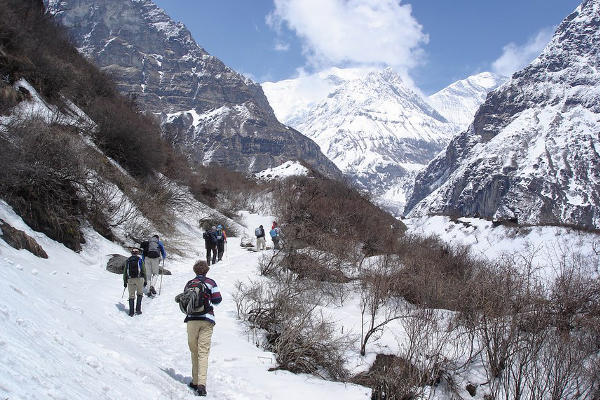
Apart from being the home to some of the highest mountain peaks and breath-taking views in the world, Nepal is particularly popular as it offers a vast variety of trekking routes.
There are short routes and long routes, easy routes and challenging routes, busy routes and remote routes. There are routes for young trekkers and families, as well as routes for veteran trekkers and adventure-seekers.
Nowadays, there are even routes that offer healthy living experiences that encompass meditation, yoga and cultural tours to traditional Nepalese villages.
In this article, we'll explore the best Nepal treks by region.
Nepal Trekking Routes by Region
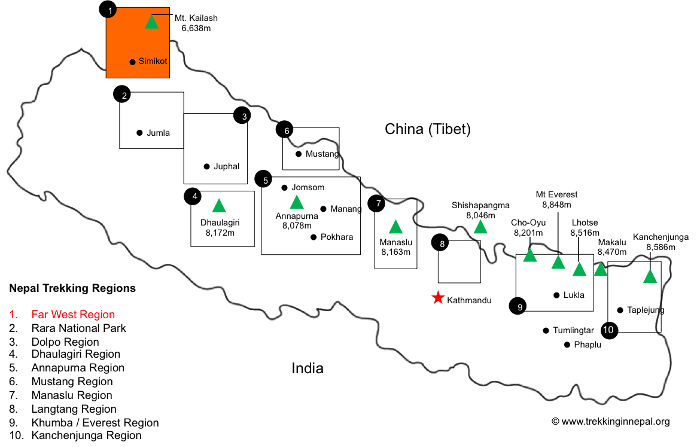
Far West Region
The Far West Region of Nepal is often overlooked due to it’s rather remote geographic location and poor infrastructure. However, this is fast changing due to a large investment and promotion effort that begun in 2008.
The region offers an authentic trekking experience that is hard to match in any of the other regions. Covering just over 25% of the Great Himalayan Range (if you include Rara National Park ), the region is the largest in Nepal.
The region is home to the second largest district in Nepal, Humla, in the North and Darchula, Bajura and Bajhang in the South.
Trekking routes are still undeveloped and rustic in the region, with little in the way of established accommodation and availability of foodstuffs. However, these characteristics give the region a charm and wonder reminiscent of what early 1950s explorers must have experienced when Nepal first opened up to foreigners.
If you are looking to escape the crowds and experience an untouched environment, then the Far West region is for you. The Limi Valley Trek is the most popular in the region. Also see the great Himalayan trail .
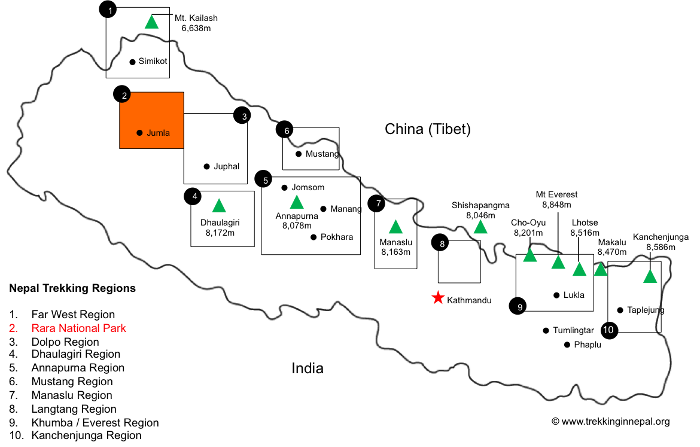
Rara National Park
Established in 1976, Rara National Park is an area of incredible natural beauty. It lies in the North-west of the country in a remote area called Karnali and houses Rara Lake – Nepal’s largest lake.
Like treks in the Far Western Region, there are a number of trek variations, but the most popular is the Rara Lake Trek ; a 10-14 day hike that provides an ‘off-the-beaten’ track experience characterised by pristine natural beauty, snow-capped Himalaya peaks that reflect off the glassy Rara Lake and the best opportunity to view wildlife like musk deer, tahr, Himalayan black bear , leopards, ghoral and, if you are lucky, the red panda.
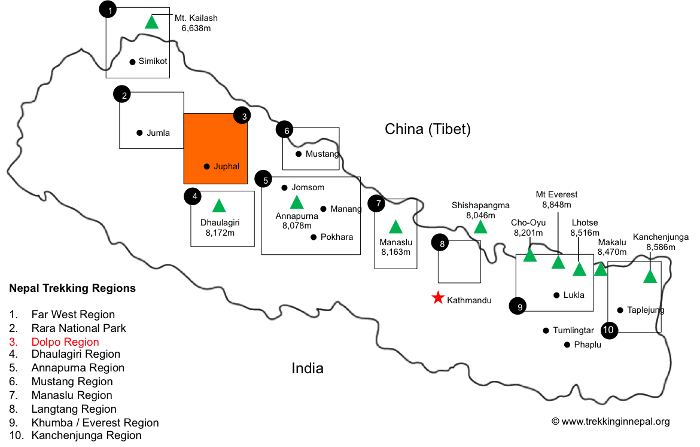
Dolpo Region
The Dolpo Region is another remote and incredibly beautiful part of Nepal. It runs from the border of Tibetan Plateau in the North, often referred to as the Upper Dolpo, to the large east-west valley system that sits in the South, or Lower Dolpo.
To the east are the Khyaklum and Dhaulagiri Himals which create a border with the Mustang and Annapurna region respectively, and give Dolpo a sense of isolation from the rest of Nepal.
Most trekkers enter the Dolpo via Juphal and then follow various routes either in the Lower Dolpo region or further North and West in the Upper Dolpo or Mustang.
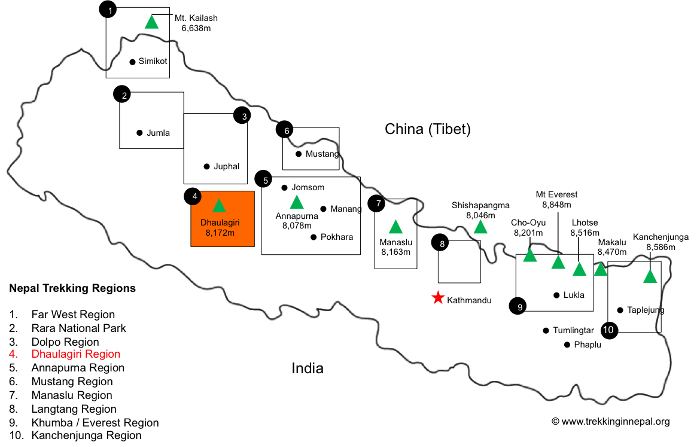
Dhaulagiri Region
The Dhaulagiri Region houses the seventh highest mountain in the world, Mt. Dhaulagiri (8,137 meters), and is one of the more remote areas of Nepal.
The region is ideal for experienced high-altitude trekkers who are looking to avoid the crowds that are common in the Annapurna, Langtang and Khumba regions. Treks in the region are only available in the Autumn months (October through December) as heavy snow and ice conditions in the winter and spring make the region inhospitable.
The most popular hike in the region is the Dhaulagiri Circuit Trek (15-18 days). The trek is not for the faint-hearted. It includes strenuous hiking at high altitude and potential use of ropes on the moraines near Dhaulagiri Base Camp. Traversing the awe-inspiring French and Dhampus passes, the Dhaulagiri Circuit Trek is, in our opinion, one of the finest in Nepal!
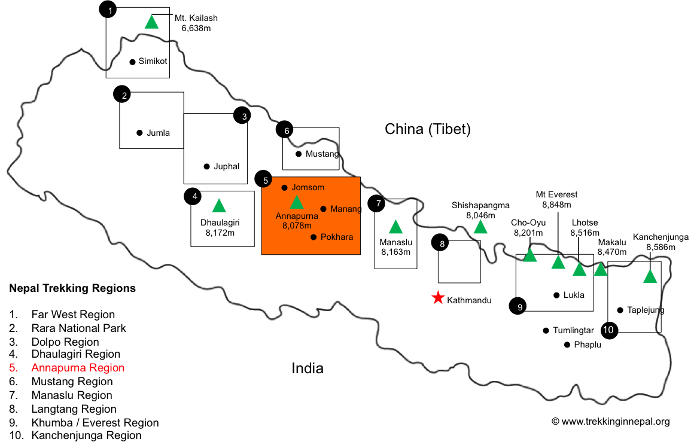
Annapurna Region
The Annapurna region is one of the most popular trekking area in Nepal. It is situated just north of the trekking city of Pokhara and encompasses Annapurna I, the 10th highest mountain in the world at 8,091 meters, as well as 13 mountain peaks over 7,000 meters and 16 more peaks over 6,000 meters.
The area is characterised by alpine meadows, glaciers and moraines.
The main trekking routes in the Annapurna region can be seen below.
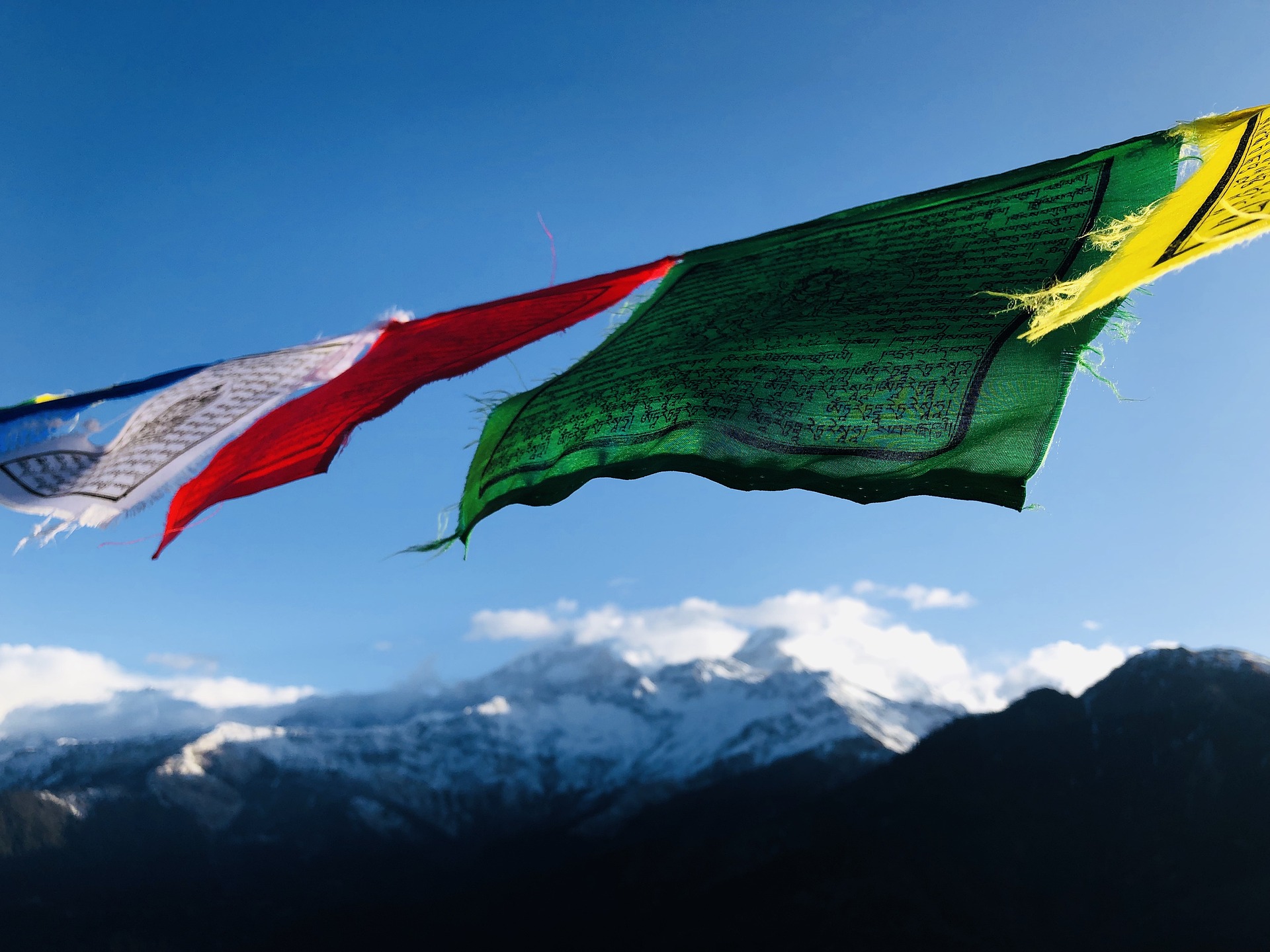
Annapurna Circuit (up to 3 weeks)
The Annapurna circuit is one of the most iconic treks in the world, although road development in recent years has led to lots of negative publicity. The trek follows a counter-clockwise route, passing through the Lamjung, Manang, Mustang and Myagdi regions. Perfect for trekkers with lots of spare time on their hands.
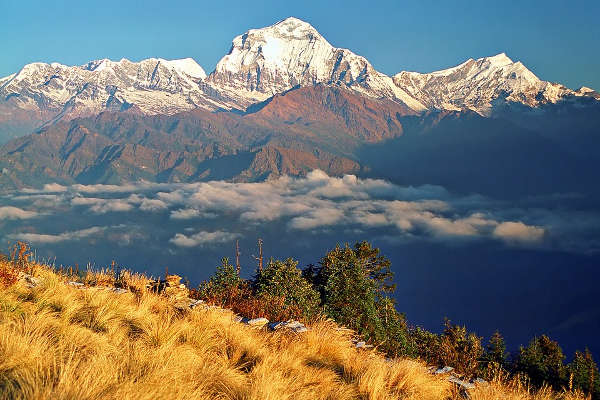
Annapurna Base Camp Trek (7-14 days)
The Annapurna BC hike is a popular trek as it can be reached via various routes including the sanctuary trek above.
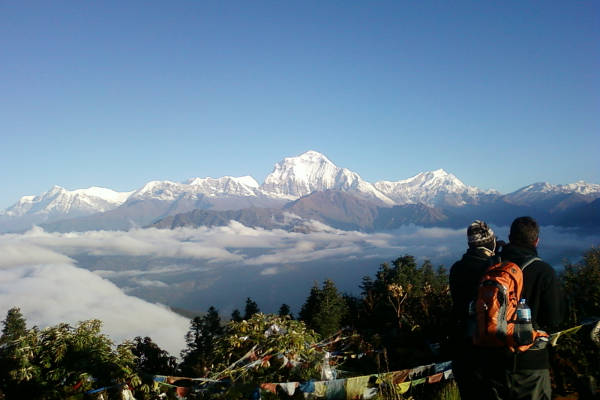
Annapurna Sanctuary Trek (~14 days)
A classic trek that starts either at Phedi or Nayapul, north of Pokhara and traverses the Annapurna Sanctuary via Chomrong to Annapurna Base Camp.

Jomsom Muktinath Trek (5-13 days)
The Jomsom Muktinath hike is a moderate to easy trek in the Mustang region, north of the Annapurna Range. The trek includes awe-inspiring views of Annapurna, traversing the Kali Gandaki River – the world’s deepest gorge.
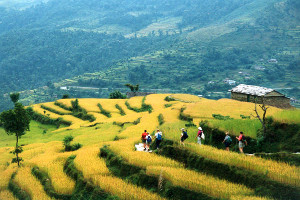
The Royal Trek (3-4 days)
The Royal hike is one of the shortest and easiest treks in Nepal, the Royal trek follows the same path taken by Prince Charles in the 1980s and takes its name from this excursion. Great for trekkers who have limited time and are looking for a light and easy trekking experience.
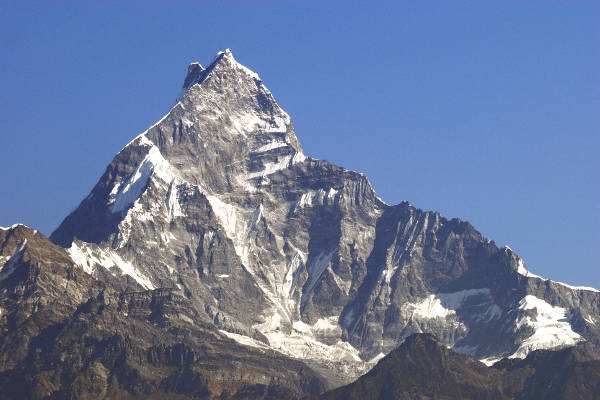
Ghorepani Poon Hill Trek (3-5 days)
The Poon Hill hike is a short, but beautiful trek that typically starts at Nayapul which is one-hour drive from Pokhara. A relatively easy trek, with a maximum elevation of 3,200 meters.
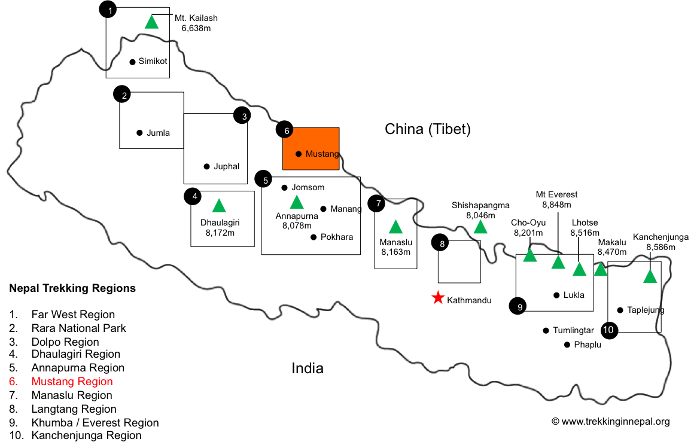
Mustang Region
Mustang lies North-west of Annapurna and extends north onto the Tibetan Plateau. The Upper Mustang region is still home to ancient Mustang-Tibetan communities that sit in stark contrast to the advancing modernisation of Nepal.
The main trail in Mustang runs North-South from Lo Monthang to Jomsom, and all treks require restricted access permits.
Below are the two most popular trekking routes.
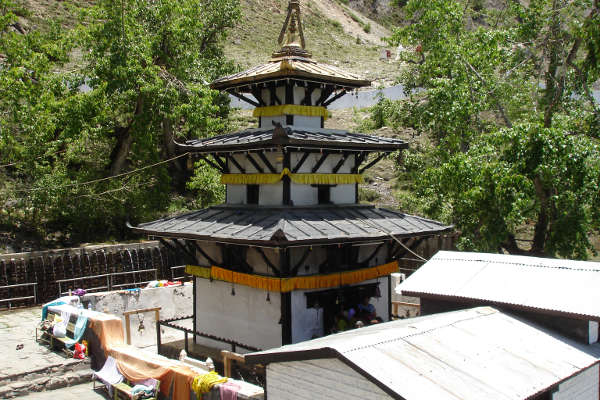
Mustang Circuit (12-14 days)
The Mustang circuit begins in Jomsom and can be combined with various trails to Naar, Damadhar Kund, Saribung and Muktinath. The highest point is Mui La at 4,170 meters and difficulty is easy to moderate.
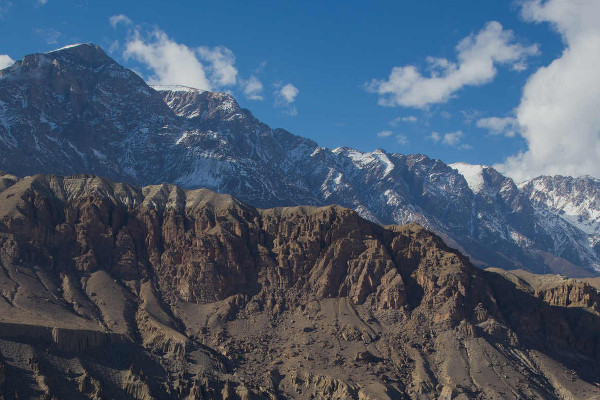
Upper Mustang Trek (18-20 days)
Typically, the Upper Mustang Trek is a continuation of the Mustang Circuit to the Northern communities of the Upper Mustang region. Ideal for those looking to experience the fascinating lives of ancient Mustang communities.
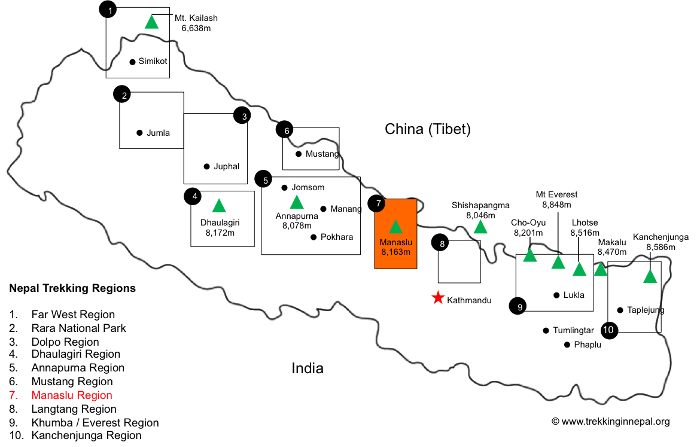
Manaslu Region
Situated in the centre of Nepal, the Manaslu Region encompasses both the Manaslu and Ganesh Himals. The latter consists of seven major peaks which form a natural border with Tibet in the North. Further south-west is the massive summit of Manaslu (8,163 meters), the eighth highest mountain in the world.
Apart from the striking natural beauty of the region, the area is also culturally diverse offering trekkers rich insight into the various groups of Nepalese people that inhabit the regions hills and valleys.
A number of trek variations and trails are available, but the most popular is the Manaslu Circuit Trek , a 12-14 day hike that provides an unbeatable mix of incredible scenery and cultural diversity. Some consider the Manaslu Circuit the finest trek in Nepal. Ideal for the intermediate trekker or anyone with a good degree of fitness.
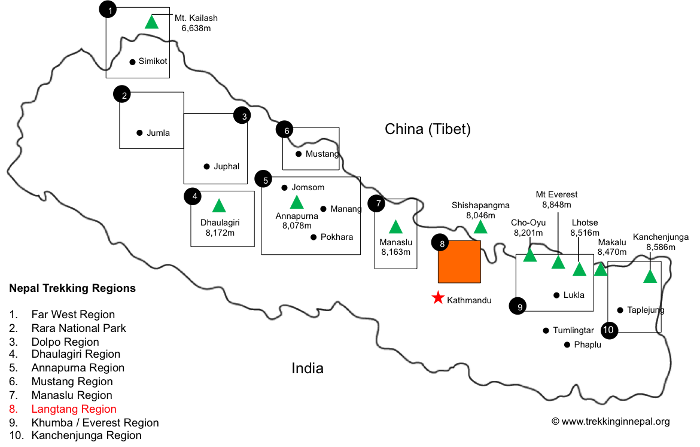
Langtang Region
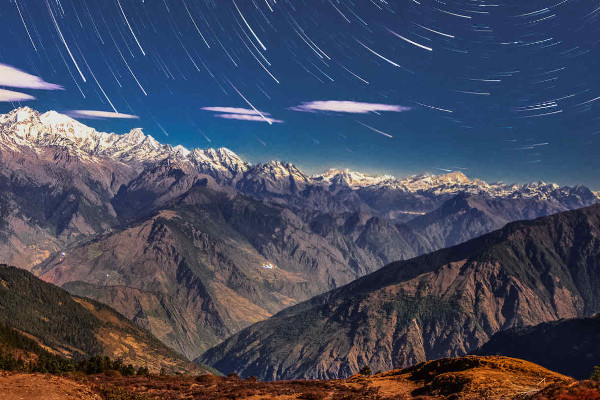
Langtang Valley Trek (7-12 days)
The Langtang hike is a popular trek through the Langtang National Park (second largest national park in Nepal). Treks typically begin in Dunche, the main trading post in the area, and follow the beautiful alpine valley to Kyangjin before circling back. Ideal for novice or intermediate trekkers.
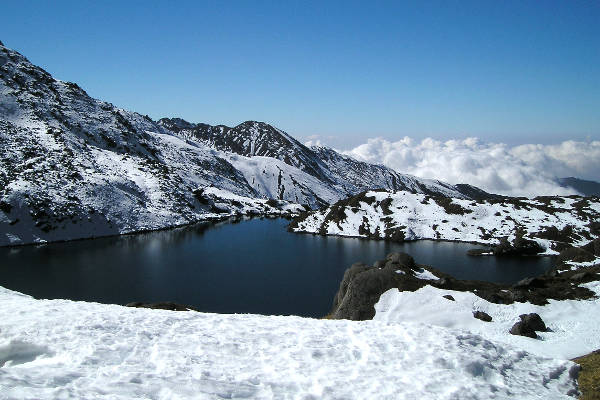
Gosainkunda Trek (10-14 days)
Typically encompasses the Langtang Valley Trek and includes a visit to Gosainkunda Lake, a sacred Hindu lake where pilgrims congregate to wash off their sins. The Gosainkunda hike is a popular trek that is usually approached via Trishuli valley, North-west of Kathmandu.
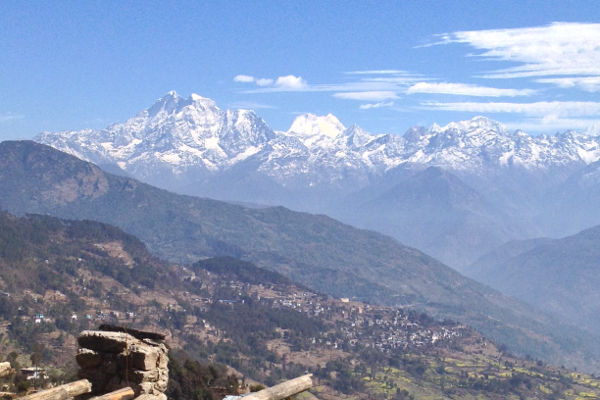
Rolwaling Trek (up to 3 weeks)
Technically situated between the Langtang and Khumba region is the Rolwaling Valley – known as one of the seven hidden valleys in the Himalayas. The area provides a unique quiet spot in a busy region and offers adventurous trekkers and climbers the opportunity to utilise their mountaineering skills as ropes are required!
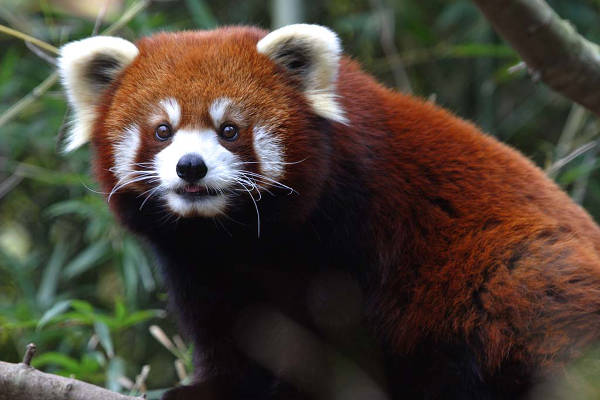
Helambu Trek (7-10 days)
Helambu hike sits just North of Kathmandu and the area is inhabited by Sherpas and Tamang people. Ideal for trekkers who do not want to venture too far from Kathmandu.
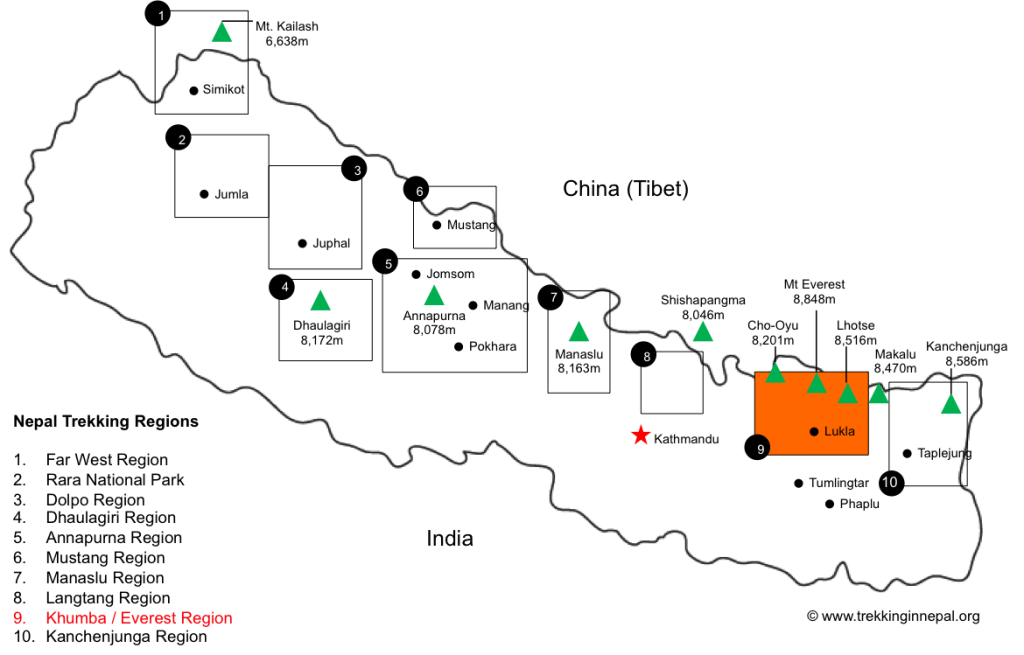
Khumbu / Everest Region
The Everest region, or Khumbu, is based in the Northeast of Nepal and is designated a World Heritage Site. Most of the region is based above 3,000 meters.
The region is grand on all scales. Home to four of the six highest mountains in the world – Mount Everest, Mount Lhotse, Mount Makalu, and Cho Oyu – the region is quite simply one of hyperbole.
See below for Everest Region trekking options.
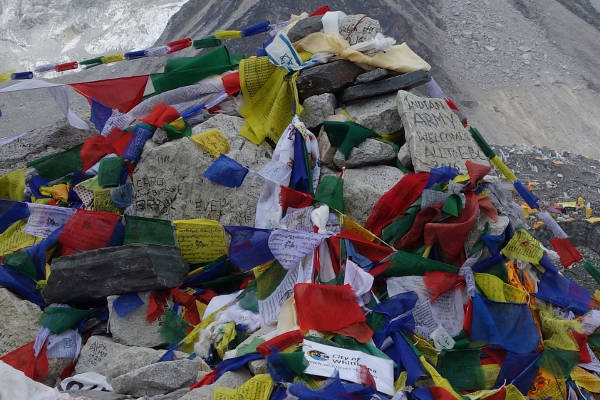
Everest Base Camp Trek (12-14 days)
An extremely popular trek for obvious reasons, the Everest Base Camp hike provide a moderate to easy trek via the legendary Sherpa village of Namche Bazaar and Tengboche Monastery, the highest Buddhist center in Khumbu. Variations on the EBC Trek include the Gokyo Lakes hike or further ‘climbing’ expedition up Island Peak, are also popular.
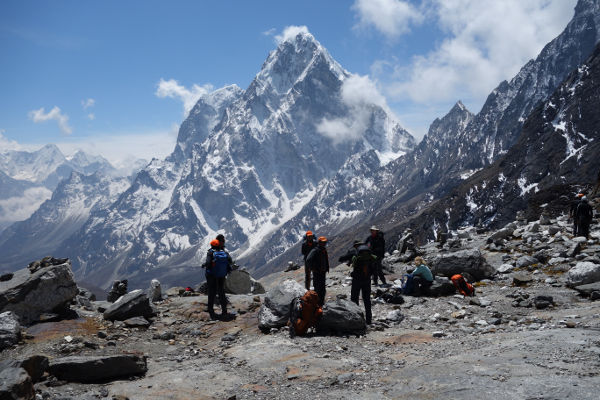
Khumbu Valley Trek (12-16 days)
A classic trek due to its location in the shadow of Sagarmatha (Mt. Everest) in the Sagarmatha National Park. A moderate-to-strenuous trek due to its isolated location, the Khumbu valley hike gives a full trekking in Nepal experience.
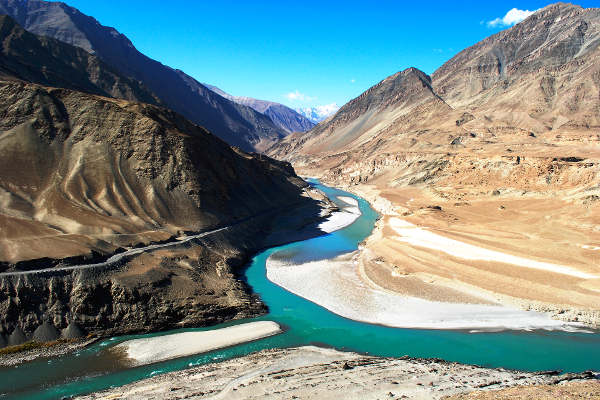
Makalu Base Camp Trek (18-22 days)
A long and strenuous hike (especially the second half) takes trekkers through the Makalu-Barun National Park in the North-east of the Khumbu region, which houses the fifth highest mountain in the world – Makalu (8,470 meters). Not for the faint-hearted, but a great trek that is surprisingly quiet due to its remote location in the region and lack of tea houses. See the Makalu BC hike .
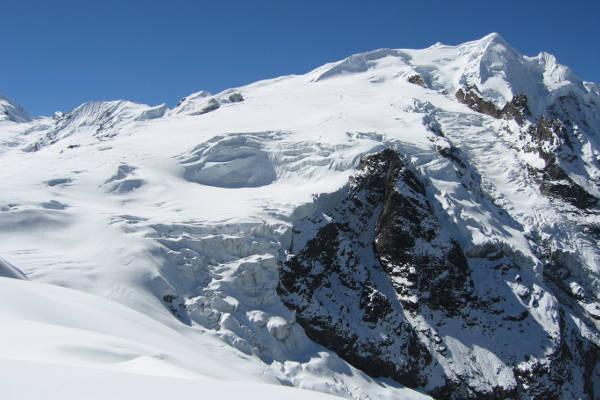
Mera Peak (Nepal trekking peak)
At 6,746 meters, Mera Peak is classified as a Nepal trekking peak . This is to say that it requires some mountaineering experience with ropes used on the final section to the summit. Only recommended for the adventurous soul who has some previous high-altitude trekking and basic mountaineering skills.
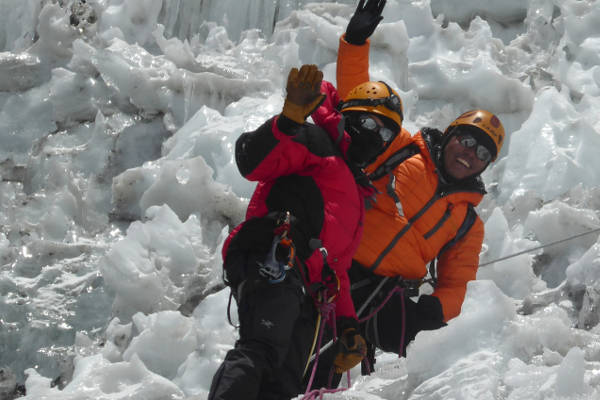
Island Peak (Nepal trekking peak)
A challenging trekking peak in Nepal, Island Peak is usually combined with an Everest Base Camp trek to give one time to acclimatise and prepare for the strenuous ascent of the 6,176-meter summit. Again, this ‘trek’ is only recommended for those with high altitude trekking experience and basic mountaineering skills.
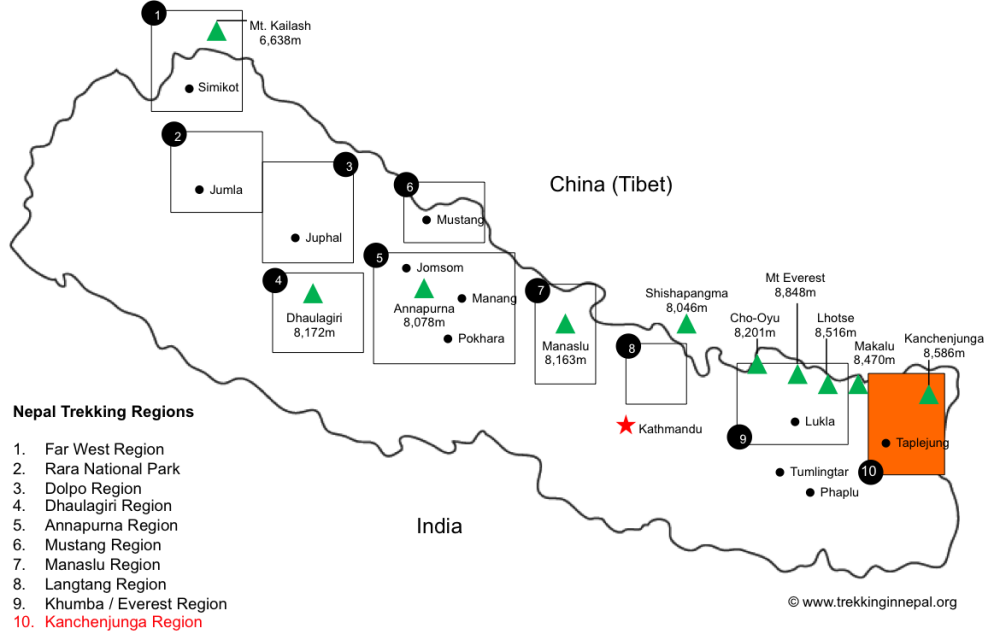
Kachenjunga Region
Home to vast rhododendron forests and the third highest mountain in the world, Mt. Kachenjunga (8,586 meters), this far eastern region of Nepal is remote, rugged and beautiful.
Kanchenjunga massif is characterized by loads of peaks and valleys but can be seen to split into two sections. The southwest face and ridges, around Yalung, and the north face where the Kachenjunga Base Camp is situated.
Treks vary in the region, but most trekkers enter via Taplejung. The most popular trek in the region is the Kachenjunga Base Camp Trek .
Continue browsing...
See more information on Nepal . Or check out these other Nepal hiking articles:
- Short Nepal Trekking Tours
- Easy Nepal Hikes
- Travel insurance for trekking in Nepal
- Best time to hike in Nepal
- Nepal trekking companies recommendations
- Best Things to See in Nepal
- Himalaya Passes
- Climb Mount Everest
- Mount Everest Fun Facts
- Nepal Teahouses - what are they like?
About the author
Mark Whitman
Mark has trekked extensively in Asia, Europe, South America and Africa. He founded Mountain IQ in 2014 with the sole aim to be the best online information portal to some of the most popular mountain destinations around the world. When not writing for Mountain IQ, Mark is out exploring the outdoors with his wife!
Leave a Reply
Your email address will not be published. Required fields are marked
We work with local guides to offer great value adventures at unbeatable prices

- Parikrama Treks Teams and Guide
- Company Registration Legal Documents
- Everest Region
- Annapurna Base Camp Trek
- Annapurna Circuit Trek
- Annapurna Mardi Himal Base Camp Trek
- Restriced Area
- Mera Peak Climbing Expedition
- Adventure Riding Upper Mustang
- Adventure Riding Lower Mustang
- 9 Days Motorbike Riding Adventure in Muktinath
- Epic Kathmandu Lhasa EBC Himalayan Motorbike Adventure
- Himalayan Motorbike Tour to Everest
- Mount Kailash Motorbike Journey
- Nepal and Tibet Motorcycle Tour of Kailash
- Manasarovar Dawa Festival Tour with Kailash Yatra
- Adventure Riding in Bhutan
Restricted Area Trekking
Restricted area trekking: a guided trek to nomadic tribe of unique himalayas.
Going Lodge and Camping trekking in Nepal the Himalayas? Restricted area trek takes you to some of the less-visited trekking Areas of Nepal. In that area, there is a limitation to the number of trekkers able to visit within a year. You will also need to get a special permit for trekking in this region. In Nepal, there are more than 10 areas where you cannot travel without a guide and permit.
Restricted area trekking offers views of magnificent Himalayas. Most of these trails have rough trekking trails and people following Tibetan culture. You will also see old monasteries and shrines.
Restricted area trek offers some of the best tours in a lifetime. These areas are remote and special care even from trekking agencies. Most of the places have fewer tea houses for accommodation. So it is best suited for camping treks. Manaslu Tsum Valley Trek, Upper Mustang Trek, Dolpo Trek are some of the popular treks.
Parikrama Treks is a certified travel agent who can take you on this restricted are trek. We also have some of the special group joining departure dates in a restricted area. Be sure to check out our dates and contact us if it interests you. We will get all the arrangements ready for your trekking in Nepal Restricted area.
Popular Restricted area trekking in Nepal
Upper mustang lodge trek, upper dolpo camping trek, manaslu tsum valley lodge, camping treks, damodar kund trek, nar phu valley trek, kanchanjunga lodge, camping trek, makalu base camp trek, milke danda trek, limi valley camping trek, lumba sumba trekking camping trek.
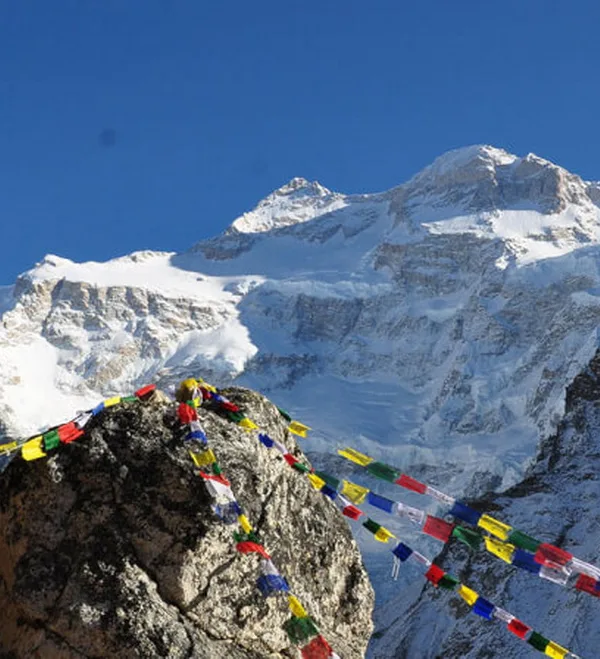
Kanchenjunga Teahouse trek with visit of North and South Base Camp
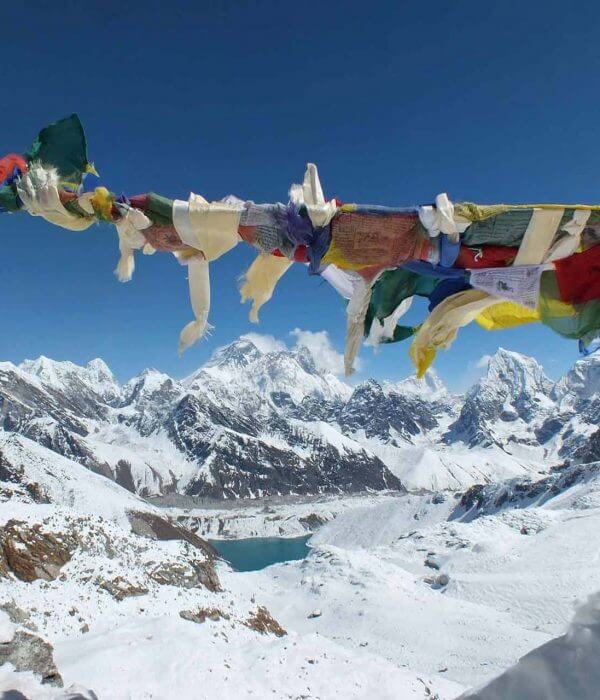
Experience Lumba Sumba wild camping trek during your visit in Eastern Nepal
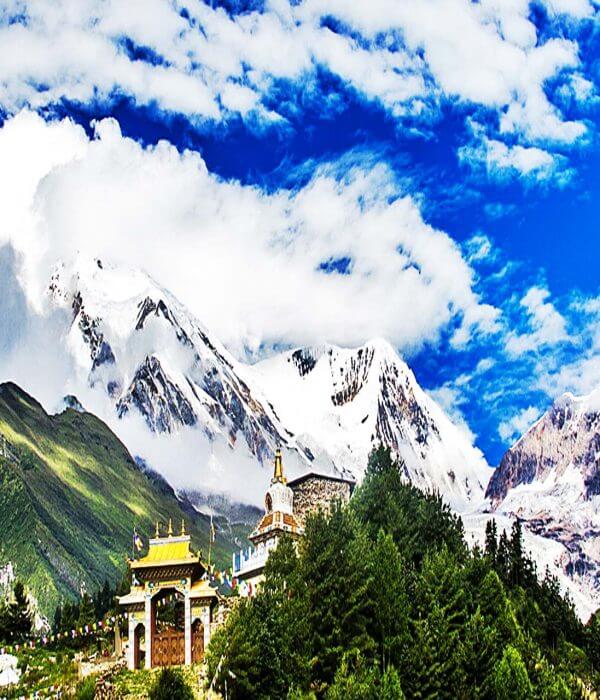
Manaslu Tsum Valley Trek For Best Inner Nepal Himalaya Trekking Experience

Restricted Areas Treks
- 16 Packages
- Popular Treks
- Camping Treks
- Charity Treks
- Family Treks
- Luxury Treks
- Service Treks (GAP)
- Medical Treks
- Tailor made Treks
- Tea House Trek
- National Parks Treks
- New Routes Treks
- Off the Beaten Treks
Nepal has much more trekking and adventurous destination. Some are allowed to visit and some are restricted to travelers. In the restricted areas, travelers need to book the trip through the trekking agencies of Nepal those who are registered and affiliated with the Tourism Board. Most of the northern parts of Nepal are restricted due to the consideration of saving the environment, culture and the mountains over there. Nepal has the borderland in the northern part of Nepal, for the tourist safetly, areas are restricted only for solo travelers. At least two travelers need to be in a group to make it happen.
To issue the special trekking permit must be acquired from the Department of Immigration, for trekking to areas that fall under the restricted zone. For more updated information you can check this official website: http://www.nepalimmigration.gov.np/post/notice-regarding-visa-fee-updates
Trekking Permit Fee Details
Regions/VDCsPermit Fee
1. Upper Mustang
- Lomanthang Rural Municipality (All areas of ward no. 1 to 5)
- Lo-Ghekar Damodarkunda Rural Municipality (All areas of ward no. 1 to 5)
- Baragung Muktichetra Rural Municipality (All areas of ward no. 3 and Satang Village of ward no.5)
- USD 500 per person (for the first 10 days)
- USD 50 per person /Day ( beyond 10 days)
2. Upper Dolpa
- Dolpo Buddha Rural Municipality (All areas of ward no. 4 to 6)
- Shey Phoksundo Rural Municipality (All areas of ward no. 1 to 7)
- Charka Tangsong Rural Municipality (All areas of ward no. 1 to 6)
- USD 500 per person (for the first 10 days)
3. Gorkha Manaslu Area
- Chumnubri Rural Municipality (All areas of ward nos. 1,2,3 and 4)
September – November
- USD 100 per person / week
- USD 15 per person / day (beyond 1 week)
December – August
- USD 75 per person / week
- USD 10 per person / day (beyond 1 week)
- Simikot Rural Municipality (All areas of ward nos. 1,6 and 7)
- Namkha Rural Municipality (All areas of ward no. 1 to 6)
- Changkheli Rural Municipality (All areas of ward no. 3 to 5)
- USD 50 per person / week
5. Taplejung
- Phantanglung Rural Municipality (All areas of ward nos. 6 and 7)
- Mikwakhola Rural Municipality (All areas of ward no. 5)
- Sirijunga Rural Municipality (All areas of ward no. 8)
- USD 20 per person/ week (for the first 4 weeks)
- USD 25 per person /week ( beyond 4 weeks)
6. Lower Dolpa Area
- Thulibheri municipality (All areas of ward no. 1 to 11)
- Tripurasundari municipality (All areas of ward no. 1 to 11)
- Dolpo Buddha Rural Municipality (All areas of ward no. 1 to 3)
- Shey Phoksundo Rural Municipality (All areas of ward no. 8 and 9)
- Jagdulla Rural Municipality (All areas of ward no. 1 to 6)
- Mudkechula Rural Municipality (All areas of ward no. 1 to 9)
- Kaike Rural Municipality (All areas of ward no. 1 to 7)
- USD 20 per person/ week
- USD 5 per person /week ( beyond 1 week)
7. Dolakha
- Gaurishankhar Rural Municipality (All areas of ward no. 9)
- Bighu Rural Municipality (All areas of ward no. 1)
- USD 20 per person/ week
8. Gorkha Tsum Valley Area
Sirdibas-Lokpa-Chumling-Chekampar-Nile-Chule
- Chumnubri Rural Municipality (All areas of ward nos. 3,6 and 7)
- USD 40 per person / week
- USD 7 per person / day (beyond 1 week)
- USD 30 per person / week
9. Sankhuwasabha
- Bhotkhola Rural Municipality (All areas of ward no. 1 to 5)
- Makalu Rural Municipality (All areas of ward no. 4)
- USD 20 per person/ week (for the first 4 weeks)
10. Solukhumbu
- Khumbu Pasang Lahmu Rural Municipality (All areas of ward no. 5)
11. Rasuwa
- Gosaikunda Rural Municipality (All areas of ward no. 1 and some area of ward no. 2)
- USD 20 per person /week
12. Manang
- Narpa Rural Municipality (All areas of ward no. 1 to 5)
- Nasho Rural Municipality (All areas of ward no. 6 and 7)
13. Bajhang
- Saipal Rural Municipality (All areas of ward no. 1 to 5)
- USD 90 per person / week for the first week
- Mugumakarmarong Rural Municipality (All areas of ward no. 1 to 9)
15. Darchula
- Vyas Rural Municipality (All areas of ward no. 1)
- USD 90 per person / week
Restricted Areas Treks Packages

Jomsom to Dolpa Trek via Phoksundo Lake
- Grade Strenuous
- Duration 22 Days
- Activity Trekking

Dolpo to Rara Trek via Shey Gompa
- Duration 25 Days
Upper Dolpo Trek to Shey Gompa
- Duration 24 Days

Tsum Valley Ganesh Himal Base Camp Trek
- Duration 19 Days

Humla Nyinba Valley Trek to Raling Gompa
- Grade Moderate
- Duration 12 Days

Rara and Jumla Trek
- Duration 8 Days

Dolpa Circuit
- Duration 16 Days

Nar Phu Valley Trek
- Duration 14 Days

Phoksundo Lake Trek
- Duration 10 Days
$2350 $2600

Everest Rolwaling Trek
- Duration 30 Days

Upper Mustang Trek

Lower Dolpo Trek
- Duration 17 Days
Unleash your dream
Customize your trip.
- Travelers who are planning to do a trip at your specific requirements can send us via this form. One of our travel planner experts will offer you an exclusive travel holiday deal.
- Let's share our experiences in the Himalayas of Nepal.
- We are flexible as you are.

Photography Tour
Explore Nepal through your lenses

Simply, we are driven by our core values
Get inspired need some inspirations, tmg photo galleries.
Explore trip images captured by travelers.
Watch our videos
About trails, mountains, and stories.
Follow us on Instagram
Know more about our new trips and deals.
Get TMG brochure
Download our brochure to know about us and deals.
Download Brochure
We will send you the download link to your email address.
- Name * First
Unleash Your Dream

- Nepal Tourism
- Nepal Hotels
- Nepal Bed and Breakfast
- Nepal Vacation Rentals
- Flights to Nepal
- Nepal Restaurants
- Things to Do in Nepal
- Nepal Travel Forum
- Nepal Photos
- All Nepal Hotels
- Nepal Hotel Deals
- Last Minute Hotels in Nepal
- Things to Do
- Restaurants
- Vacation Rentals
- Travel Stories
- Rental Cars
- Add a Place
- Travel Forum
- Travelers' Choice
- Help Center
Manaslu or Gokyo - Nepal Forum
- Asia
- Nepal
Manaslu or Gokyo
- United States Forums
- Europe Forums
- Canada Forums
- Asia Forums
- Central America Forums
- Africa Forums
- Caribbean Forums
- Mexico Forums
- South Pacific Forums
- South America Forums
- Middle East Forums
- Honeymoons and Romance
- Business Travel
- Train Travel
- Traveling With Disabilities
- Tripadvisor Support
- Solo Travel
- Bargain Travel
- Timeshares / Vacation Rentals
- Asia forums
- Nepal forum

Has anyone who has trekked both any views on which is better and also the best months to go as we can be flexible. I have also read different opinions on here about the acclimatisation to Gokyo and I'm not sure if we trek in whether that changes anything there.
Many thanks in advance for any replies.
11 replies to this topic

In short: Manalsu is great if you would like to get a (at least somewhat representative) cross section through Nepal. It starts below 1000 meters in a subtropical jungle and with every day you see vegetation, landscape, people and culture change. It has almost everything which once made the Annapurna Circuit the best trek in the world, with (so far) little of its downsides. The mountain scenery (at least from Lho to the end in Dharapani) is amazing as well, but not quite as good as in Gokyo.
Gokyo has in my opinion the very best mountain scenery of all of Nepal's established lodge treks. If mountains are all you're after, go to Gokyo. Additionally you get lots of buddhist / Sherpa culture, which is very unique and definitely worth a visit. What you don't get (compared to Manaslu) is plants, landscapes and cultures that would be found below 2500m. Because you don't go lower than that (unless you chose to travel by road and walk in on foot).
If you have more than two weeks time, you can either add Tsum valley to your Manaslu (Tibetan culture "behind" Ganesh Himal) or either the southern walk in or EBC to your Gokyo trek.
Regarding acclimatization: Both villages of Dohle and Machhermo are not very exciting, but you're supposed to spend a day there each. At the very least in one of them but actually better both. If you like to spend your rest days at a more spectacular place, consider visiting Ama Dablam Base Camp from Pangboche on your way up. Also Ark will recommend you to go up vie Thare and Thore instead of Dhola and Machhermo in a few minutes from now.
Was my name mentioned by any chance? Anyways, I find going up via Dole and Machermo bit suboptimal (if not downright stupid), especially if planning to kill time at those lodge clusters for better acclimatisation. In the same timeframe one can hike the "Cultural Gokyo" route instead going via Tengboche monastery, Phortse village, little walked east side trail to Gokyo via Thore/Thare and Nha Kharkas with quaint lodges (and snow leopards) and return via Renjo La pass to Thame, which has the biggest monastery in Khumbu, 3 times as old as Tengboche. So there. Acclimatization largely depends on how much time is spent on the way up, sleeping in Tengpoche, Thore/Thare and Nha gives one more acclimatisation day compared to a typical too fast Dole - Machero itinerary. Adding one more day/night in Pangpoche in order to visit Ama Dablam BC is even better for acclimatization. This is 500% more interesting than sitting in Dole and Machermo staring at one's phone for 2 days.
If you send me your email by private message I can send you an annotated map of the route.
Many thanks for the replies both. I would like to consider the trek in to Gokyo, which route would you recommend?
For Manaslu I have also read about allowing time to trek out if we cannot get over the pass. Is there a best time of year to ensure getting over or do we just have to have contingency days?
I have send a message to Ark, thanks.
You need to plan some buffer days for Manaslu, because the pass is on the very end of the trek. In case you can't cross, you need to walk back about 5 days to reach the road again. 4 if you're quick. The driest months are Nov, Dec and Jan (with Dec and Jan being very cold and the tea house in Dharamasala might be closed due to the lack of trekkers - leaving November). October (wet in the first half and crowded throughout), February (cold), and March (end of dry season), are okay too, but the only month that's really reliably good weather wise is november. First half might be very crowded too.

If you ask me Gokyo for me in term of views but the pass in manaslu is a challenge . If you want both you can try three pass trek I would reccomend that for you as you will not only go to gokyo but you will get mostly what trekking in solu region has to offer .

I’ve done both treks in the last few years since Covid and though I loved Gokyo personally my favourite trek is Manaslu. As you say though the issue with Manaslu is if you don’t get over the Larkye La it’s a long way back. I was lucky even in mid November to get over the pass and that’s meant to be the best time to go. Manaslu is just so worth the effort though …Samaghan is one of the best villages in Napel when I was there there was an amazing multi day festival something you must won’t get in the Khumbu, sure there were tourists but so what ….not so many they had any impact.
Samdo is also an interesting village on the way up. Namrung for an unfathamable has a luxury hotel well worth the extra cash to stay it .
So if you do Gokyo it’s amazing and for culture Khumjung is an interesting village. The views of AMA dablam etc are superb but if it was my call I’d go Manaslu every time.
Sorry bit of a random train of thought ..
Many thanks Barcaranger, that's quite a positive vote for Manaslu (our guide, Ram, on the last trek is from that area as you may remember and he recommended it but I guess he would!).
Need to get together with our friend now to run through the options and try to fix dates.
If it looks like spring is better for him than November 2025 (I can't go then this year sadly) would this affect the choice between Manaslu and Gokyo?
Guess I may just have to do both in the next couple of years before my legs give up!
I finished the Manaslu circuit just 2 weeks ago, and in 2023 I did the Gokyo Trek returning via Renjo La and of course on the way up through Thare and Thore, Arkienkeli's influenced.
Which is best? Difficult to say, I enjoyed a lot in Mongla, Thare, Gokyo Ri and Renjo La during the Gokyo thing, butttt! I enjoyed the same 2 weeks ago at Pungyen Gompa, Manaslu Base Camp, Birendra Lake and vies from Larke La towards Annapurnas, Larke is challenging because is rock, I like the local atmosphere in Lhi, Lho and Sama.
Which is best? Difficult to say, I enjoyed a lot in Mongla, Thare, Gokyo Ri and Renjo La during the Gokyo thing, butttt! I enjoyed the same 2 weeks ago at Pungyen Gompa, Manaslu Base Camp, Birendra Lake and the astonishing views from Larke La towards Annapurnas, Larke is challenging because is rocky, I like the local atmosphere in Lhi, Lho and Sama, where live has not changed as if 50 years ago.
About aclimatising, if you are not in a rush, you can reach Gokyo Ri and Larke La without altitude sickness.
Side trips in Manaslu Circuit are plentiful and gorgeous!
As a restricted area, a minimum of two pax is required to obtain a permit for Manaslu with a local agency and guide. If you are an experienced hiker you may travel to Gokyo Valley Trek without joining any agencies.
- Visa 10:35 am
- Best cultural trek, not extreme altitude? 10:31 am
- Breathtaking videos of Nepal 8:54 am
- Pheriche, Deboche, Pangboche? today
- Manaslu or Gokyo today
- Land border crossings with India today
- From what date visa extention nepal yesterday
- Permits yesterday
- Jiri - Three Passes. Itinerary and ideas yesterday
- Question on NOC for Indians yesterday
- paying for visa on arrival at airport Apr 14, 2024
- EBC trek recommendation, who to use, what to bring/weather. Apr 14, 2024
- Trekking to Everest Base Camp Apr 14, 2024
- Mera Peak advice Please! Apr 13, 2024
- World Expeditions- anyone used them? 7 replies
- Kolkata to Nepal/Kathmandu transport options 3 replies
- Nepal tour operators 5 replies
- Accommodation in Boudha, near the Stupa 3 replies
- Flight from Kathmandu to Pokhara 8 replies
- Hire car with driver from Kathmandu 94 replies
- ashrams in nepal? 29 replies
- Flight to Kathmandu from India 2 replies
- Is Nepal safe for travel: May 2012? 13 replies
- Dashain 2012 2 replies
- Itinerary for Gosainkund and Helambu
- New Sticky Thread for posters to add their recent Nepal trip / trek reports.
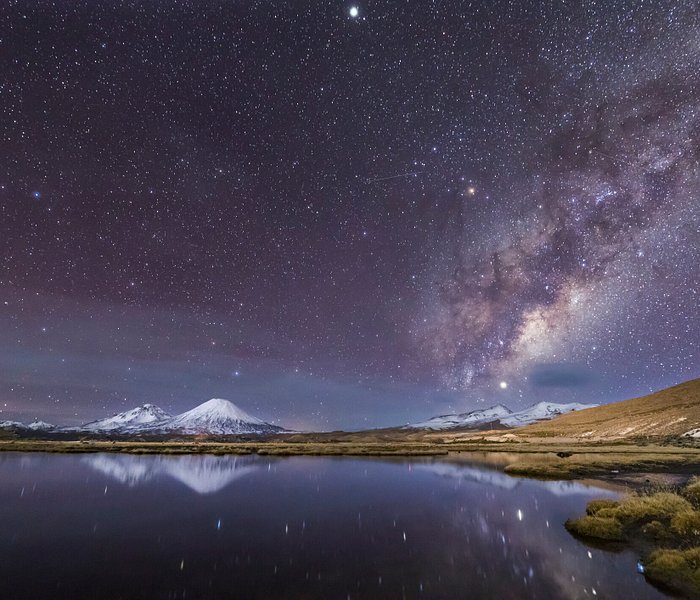

Passing Thru Travel
The 10 Best Treks in Nepal’s Majestic Mountains 2024
Posted: February 21, 2024 | Last updated: February 21, 2024
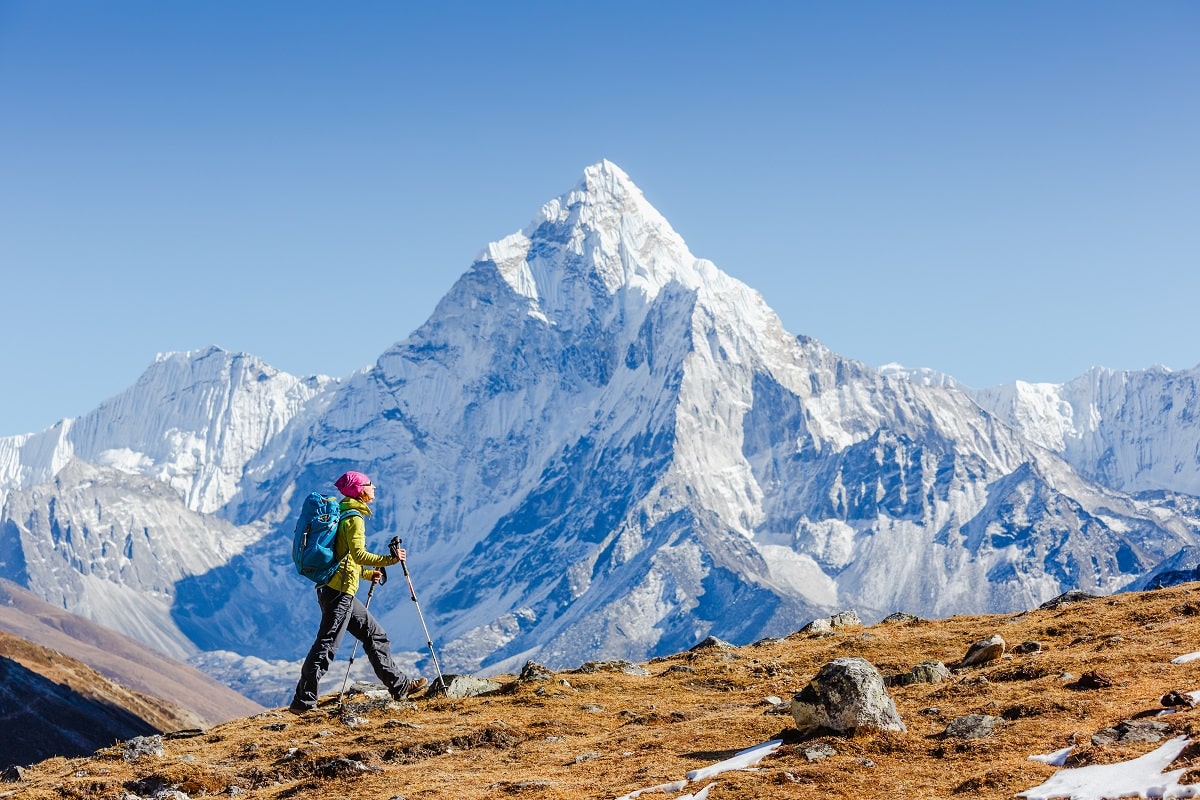
Nestled between the towering peaks of the Himalayas, Nepal is a land of unparalleled natural beauty and a haven for trekkers. From the iconic Everest Base Camp to the serene trails of the Annapurna region, Nepal’s mountains offer a diverse array of trekking experiences, each more awe-inspiring than the last. This guide will take you through 10 of Nepal’s most majestic mountain destinations, providing insights and practical advice for your trekking adventure.
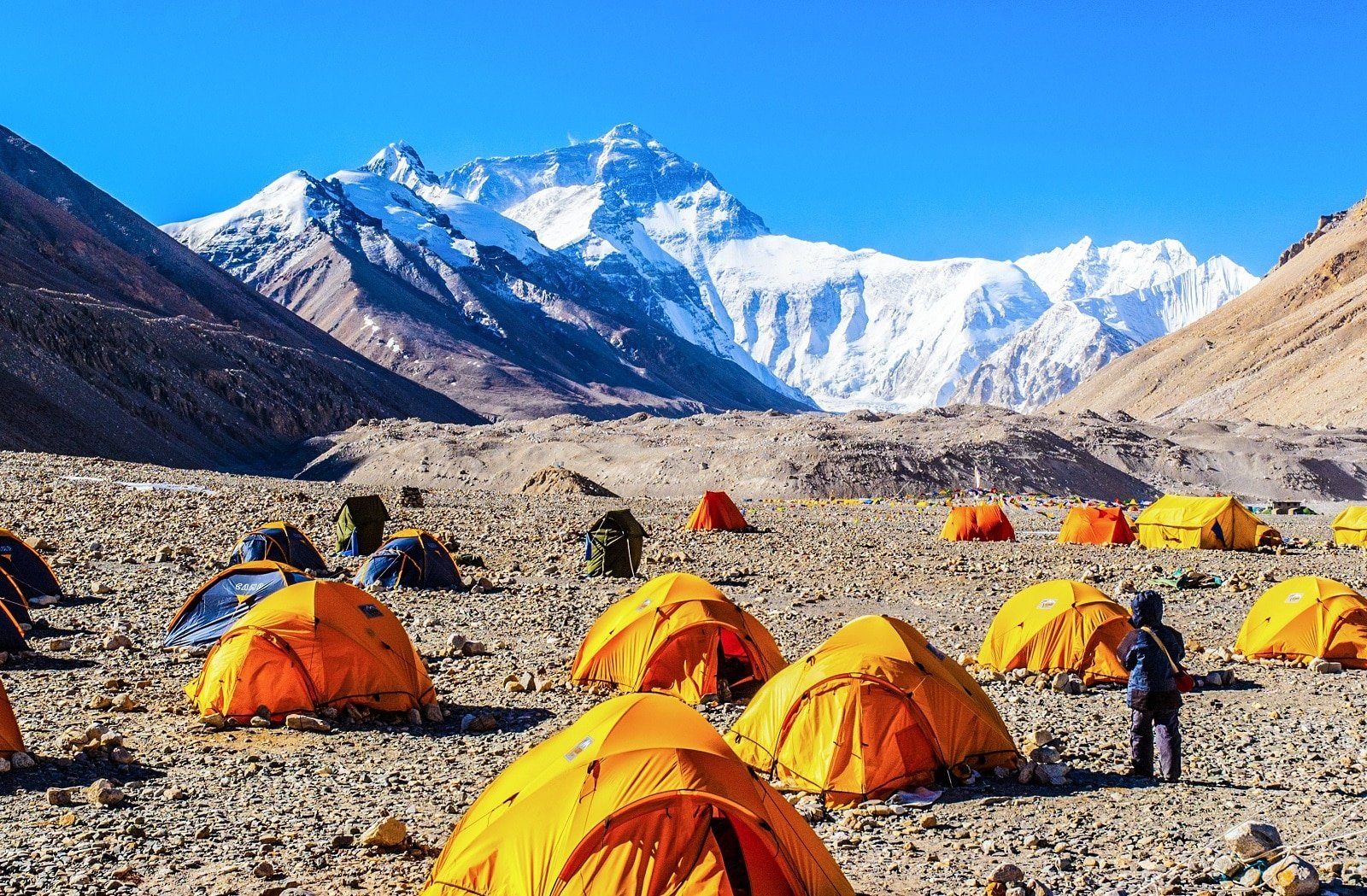
1. Everest Base Camp
Embarking on the Everest Base Camp trek, you’ll journey through the heart of the Himalayas, where the world’s highest peaks, including Everest, Lhotse, and Nuptse, tower above. Starting with a thrilling flight to Lukla, the trek takes you through traditional Sherpa villages, Buddhist monasteries, and along the Dudh Kosi River. The route is challenging yet rewarding, with acclimatization days in Namche Bazaar and Dingboche. The final ascent to Base Camp offers a stunning view of the Khumbu Icefall, making all the effort worthwhile.
Insider’s Tip: Acclimatize properly to avoid altitude sickness.
When To Travel: Pre-monsoon (March to May) or post-monsoon (September to November).
How To Get There: Fly to Lukla from Kathmandu and start your trek from there.
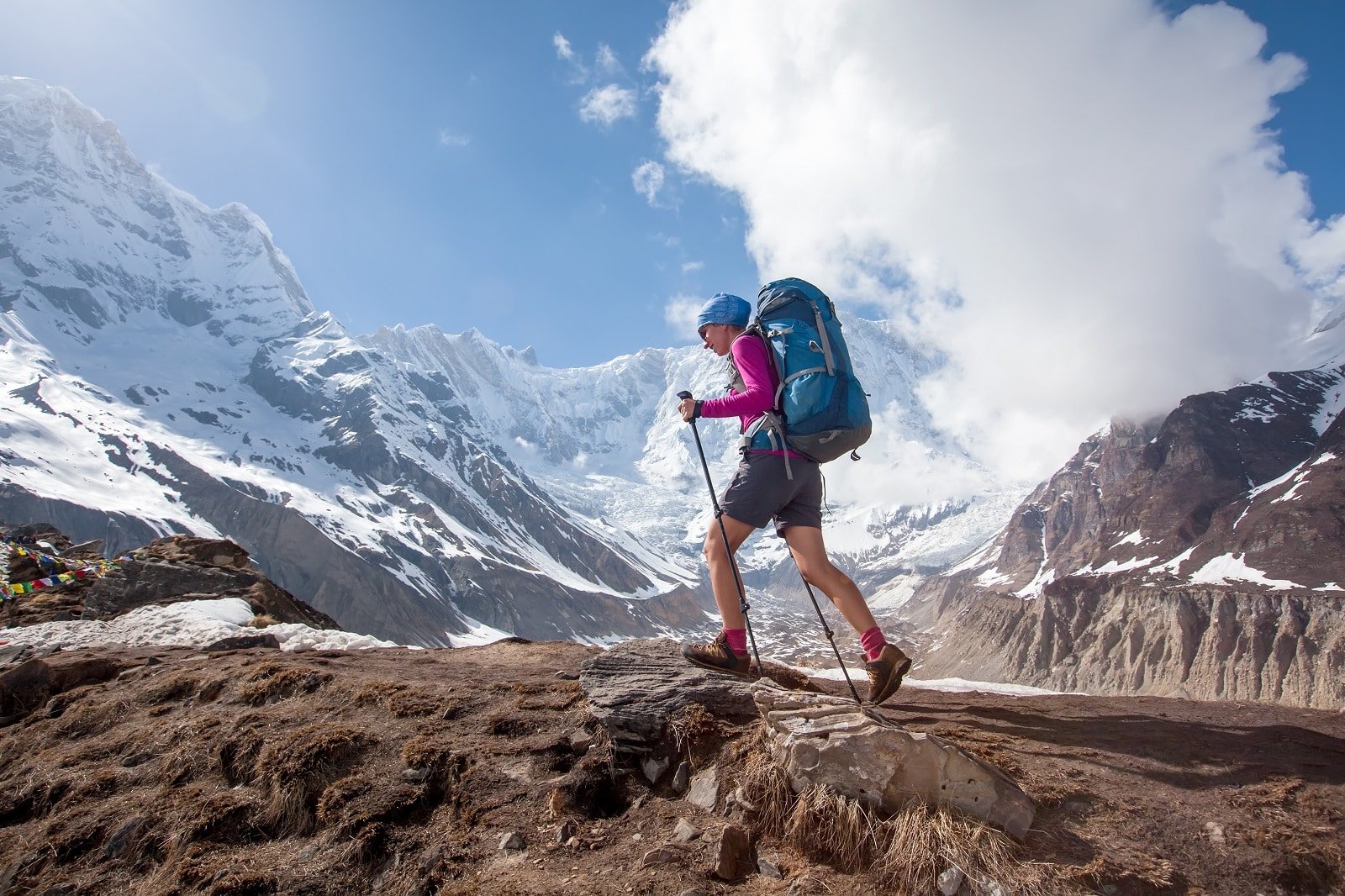
2. Annapurna Circuit
The Annapurna Circuit is a classic trek that takes you around the majestic Annapurna massif. This journey offers a remarkable diversity of landscapes, from the subtropical jungle of the Marshyangdi Valley to the arid, Tibetan-like terrain of the Upper Mustang. Crossing the Thorong La Pass, the trek’s highest point, is a challenging but exhilarating experience. The trek also allows for cultural immersion in the mountain communities of the Gurung and Manangi people.
Insider’s Tip: Take side trips to the ice lakes or Tilicho Lake for additional stunning views.
When To Travel: March to May and October to November for the best weather conditions.
How To Get There: The trek typically starts in Besisahar or Bhulbhule, accessible by road from Kathmandu or Pokhara.
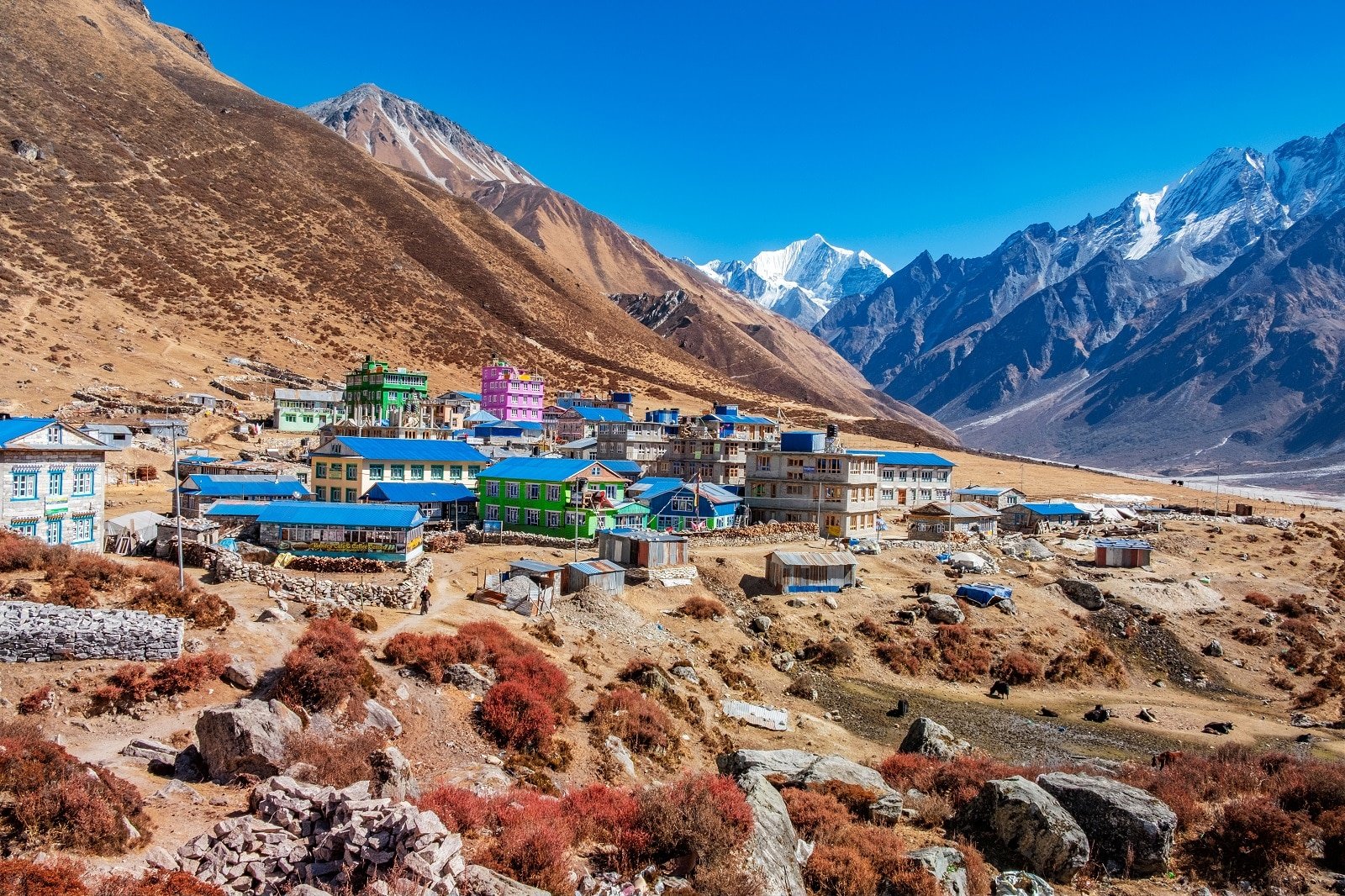
3. Langtang Valley
The Langtang Valley trek offers a quieter, more intimate Himalayan experience. It begins with a drive to Syabrubesi and a trek through forests, pastures, and traditional villages. The valley provides close-up views of Langtang Ri and Langtang Lirung. The trek also includes a visit to Kyanjin Gompa, a significant Buddhist monastery, and an optional climb to Tserko Ri for panoramic mountain vistas. This region was heavily affected by the 2015 earthquake, and trekking here supports local recovery efforts.
Insider’s Tip: Extend your trek to Gosaikunda Lake for a spiritual experience.
When To Travel: March to May and September to November for clear skies and pleasant temperatures.
How To Get There: Drive to Syabrubesi from Kathmandu, the starting point of the trek.
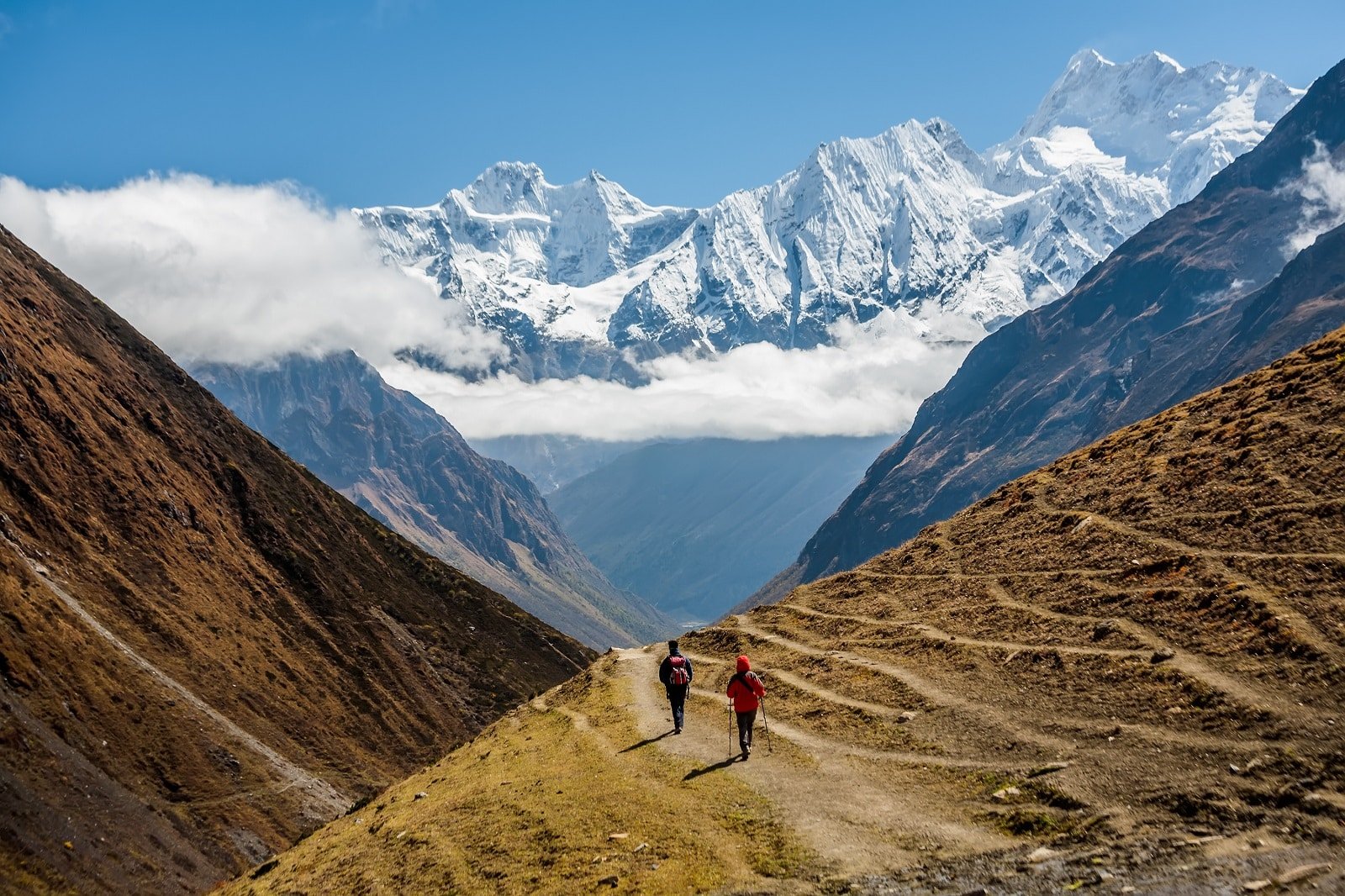
4. Manaslu Circuit
The Manaslu Circuit trek circles the majestic Manaslu, the world’s eighth-highest peak. This trek is less crowded than its more famous counterparts. It offers a look into the untouched natural beauty and culture of the Nepali Himalayas. The trek involves crossing the Larkya La Pass and traverses through Budhi Gandaki Valley, known for its mix of Hindu and Tibetan Buddhist villages. The circuit is a challenging trek, blending cultural richness and scenic splendor.
Insider’s Tip: Ensure you have a guide, as the Manaslu trek requires special permits.
When To Travel: March to May and September to November are ideal.
How To Get There: The trek starts at Arughat or Soti Khola, which can be reached by bus or jeep from Kathmandu.
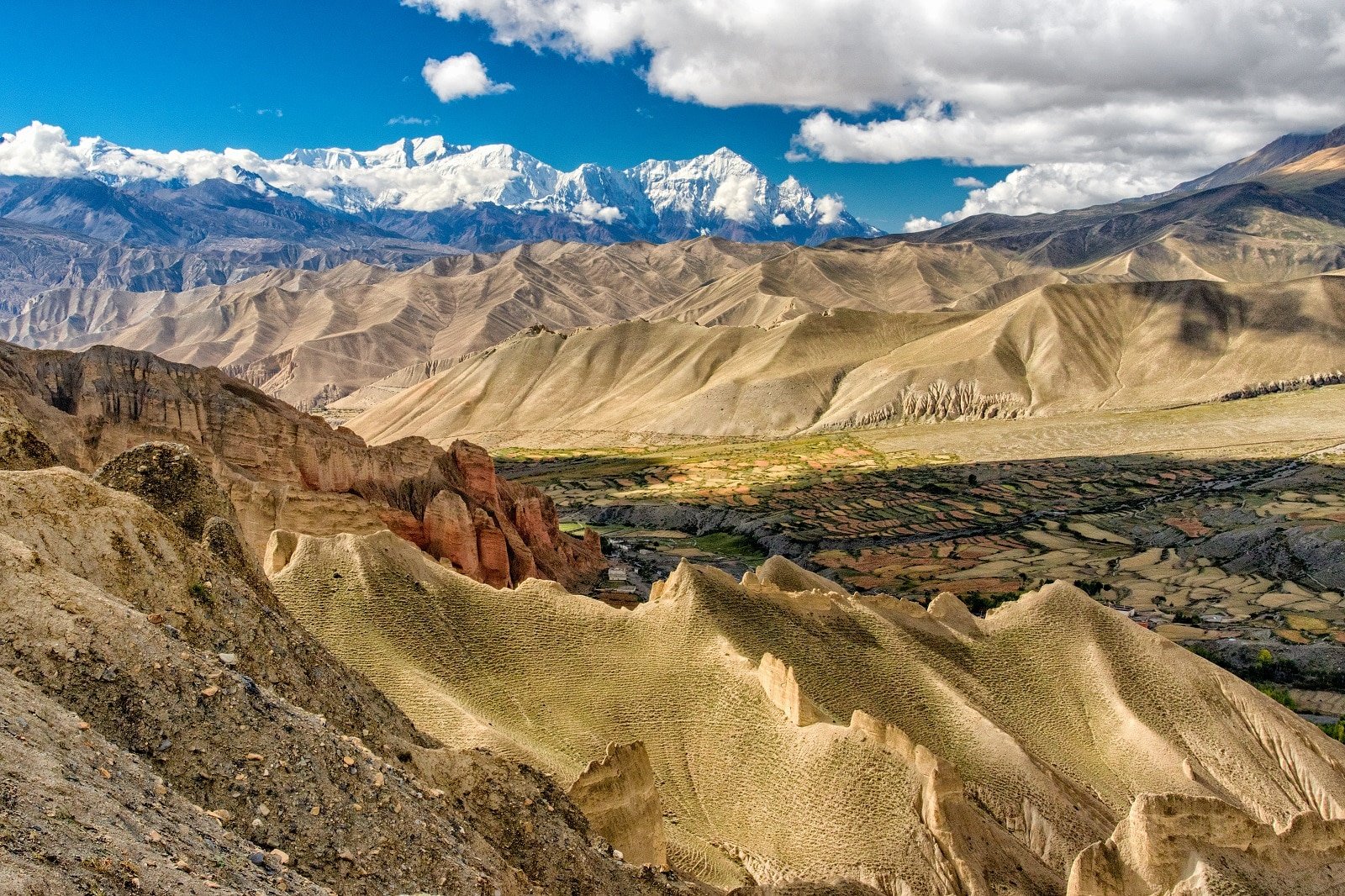
5. Upper Mustang
Trekking in Upper Mustang takes you to a region that was once an independent kingdom. The landscape here is more desert-like, characterized by eroded canyons and colorful stratified rock formations. Lo Manthang, the walled capital, is a highlight, with its monasteries and royal palace. This area is culturally and geographically more akin to Tibet, offering a unique trekking experience distinct from the rest of Nepal.
Insider’s Tip: Visit the ancient monasteries and the royal palace in Lo Manthang. Stay at the beautiful Shinta Mani Mustang.
When To Travel: May to October, as the region lies in the rain shadow area.
How To Get There: Fly or drive to Jomsom, then trek or drive to Lo Manthang.
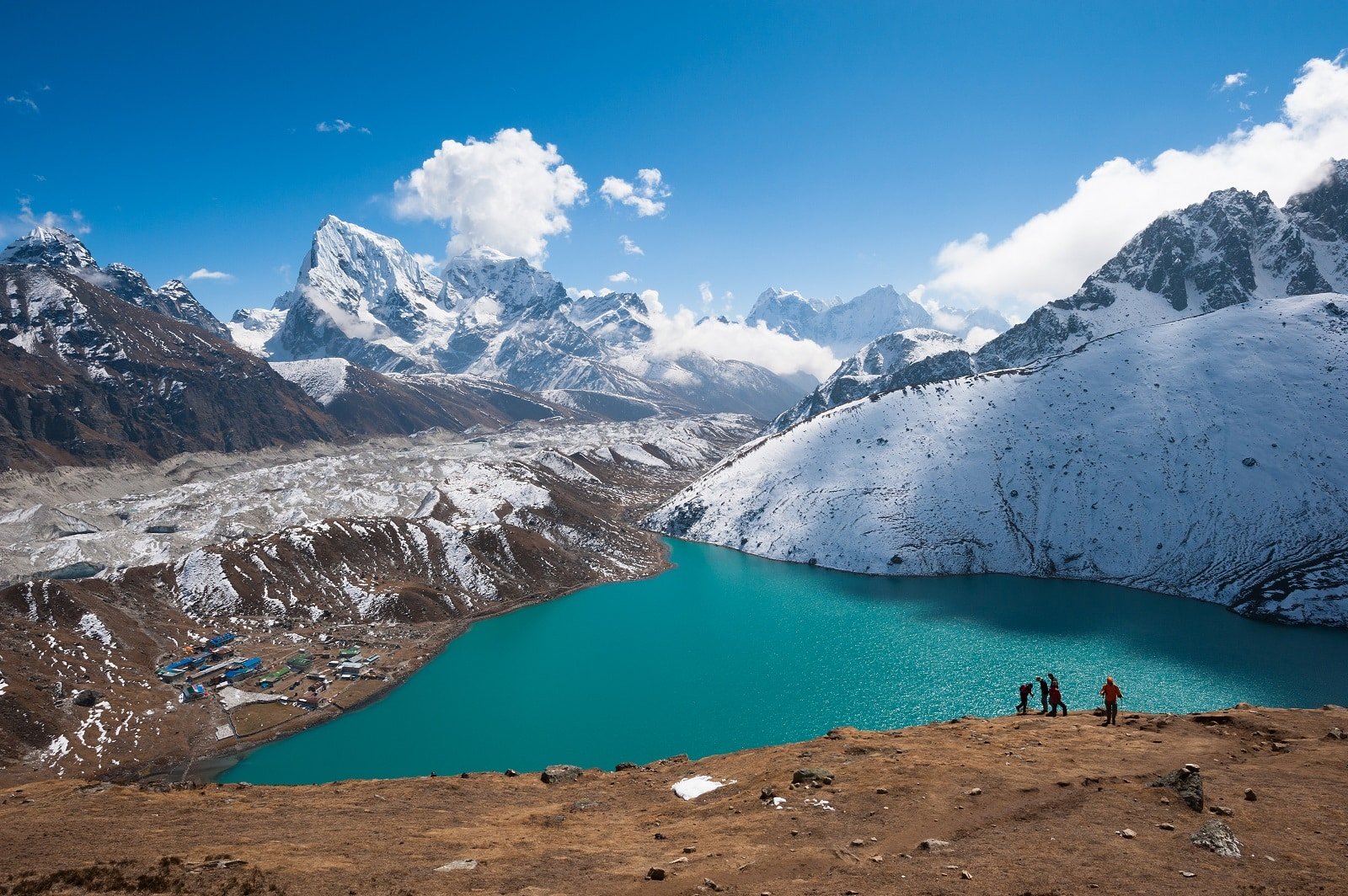
6. Gokyo Lakes
The Gokyo Lakes trek is a fantastic alternative to the Everest Base Camp trek, taking you to a series of stunning high-altitude lakes in the Gokyo Valley. The trek is less crowded and provides spectacular views of Everest and surrounding mountains. Climbing Gokyo Ri offers one of the best viewpoints in the Everest region. The trek passes through Sherpa villages, offering insight into the local culture.
Insider’s Tip: Trek during the full moon for spectacular night views of the mountains.
When To Travel: March to May and September to November for the best weather.
How To Get There: Similar to Everest Base Camp, fly to Lukla and follow a different trail.

7. Poon Hill
The Poon Hill trek is ideal for those looking for a shorter hike in the Annapurna region. It’s known for offering some of the most spectacular mountain views, especially at sunrise from Poon Hill itself. The trek passes through rhododendron forests and Gurung villages, giving you a chance to experience the culture of the central Himalayan region. The trek starts and ends in Nayapul, a short drive from Pokhara.
Insider’s Tip: Carry enough cash, as there are no ATMs on this route.
When To Travel: October to November and March to April for clear skies and good weather.
How To Get There: The trek starts from Nayapul, which is a short drive from Pokhara.
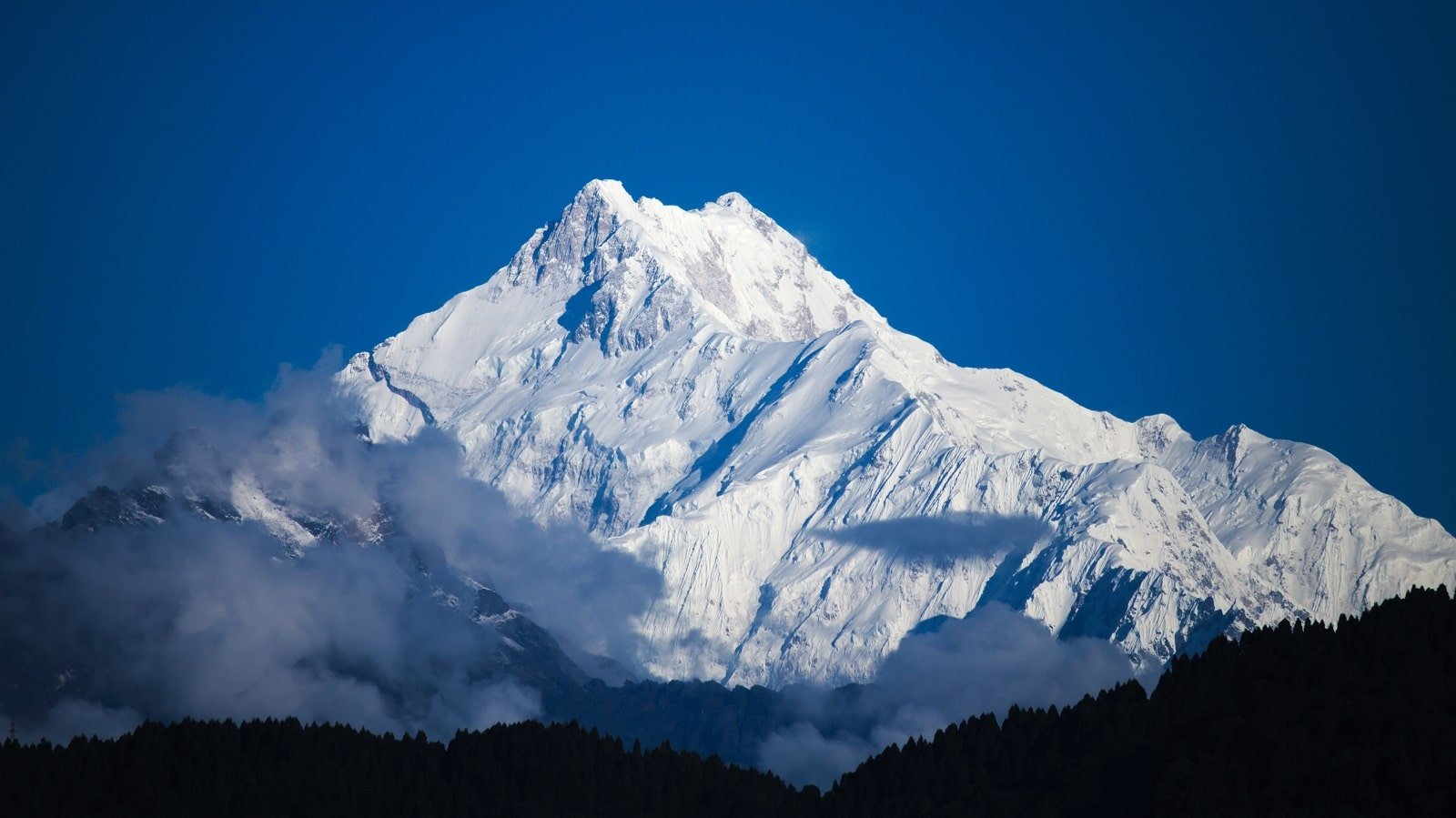
8. Kanchenjunga Base Camp
The Kanchenjunga Base Camp trek is a challenging and adventurous journey to the base of the world’s third-highest mountain. This remote trek offers stunning views of Kanchenjunga and a chance to experience pristine wilderness. The trek passes through diverse ecosystems, traditional villages, and high alpine terrain. It’s a trek for those seeking solitude and unspoiled nature.
Insider’s Tip: Be prepared for basic accommodations and facilities, as this is a less developed trekking route.
When To Travel: March to May and September to November for stable weather.
How To Get There: Fly or drive to Bhadrapur, then drive to Taplejung, the starting point of the trek.
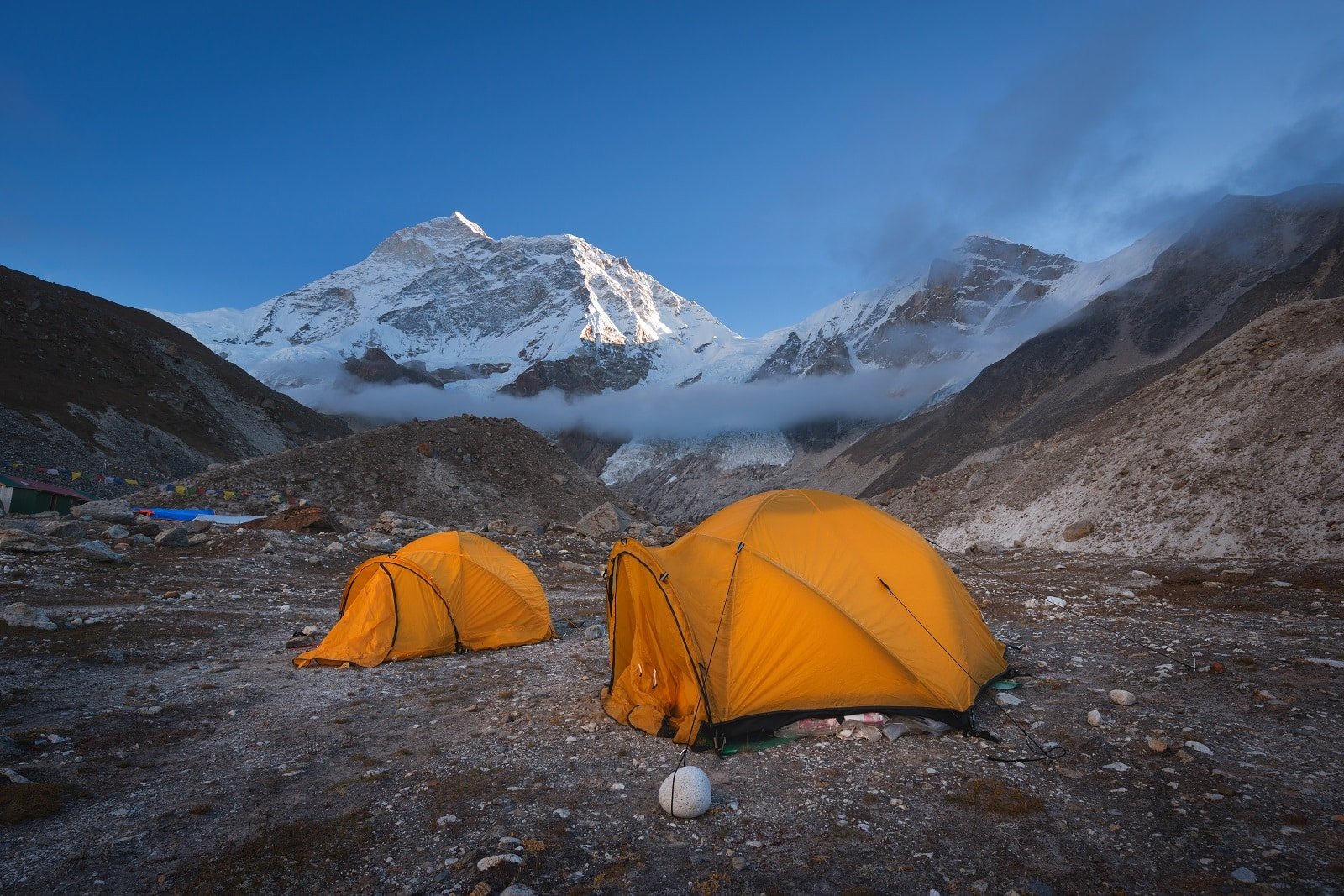
9. Makalu Base Camp
The Makalu Base Camp trek is a challenging journey to the base of Mount Makalu, the world’s fifth-highest mountain. This trek takes you through some of Nepal’s most remote and wild areas, offering stunning views of the eastern Himalayas. The Makalu Barun National Park, through which the trek passes, is a biodiversity hotspot with a rich variety of flora and fauna.
Insider’s Tip: Be physically and mentally prepared for a challenging trek with basic facilities.
When To Trave: Pre-monsoon and post-monsoon periods for the best conditions.
How To Get There: Fly to Tumlingtar from Kathmandu, then drive to Num, the starting point of the trek.
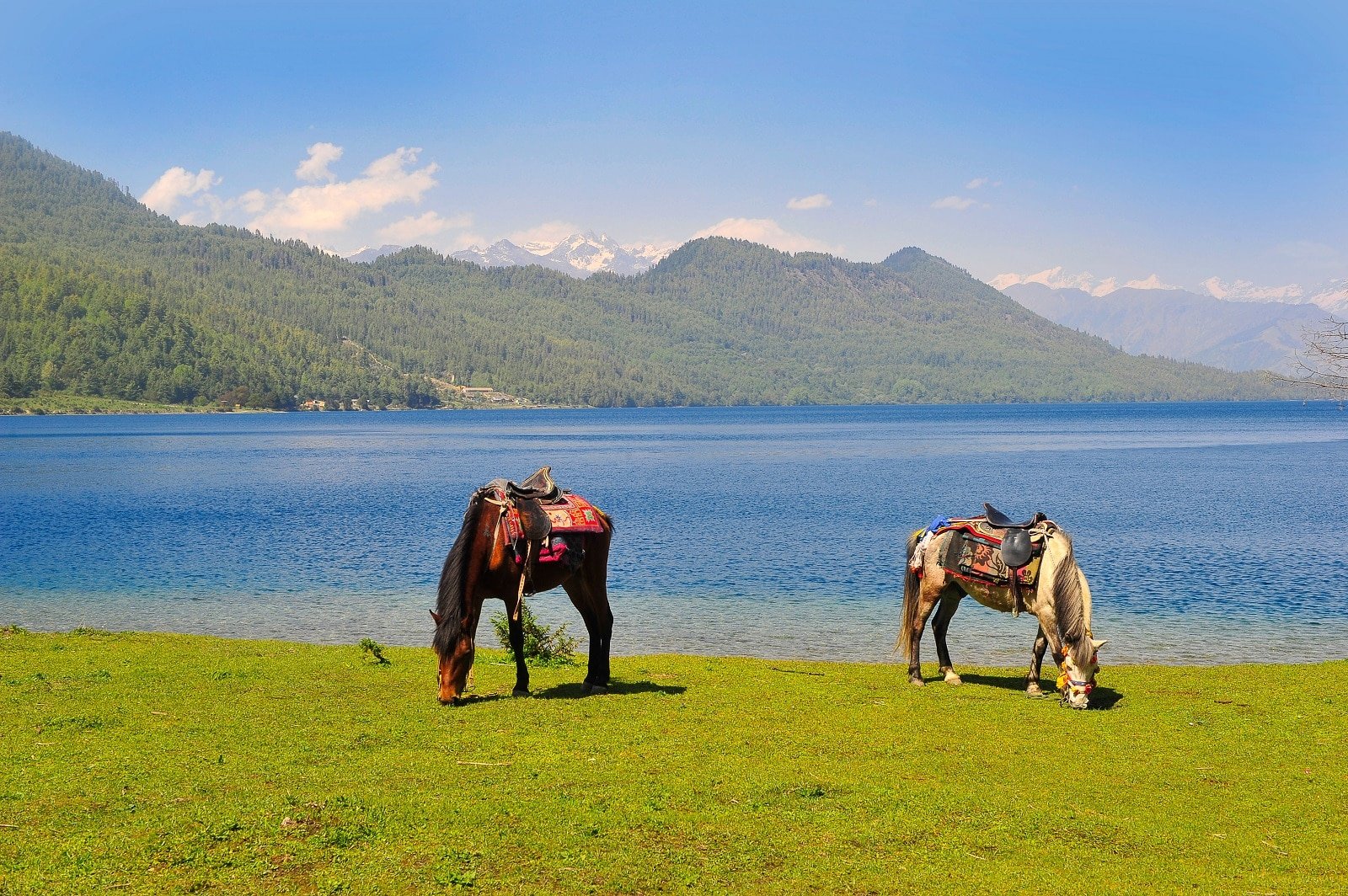
10. Rara Lake
Trekking to Rara Lake offers a serene experience away from the more popular trekking routes. Rara, the largest lake in Nepal, is known for its clear blue waters and scenic beauty. The trek to the lake is an adventure in itself, passing through remote Jumla and Mugu districts. The area around the lake, Rara National Park, is home to a variety of wildlife and offers tranquility unmatched in other parts of Nepal.
Insider’s Tip: Visit the nearby Rara National Park for a chance to see unique wildlife.
When To Travel: September to October and April to May for the best trekking conditions.
How To Get There: Fly to Nepalgunj from Kathmandu, then to Jumla, from where the trek to Rara Lake starts.
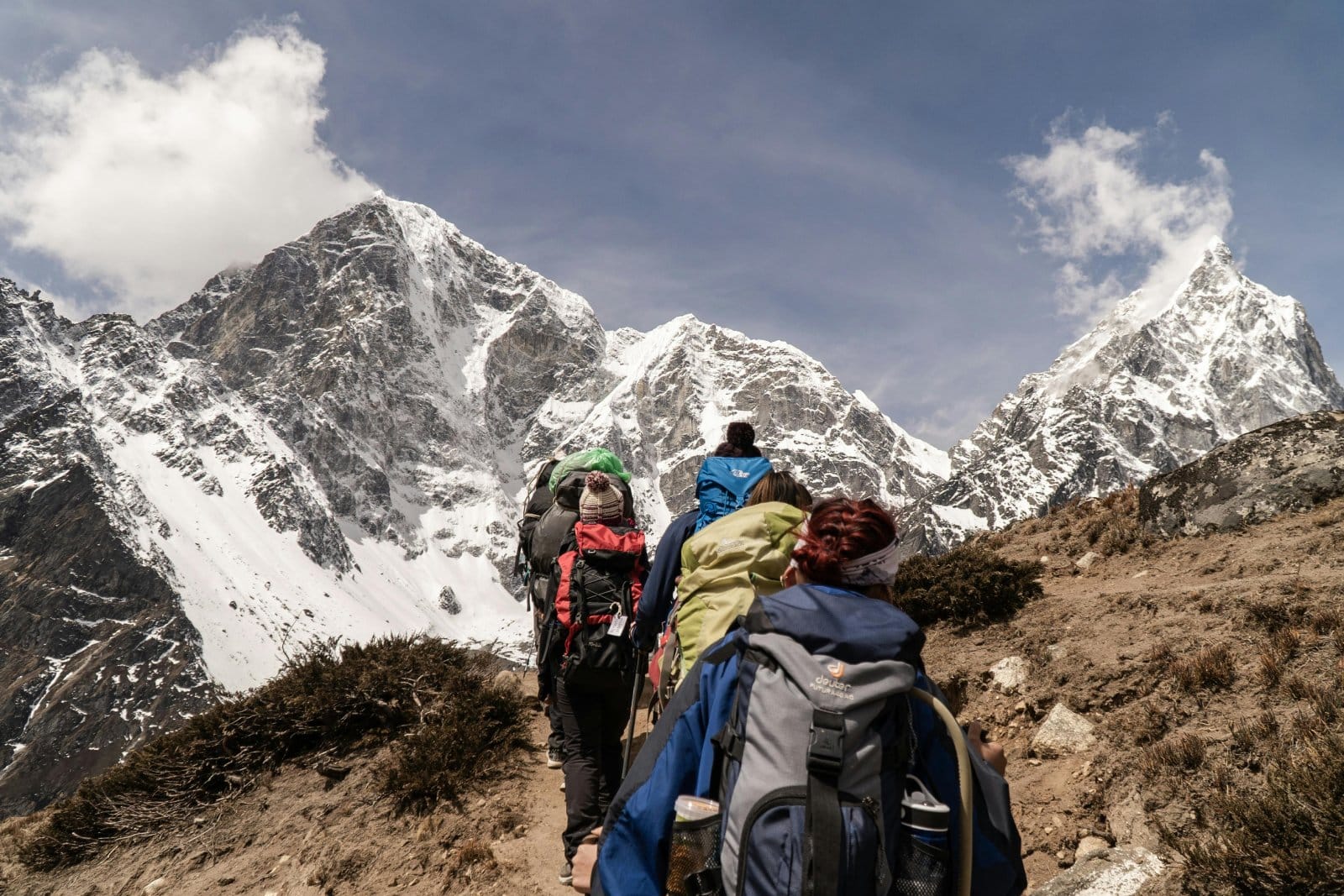
The Bottom Line
Trekking in Nepal is more than a physical journey; it explores some of the most majestic landscapes on Earth. Each destination offers its unique charm, from the world-renowned Everest Base Camp to the tranquil trails of Rara Lake. As you trek through these mountains, you’ll not only witness breathtaking vistas but also immerse yourself in the rich culture and hospitality of the Nepali people. Pack your bags, lace up your boots, and prepare for an adventure that will leave you with memories to last a lifetime.
More Articles Like This…
Barcelona: Discover the Top 10 Beach Clubs
2024 Global City Travel Guide – Your Passport to the World’s Top Destination Cities
Exploring Khao Yai 2024 – A Hidden Gem of Thailand
The post The 10 Best Treks in Nepal’s Majestic Mountains 2024 was republished on Passing Thru with permission from The Green Voyage .
Featured Image Credit: Shutterstock / Olga Danylenko.
For transparency, this content was partly developed with AI assistance and carefully curated by an experienced editor to be informative and ensure accuracy.
More for You
Ketanji Brown Jackson's New Warning to Supreme Court
How to 'quiet quit,' from a former teacher who did it for 2 years so she could enjoy a better life while still getting a paycheck
Traumatic Disney Movies That Scarred a Generation of Children
16 Compliments You Didn’t Realize Are Actually Pretty Insulting
Top 20 Saturday Night Live Sketches That Broke the Whole Cast
Largest crane on east coast removes massive chunks of fallen Baltimore bridge
I Lost White Friends When I Finally Spoke Out
Panned M. Night Shyamalan Sequel Becomes Netflix Hit Five Years Later
4-Year-Old Living With One of the Rarest Disorders in the World
12 safest places if World War 3 breaks out
People With Low Emotional Intelligence Are Known to Use These 4 Phrases
50 of the most memorable TV lines ever written
Republicans Suddenly Cancel Multiple Bills
I've lived in a van full-time for 3 years. Here are the 5 biggest downsides no one talks about.
The Pool Noodle Hack That Makes Spray Painting Cabinet Doors A Breeze
The Food City Anthony Bourdain Considered One Of His All-Time Favorites
78 Riddles for Adults That Will Test Your Smarts
10 pairs of movies with strikingly similar plots that came out the same year
I study people with high emotional intelligence for a living—8 things they never ever do when talking to others
What It Means to Be Fraysexual—Everything You Need to Know
Tar Heel team begins preservation of ancient Nepal temple
Religious studies scholar and computer scientist want to create 3D model of 1,500-year-old Buddhist shrine.
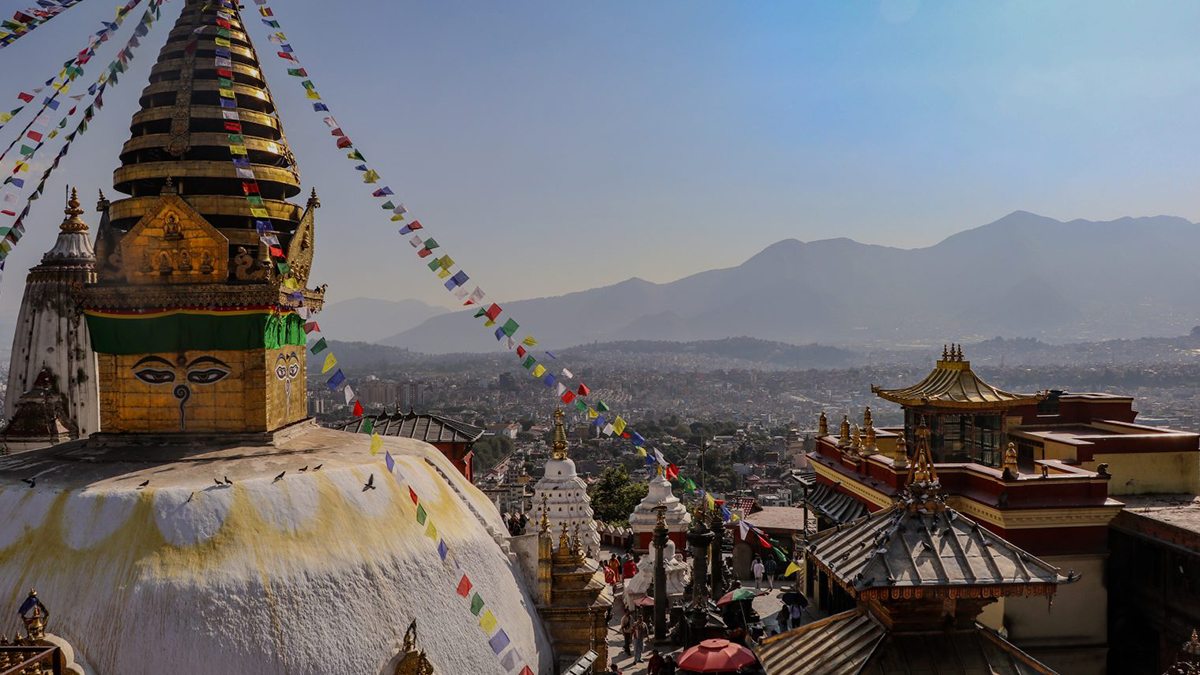
In a groundbreaking initiative, a team from Carolina’s College of Arts and Sciences traveled to Nepal in October to begin the digital preservation of one of the country’s most venerable religious shrines. The 1,500-year-old Swayambhu Temple, a jewel of Buddhist heritage perched atop a hill in the Kathmandu Valley, is one of 10 UNESCO World Heritage sites in Nepal.
Lauren Leve , an associate professor of religious studies, and Jim Mahaney , a research scientist in the computer science department, started the long process of capturing the data needed to create an accurate 3D model of the entire temple complex. One of the project’s goals is to allow UNC-Chapel Hill students a chance to visit Swayambhu in virtual reality.
The project leverages the distinct skill sets of Leve and Mahaney to both access and capture this sacred site. Leve and Mahaney are using a three-pronged data capture approach, combining 3D laser scans, photogrammetry and drone photography to create three separate models of the temple complex. The three models will then be combined to form one photorealistic model of the temple complex which will be viewable on multiple device types, so that access to the model is not limited by the technology available in different parts of the world.
Crowds, monkeys and lots of data
One challenge of capturing Swayambhu was working around crowds of people and animals. Typically, a historic site would be closed to allow for scanning and photogrammetry, but as an active temple, Swayambhu could not be closed and is visited by worshippers and tourists nearly 24 hours a day.
While the humans could be reasoned with, a local population of more than 400 rhesus macaque monkeys also has free range over the entire site. The monkeys refused to take direction from the team, often flaunting their independence by climbing about in the background of the scans. This interference will require hours of additional post-processing to remove monkeys from the 3D model.
Because of the task’s immense scale, Leve and Mahaney partnered with a local heritage preservation group, Baakhan Nyane waa (which translates from the Newar or Nepal Bhasa language as “Come, listen to stories”), and the Kathmandu Engineering College. Raj Maharjan from Baakhan Nyane waa worked with Mahaney to teach graduate students from the college in a seven-day course on laser scanning and photogrammetry, which included many hours of hands-on fieldwork at Swayambhu.
During the course, the team completed 92 scans and took thousands of photos from the ground and hundreds from the sky. The work of combining these into a 3D model will take many months and will provide opportunities for UNC-Chapel Hill computer science students to work with this dataset not only on editing process but also to explore various advanced techniques in virtual reality, such as redirected walking.
Students in Nepal will also continue to work with the data, making this an international collaboration that not only works to create an outstanding model of the site but considers the subtle nuances of how the site is viewed by the Nepalese.
While the amount of data collected on this first trip is vast, additional visits to Nepal are necessary to capture the entire temple. In a planned trip in October 2024, the team will begin expanding the model to include more of the structures located adjacent to the main temple.
This work is supported by a CFE/Lenovo Instructional Innovation grant with additional hardware support from Nvidia and the School of Data Science and Society.
Read more about this trip and the precursor to it .
In a campus email, Lee H. Roberts wrote it's a privilege to interact with students and inspiring to learn about the diverse range of interests they're working on.

Career Treks event highlights public professions
School of Education students networked in Raleigh with representatives from 11 state agencies.

Global studies scholar aspires to diplomacy
After earning a master’s degree, Kat Goodpaster became assistant director of Carolina’s Russian Flagship Program.
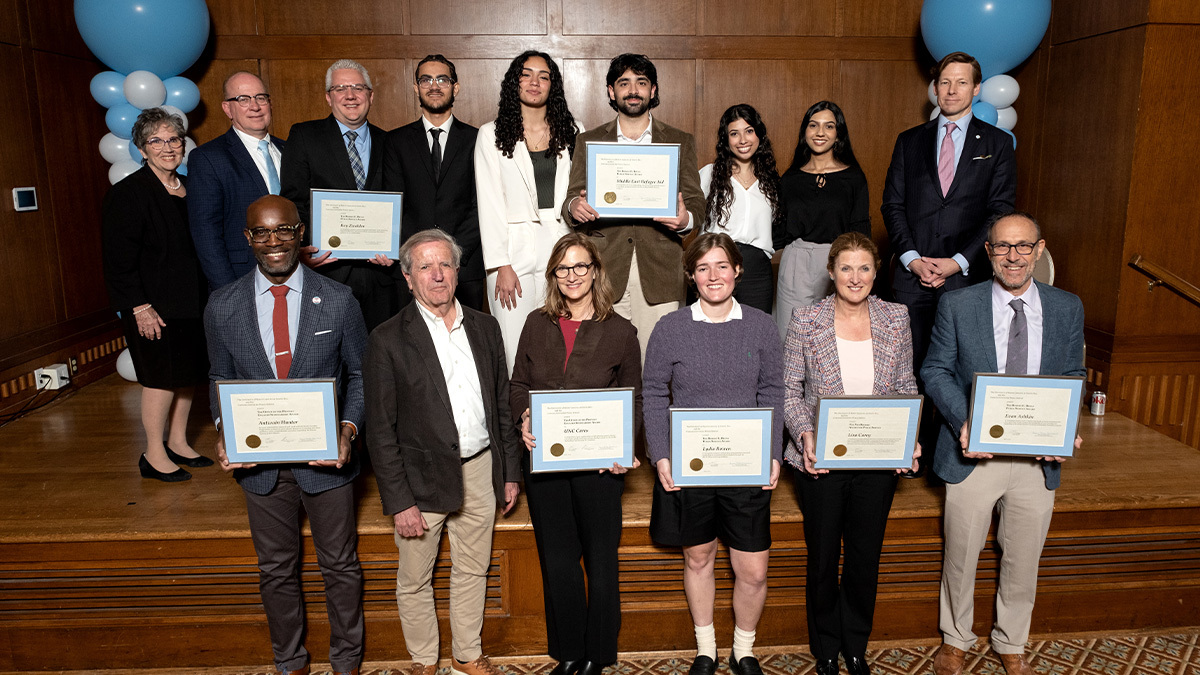
Public Service Awards go to 7 people, 2 groups
The Carolina Center for Public Service honored work on health disparities, refugee aid and more.
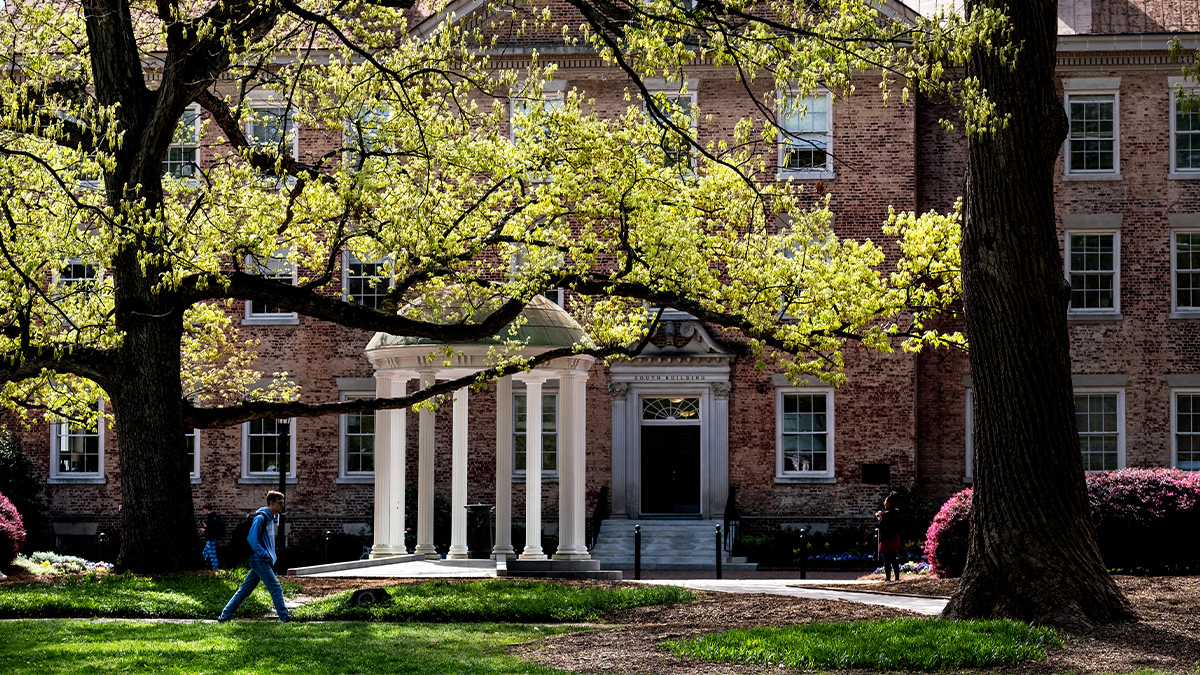
UNC-Chapel Hill graduate programs ranked among best in nation
U.S. News & World Report’s 2024 “Best Graduate Schools” list named multiple Carolina graduate degree programs in the top 10, including UNC Eshelman School of Pharmacy at No. 1.

Broadway writer brings new comedy to PlayMakers
Fresh off the debut of her musical adaptation of “The Notebook,” Bekah Brunstetter ’04 will debut “The Game” in Chapel Hill.

Healthcare Sparks inspires interest in STEM
Medical resident Danae Smart created a program to encourage minority students to pursue health careers.
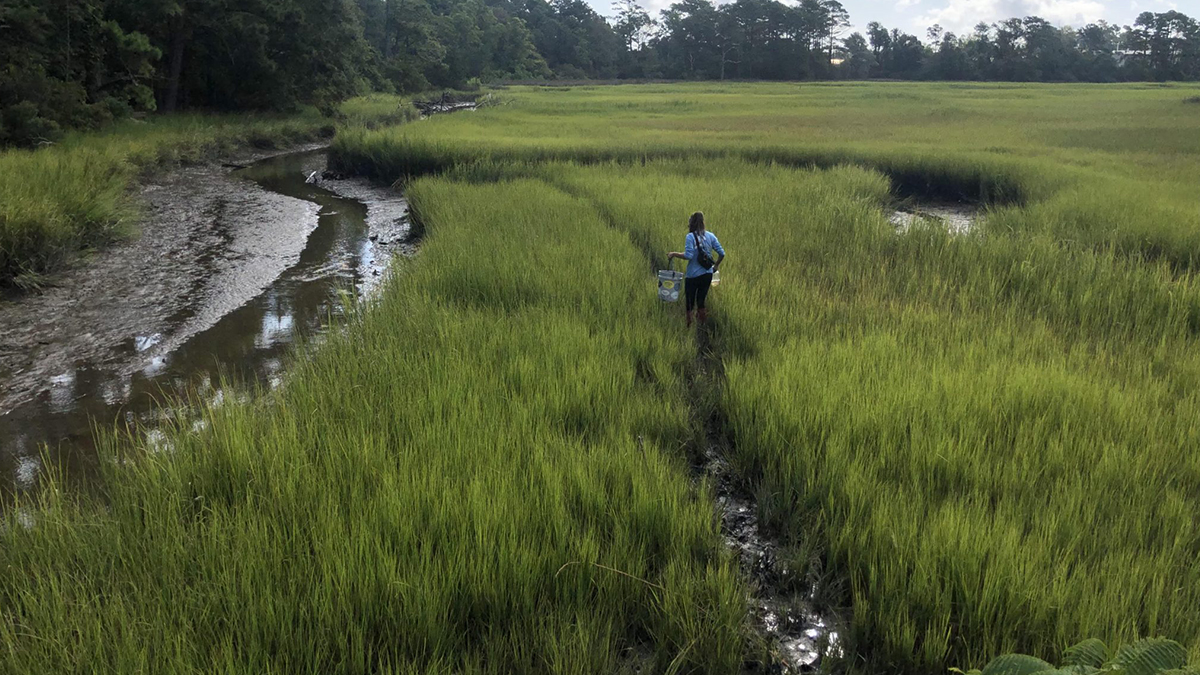
Urban habitats lessen coastal flooding impacts
Lawns and stormwater ponds remove nitrogen and improve water quality, a Carolina study says.
Share on Mastodon

IMAGES
COMMENTS
Explained: All 15 Restricted Area Permits (RAPs) in Nepal for Trekkers, Cost Included 9 2. Manaslu Conservation Area RAP. Required For: Manaslu Circuit Trek, Manaslu Tsum Valley Trek Manaslu region is known to have some of the best natural and cultural delights for visitors of the outside world.
Nepal has the most popular & adventure trek routes besides restricted trekking areas as the country itself is rich in cultural and natural he. Nepal Govt. Reged. number: 39829/2005. Tourism License number: 805/2005 ... the decision to keep some places as restricted area treks in Nepal is a strategic approach to balance tourism, preservation ...
Updated on Mar 22, 2024; A Complete Guide To Restricted Areas and the Required Permits in Nepal. Notice: Nepal bans solo trekking for foreigners, coming into effect from 1st April 2023 Trekking in Nepal is a popular adventure activity from low altitudes to high all with splendid views of the hills and Himalayas. Trekkers can choose the trail according to their interest, physical fitness ...
The restricted zone covers Chumnubri Rural Municipality (All areas of ward nos. 1,2,3 and 4). - Humla: A rugged far-western region in the Himalayas recognized for its untouched nature, ancient culture, and access to Tibet via border crossing. The permit fee is $50 per person per week and $10 per person per day beyond one week across all seasons.
A registered trekking agency is only permitted to trek in restricted areas, and a minimum of two persons are required to get the restricted area permit. The government of Nepal declared 15 areas as restricted areas, and those areas need restricted area permits for trekking.
Post Date: Feb 26 2022 . Restricted Area Treks in Nepal provide unique and remarkable destinations in the less adventure region, around high elevation Nepal Himalayas. Around Nepal, wide scope of beautiful and cultural regions fall inside the confined zone, where guests need to obtain special permits.
Nepal, celebrated for its awe-inspiring landscapes and cultural richness, beckons daring adventurers and curious explorers. While most of the country extends a warm welcome to travelers, there are enigmatic pockets known as "Restricted Areas in Nepal" where accessibility is limited. These elusive zones, though challenging to reach, harbor unparalleled beauty and profound cultural significance.
The Upper Dolpo Trek is a remarkable restricted area trek in Nepal that allows you to discover the remote western Himalayan Mountains. This extensive journey offers insights into the local culture, stunning mountain panoramas, and the serene beauty of nature, including a picturesque lake. The isolation of the western mountains and the ancient ...
Restricted Area Treks in Nepal, provide unique culture and marvelous scenarios of the Himalayas. The Restricted Trek would be a perfect destination for all travelers. There are many restricted treks Around Nepal and find the trek as per your liking. Furthermore, before starting the journey to isolated areas you should obtain the required permit.
List of Restricted Area Trekking in Nepal Upper Mustang Trek. Upper Mustang is one of the most visited restricted regions in Nepal. The jagged mountainous landscape, ancient cultures, and Himalayan view make the area perfect to explore the place. Although the royalty to trek in this area is high, USD 500 per person for the first 10 days and USD ...
Discover restricted areas in Nepal where nature, culture and protection intertwine. Explore unique landscape and lifestyle that define these beautiful regions. For quick Inquiry: +977 98510 42334 . ... Choosing an authorized trekking agency . When visiting restricted areas in Nepal, traveling with an authorized trekking agency like Himalayan ...
Trekking in Nepal's Restricted area is a wonderful way to have an exciting and adventurous lifetime experience for everyone. Until 1991, a couple of portions of the remote zones inside the edge of Asian nations were restricted for the outside guests to shield the normal setting and social parts of the various ranges. The regulation had been ...
Nepal's Restricted Regions are areas that remain relatively untouched, preserving their natural beauty and cultural heritage. These areas require special permits for trekkers, ensuring limited footfalls and a pristine environment. Venturing into these regions is like stepping back in time, where age-old traditions remain intact, and nature unveils its raw, unspoiled beauty. Trekking in areas ...
Nepal is an ideal choice for trekking enthusiasts, offering an array of eye-catching trails that traverse through breathtaking landscapes. Most of the trending trekking trails Everest Base Camp, Langtang are nestled inside the country's precious National Parks and Conservation areas, making trekking permits an essential requirement. Before heading out on a trekking adventure, you must be ...
Trekking in these restricted regions usually requires obtaining a special permit in addition to the standard trekking permits that are required for most treks in Nepal. These permits are issued by the Nepali government and are designed to control the flow of tourists into these areas, in order to minimize environmental impact and maintain the ...
The Adventures in restricted trekking area Nepal, Kanchenjunga Trekking is one of Nepal's most peaceful regions as the trekking trail is comparatively more silent than other trekking trails. It takes you to the height of 5143 meters at the base camp of the world's third-highest mountain but second in Nepal, Kanchenjunga.
It is recommended to hire a registered trekking agency or a guide to assist with your trek and ensure a safe and enjoyable experience. A travel agency looks after all the essential permits required for the trek. Also, for traveling to restricted areas as well as other trekking areas of Nepal, assistance from the travel agency makes it easier.
The most popular restricted trekking region are listed below: Upper Mustang ; The Adventures in a Restricted Trekking Area Nepal, Upper Mustang, known as the "Last Forbidden Kingdom," is located at 3840m and has preserved its own Tibetan culture over the years since its inhabitants have had little contact with the outside world. The area is ...
List of Most Challenging Treks In Nepal Everest Three High Passes Trek - 18 Days . The Everest region is Nepal's most popular trekking destination. It is home to the world's highest mountain, Mount Everest. But it is also home to some of the most challenging and difficult treks in the country.
However, trekking in restricted areas of Nepal brings unique responsibilities and considerations, making it essential for all trekkers to know the relevant dos and don'ts. On the 'Do' side of the equation, trekkers in Nepal's restricted areas must be aware of and adhere to local laws and regulations. To ensure the safety and legal compliance of ...
Upper Mustang is a region located in Nepal's Mustang District, a restricted kingdom until 1992. The region is known as "The Forbidden Kingdom" and is famous for its rich Buddhist culture and monasteries. ... Trekking Routes: The region offers excellent trekking opportunities, with trails leading through picturesque villages, ancient trade ...
The Royal Trek (3-4 days) The Royal hike is one of the shortest and easiest treks in Nepal, the Royal trek follows the same path taken by Prince Charles in the 1980s and takes its name from this excursion. Great for trekkers who have limited time and are looking for a light and easy trekking experience.
Restricted area trek in Nepal is an explore the sites of Nepal and needs special permit +977 9851285888 | +977 9851056547 - Kumar | +977 9813853498 - Sushma [email protected]. Home; About Us. Parikrama Treks Teams and Guide; Company Registration Legal Documents; Nepal. Trekking in Nepal Himalayas.
Restricted Areas Treks. Nepal has much more trekking and adventurous destination. Some are allowed to visit and some are restricted to travelers. In the restricted areas, travelers need to book the trip through the trekking agencies of Nepal those who are registered and affiliated with the Tourism Board. Most of the northern parts of Nepal are ...
As a restricted area, a minimum of two pax is required to obtain a permit for Manaslu with a local agency and guide. If you are an experienced hiker you may travel to Gokyo Valley Trek without joining any agencies. ... New Sticky Thread for posters to add their recent Nepal trip / trek reports. Nepal Destination Experts. NPLGUY. 2,631 forum ...
The post The 10 Best Treks in Nepal's Majestic Mountains 2024 was republished on Passing Thru with permission from The Green Voyage. Featured Image Credit: Shutterstock / Olga Danylenko.
While the amount of data collected on this first trip is vast, additional visits to Nepal are necessary to capture the entire temple. In a planned trip in October 2024, the team will begin expanding the model to include more of the structures located adjacent to the main temple.